Renewable energy




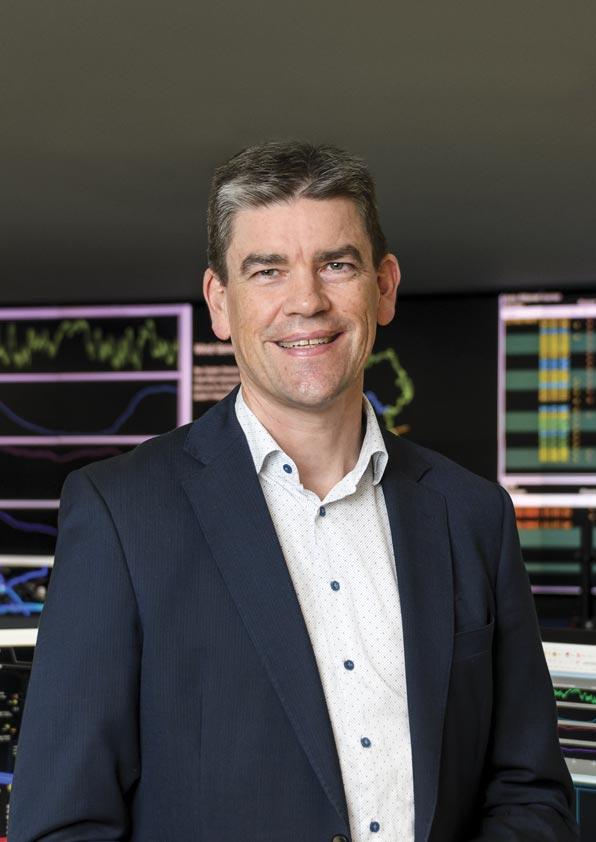
Issue 13 • 2023/2024
Eamon Ryan TD on the long-term vision of Ireland as an exporter of renewable energy
Association’s Charlotte Morton discusses the role of biogas in meeting the Global Methane Pledge
Offshore wind • Bioenergy • Storage • Hydrogen • Solar Ireland’s clean electric future ESB Networks’ Nicholas Tarrant magazine
The European Commission’s Tom Howes discusses electricity market design for future stability
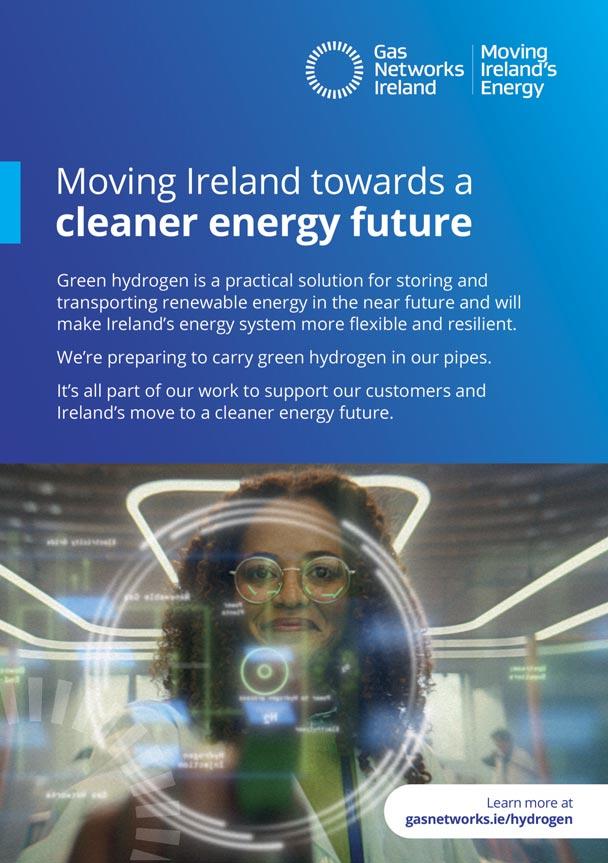



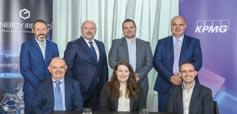




Contents RENEWABLE ENERGY MAGAZINE 04 Climate Action Plan 2023 overview 08 Minister Eamon Ryan TD discusses Ireland’s energy transition 12 Cover story: ESB Networks’ Nicholas Tarrant on driving the electricity network for Ireland’s clean electric future 16 ESRI Senior Research Officer Muireann Lynch on the impact of planning and regulatory delays 24 Overview of the National Hydrogen Strategy 28 Round table discussion: The biomethane opportunity in Ireland 34 DECC Assistant Secretary Barry Quinlan on decarbonising Ireland’s heat demand 44 Head of Energy in Northern Ireland’s Department for the Economy Richard Rodgers on the need for acceleration towards a totally decarbonised energy system 52 MaREI Director and UCC professor Brian Ó Gallachóir on accelerating the energy transition 82 European Commission Bioenergy Policy Officer Biljana Kulišić outlines Europe’s biomethane opportunity 88 Katy McNeil, Head of the Scottish Government’s Ireland Office, explains Scotland’s hydrogen journey 92 Charlotte Morton, Chief Executive of the World Biogas Association, on meeting the Global Methane Pledge 104 Renewable Energy Magazine directory 116 Ryze Ireland Managing Director Catherine Sheridan on establishing the guiding principles to net zero 12 116 92 Editorial Owen McQuade David Whelan Ciarán Galway Fiona McCarthy Odrán Waldron Joshua Murray Design Gareth Duffy Jamie Hogan Advertising/Commercial Sam Tobin sam.tobin@energyireland.ie Publishers Energy Ireland www.energyireland.ie info@energyireland.ie @energyireland Dublin office: Clifton House Lower Fitzwilliam Street Dublin 2, D02 XT91 Tel: 01 661 3755 renewable energy magazine 1 16 28 08 Hosted by KPMG












































































































































































































































































































































































































































































































22 & 23 May • Croke Park, Dublin 2024 For more information +353 (0)1 661 3755 • www.energyireland.ie • info@energyireland.ie Sponsorship opportunities available Save the date!
Expanding the renewable mix…
Ireland’s decarbonisation transition is predicated on the heavy lifting being done by wind energy, both onshore and offshore, but the implementation of carbon budgets and sectoral emissions ceilings has offered a firm insight into the necessity of those technologies previously regarded as being on the fringes.
Climate Action Plan 2023 (CAP23) has set some ambitious targets for the acceleration of renewable generation out to 2030, perhaps best illustrated by the shift from a solar energy target of 1.5GW in CAP21 to 8GW in CAP23, but it also implements the first binding carbon budgets and sectoral emissions ceilings.
Early analysis shows that the State has spent almost half of its carbon budget in the initial two years of the first five-year period, necessitating a significant reduction in carbon emissions over the remaining years.
Clearly, the realisation of net zero ambitions will require a rapid acceleration of renewable energy technologies, spearheaded by renewable electricity to assist with the electrification of heat and transport.
The provisional results of RESS 3, which point to a lower volume of renewable energy and higher prices than the previous auction, highlights that more needs to be done to facilitate this acceleration, particularly in relation to planning delays.
However, decarbonisation requires more than renewable generation at scale, it requires a diversity of technologies, the upgrading of infrastructure, and system flexibility. Biomethane, for example, now has an elevated role reaching those hard to abate sectors. Solar PV and storage are recognised not only as a source of renewable electricity, but as a key enabler of consumers, industry, and agriculture to play their part in the transition.
Crucially, these ‘fringe’ technologies are now being advanced in recognition of their role in ensuring security of supply.
Enabling as many people as possible to play a part in the transition will be crucial to not only ensuring demand-side flexibility but also driving a mindset shift to reduce consumption, another necessary requirement that has been made evident from analysis of carbon budget performance to date.
The 2023/2024 edition of the Renewable Energy Magazine explores in detail the role of renewable energy in Ireland’s decarbonisation journey so far, and the technologies and policies driving the net zero agenda.
Aptly, in the context of the acceleration of renewable generation, and the requirement for demand-side flexibility, our cover story interview with ESB Networks’ Nicholas Tarrant discusses the delivery of an electricity network for Ireland’s clean electric future. Other highlights include KPMG’s round table discussion with key stakeholders on the future role of biomethane, and we have expert analysis of the short, medium, and long term outlook for renewable energy across the island.
David Whelan, Editor

3 renewable energy magazine
CAP23 ups the ante for renewable energy
The Government
goals for electricity decarbonisation
the Climate Action Plan
Electricity
The most notable of CAP23’s targets in terms of the decarbonisation of electricity comes in the form of increased ambitions for the deployment of renewable energy generation that will “strengthen the electricity grid and meet the demand for flexibility”. As part of these measures, the Government has increased its aim for the proportion of renewable electricity to 80 per cent by 2030; the 2021 Climate Action Plan (CAP21) had previously aimed for “up to 80 per cent where achievable and cost effective, without compromising
security of electricity supply”, meaning that what was once seen as a maximum is now the minimum target for the Government.
Sustainable Energy Authority of Ireland (SEAI) data shows that the Government’s target of 40 per cent by 2020 was just narrowly missed, with renewables accounting for 39.1 per cent of electricity generation in 2020, but that the 2020 proportion then fell in 2021, the latest year for which full data is available, with renewables accounting for 36.4 per cent of electricity generation. This means that the State’s
proportion of electricity coming from renewable sources would need to more than double from 2022 to 2030.
The Government’s aim to reach such a revolution in renewable energy production is to be powered by increasing ambitions in various forms of renewable generation:
• the aim for onshore wind capacity by 2030 has been raised to 9GW, from “up to” 8GW in CAP21;
• 7GW of offshore wind is aimed to be developed by 2030, with 2GW dedicated to green hydrogen

4 renewable energy magazine
once again increased its
with the publication of
2023 (CAP23). However, doubts remain as to whether or not the new goals are achievable.
production, this target retains the CAP21 target of 5GW – although it adds the caveat “at least” – of offshore wind production of electricity and adds the 2GW specific to hydrogen; and
• 8GW of solar energy will be produced by 2030, a significant increase from the targets set out in CAP21, where between 1.5GW and 2.5GW were aimed at for 2030.

Published in September 2022 in the run up to the publication of CAP23, the Government’s Sectoral Emissions
Ceilings set out an aim of circa 75 per cent reduction in electricity emissions by 2030, with CAP21 having contained a guiding agreed range of between 60 per cent and 80 per cent when compared with 2018 levels of emissions. In June 2023, the Environmental Protection Agency (EPA) warned that “increased renewable energy generation, from wind and solar, if delivered as planned, can reduce energy industry emissions by 60 per cent”, although the EPA did also state that the goals would achieve the 80 per cent renewable electricity generation target by 2030.
The EPA notes that the continued dependence on coal due to the unavailability of gas-fired generation due to the Russian invasion of Ukraine and the slow implementation of renewable electricity targets has “undone some of
the good work of recent years”. Such ‘good work’ as carried out under CAP21 is listed in CAP23, including: 2022 being a record year for connection of renewable electricity to the grid; the enactment of the Maritime Area Planning Act 2021 and the creation of the Maritime Area Consent regime; 1,836MW of renewable generation through the RESS 2 auction, which represented an increase of almost 20 per cent in Ireland’s renewable electricity generation capacity; and the connection of the first grid-scale solar project to the grid.
CAP23 outlines plans to have the renewable electricity share up to 50 per cent by 2025 as a steppingstone to 80 per cent by 2030, with onshore wind and solar to have capacities of 6GW and “up to” 5GW respectively by 2025. The plan also calls for demand side flexibility to be between 15 per cent and 20 per cent by 2025 as Ireland builds toward 30 per cent by 2030.
CAP23 lines out three themes to deliver abatement in electricity: accelerate renewable energy generation; accelerate flexibility; and demand management. Cumulatively, these three themes will deliver an abatement of 9.56 MtCO2eq by 2030 if key performance indicators (KPIs) are met. These KPIs include the capacity generation and demand flexibility goals mentioned above, the
production of green hydrogen from surplus renewable electricity, the putting in place of required long-term storage, zero-emission gas-fired generation from biomethane and hydrogen commencing by 2030, and a rate of renewables ongrid at any one time of between 95 per cent and 100 per cent being achieved.
Associated actions included in CAP23 for the achievement of such KPIs include some already achieved, such as the establishment of the Maritime Area Regulatory Authority and the completion of the Offshore Renewable Energy Development Plan. The plan contains 27 actions for 2023 relating to electricity, including the completion of new analysis by EirGrid in order to update Our Electricity Future to accommodate the new target of 80 per cent renewables.
Heat
Two of the three key targets in CAP23 relating to industry come under energy usage: the drive towards achieving between 70 per cent and 75 per cent carbon neutral heating by 2030 and a 10 per cent reduction in fossil fuel demand by 2030 through energy efficiency. The plan states that the Government plans to provide carbon-neutral heat for industry through high efficiency heat pumps powered by renewables for low and medium temperature heating, while indigenously produced biomethane and
5 renewable energy magazine 4
green hydrogen (in the longer term) will power high temperature heat demands. Industrial heat and processing is named as the fourth priority usage for hydrogen in the National Hydrogen Strategy, published after CAP23, with the likely market energy timeframe given as 2030-2035.

SEAI’s Energy in Ireland 2022 report identifies that fossil fuels are the heat source in 73 per cent of the State’s dwellings and the built environment section of CAP23 attempts to get to grips with this, detailing government plans to have up to 0.8 TWh of district heating installed capacity by 2025, due to rise to 2.7 TWh by 2030, to have 170,000 new dwellings using heat pumps by 2025 and 280,000 by 2030, and to have 45,000 existing dwellings doing the same by 2025 and 400,000 by 2030. Also notable is the plan to have “up to” 0.4 TWh of heat provided by renewable gas by 2025, rising to 0.7 TWh by 2030. Under the National Retrofit Plan, 500,000 dwellings should be retrofitted to BER B2 cost optimal or carbon equivalent by 2030, a move that, along with the 400,000 heat pumps to existing dwellings, would abate 2 MtCO2eq.
Transport

CAP23 notes that 20.2 per cent of transport’s first sectoral carbon budget (lasting until 2025) was expended in 2021, a figure that would be consistent with compliance were it not for the fact that finalised 2022 figures are expected to report a further increase in transport emissions. The plan states that fleet electrification and the use of biofuels will “provide the greatest share of emissions abatement in the medium term” for one of the most difficult-to-decarbonise sectors.
Of the 6.08 MtCO2eq of transport emissions the Government plans to have abated by 2030, electrification and vehicle technology coupled with biofuels make up 5.82 MtCO2eq. By 2030, the Government plans to have 845,000 private EVs, 1,500 EV buses, and 95,000 commercial EVs on the roads, along with a biofuel blend rate of E10:B20, meaning a blend of up to 10 per cent of bioethanol in petrol and 20 per cent of biodiesel in diesel. CAP23 also contains a commitment to study opportunities to “broaden supply of a more diverse range of renewable transport fuel types and feedstocks – in particular, the supply of advanced biofuels and renewable fuels of non-biological origin”.
While CAP23 does not contain much with regard to the use of hydrogen in transport, the National Hydrogen Strategy has since ranked road and rail transport as the seventh priority area for hydrogen, specifically for road transports “requiring long duty cycles and longer distances” and for rail “where electrification [is] not feasible/or as a backup”.
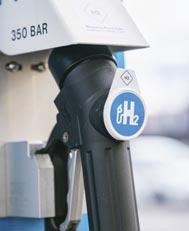
6 renewable energy magazine
Headwinds and tailwinds on the journey to 80 per cent by 2030
priorities would support necessary grid development.
Planning
• introduce clearly defined realistic timelines for planning decisions and response times from statutory consultees;
• introduce an oversight function to measure performance by local councils and Department for Infrastructure of KPIs set against statutory targets; and
• increase resource at local council and Department for Infrastructure levels to cope with expected increased demand for applications and create a central pool of resource to be deployed to areas of high demand.
Route to market
• publish timeline for implementation of support scheme;
• no mandatory participation in any new support scheme so that investors/generators have flexibility around investment models; and
The renewables sector in Northern Ireland is facing serious headwinds. That is not news to anyone working in the sector over the past six years or so. It is striking though that only 30MW of additional renewables capacity was added last year, compared to up to 400MW annually in the period of peak development to 2016.
A recent report commissioned by Renewable NI, the industry body, and produced by KPMG, confirms that Northern Ireland will struggle to meet the target set for renewable electricity generation without significant reform.
The factors contributing to those headwinds are grid capacity for both new and existing assets, the absence of a support scheme for new projects and the planning system, notably timelines in progressing applications and inconsistencies in decision-making across councils. Again, these factors are well known to the industry and should be well known to policymakers.
The report concludes that, based on our current regime, it will simply not be
possible to achieve the target, set by the Northern Ireland Executive just before it collapsed in 2022, of 80 per cent renewable electricity consumption by 2030. It makes a variety of recommendations garnered from consulting with stakeholders about how the deployment of renewables might be accelerated, including:
Grid
• anticipatory investment in grid network so that capacity is available for new projects ahead of time could significantly decrease overall deployment times;
• closer collaboration between NIE and industry to enable considered planning for future demand in terms of project location and scale;
• incentivising the development of generation close to areas of high demand would facilitate reduced costs and facilitate more rapid development of the network; and
• empowering the Utility Regulator to consider environmental and climate
• fast tracking of new renewables projects through planning and grid to allow participation of new projects in initial auctions.
The sector rose to the previous challenge set by government achieving the 40 per cent target ahead of the 2020 deadline. Let us hope that a functioning Executive resumes and acts as the tailwind to facilitate successful achievement of the 2030 targets.
If you have any queries relating to any this article or for more information on Carson McDowell’s renewable energy team and experience, please contact Neasa Quigley, Head of the Energy and Renewables team.

E: neasa.quigley@carsonmcdowell.com
W: carson-mcdowell.com
7 renewable energy magazine
Significant reform is required if Northern Ireland is to meet the target set for renewable electricity consumption by 2030, writes Carson McDowell’s Neasa Quigley.
energy transition
The Minister, who at the time of speaking had just returned from the African Climate Summit, speaks of the changing landscape of global politics, outlining that national leaders in Africa and China are now fully “bought into” the need for action to address the climate crisis.

“When it comes to renewable energy, the Chinese are racing ahead. They will be producing 200GW+ of solar power this year; the United States’ total solar capacity is 140GW, to put that into perspective. The Chinese are planning the triple the production of polysilicon over the next few years.”

Ryan states that the reason for this global shift is that “technology is evolving, particularly with photovoltaic and wind technology”. “The industrial revolution is with us; it is happening, and it is accelerating.
“The war in Ukraine,” he asserts, “is making these developments accelerate at an incredible speed. We in Ireland have to understand that and fit in to that wider context to be in the right place and thinking ahead.”
EU leadership and collaboration
Rationalising his government’s approach to energy policy, Ryan says: “We are positioning ourselves as green, renewable, electrified, sustainable, and low carbon in everything. That fits in with the EU’s ideal, the Commission has shown real leadership. The renewable strategy is the Green New Deal, and we risk falling behind unless we are really strong on that because all the technology will otherwise all come from China and America.
Eamon Ryan TD, outlines Ireland’s place in the global energy transition and how he believes it will enable the State to be a major exporter of renewable energy.
8 renewable energy magazine
Minister Eamon Ryan TD: The
Minister for the Environment, Climate and Communications, Eamon Ryan TD
“Our whole political focus now is on doing it quickly. We have 20 pieces of legislation in the Fit for 55 agenda, we have got through 19 of them, meaning that they are all deliverable now through directives and regulations, so there will be no going back.
“The fundamental direction we are on is strong and set. It is a direction which I do not see changing, no matter who is in the next government in Ireland or who is in the next European Commission.”
Hydrogen challenges
Speaking shortly after the Government’s publication of the National Hydrogen Strategy, the Minister alludes to how green hydrogen will play a “vital role” in Ireland’s energy system, but also states that there are challenges “on the technological side” that mean the State remains “a while off” from successfully producing mass quantities of green hydrogen.
“There is loads of hydrogen being used at the moment, but it is fossil hydrogen. Switching to green hydrogen is going to be the real challenge. Everyone in the world is looking at it, particularly our colleagues in Britain and in Germany, but also in the United States and elsewhere.
“The scale of investment and the scale of commitment we are seeing globally gives me the certainty to say that this will definitely come.”
Speaking on the recently signed memorandum of understanding between Germany and Ireland on the development of hydrogen, the Minister says: “The German estimate is that
around 550 TWh will be needed by 2045, and one of the main sources for that will be from renewable power.
“We are talking about hundreds of GW, particularly from offshore wind. This is the sort of scale, along with solar, which will give us the capability of giving us the opportunity to produce hydrogen in such big numbers.
“We will have a surplus of renewable electricity by the end of this decade. But by the next decade, in 2035 and 2040, as we roll out solar and offshore wind at an even bigger scale, we will be converting that electricity surplus into hydrogen.”
In spite of his optimism for Ireland’s high amount of scope for development, Ryan cautions that “we need to be careful about some false narratives with hydrogen”.
“I do not think it is going to be at the distribution level. I do not see blending as the key into the system. It is going to be the intense, high-level, industrial uses which will be the first applications which will come,” he says.
Biomethane ‘tried and tested’
Although Minister Ryan believes that “we have to be willing to invest in both anaerobic digestion and hydrogen from the public sector to help overcome some of the initial capital hurdles,” he stipulates that biomethane is better understood and a more viable immediate term solution as it is “already tried and tested”. “Its problem is not around technology or application, it is about optimisation,” Ryan says.

9 renewable energy magazine 4
“The fundamental direction we are on is strong and set. It is a direction which I do not see changing, no matter who is in the next government in Ireland or who is in the next European Commission.”
With the Green Party leader confirming that the Government will soon be publishing its biomethane strategy, Ryan states: “We estimate that we can develop something like 5.7 TWh from biomethane by 2030.
“Our climate laws say we have to reduce emissions by 51 per cent by the end of this decade. We have seven more years, and we then have to go to net zero by 2050. That is a really challenging target.
“We will do this in two key fundamental ways. The first thing is that we reduce demand, reduce the use of gas dramatically as we have seen be done in Denmark. 85 per cent of our gas is going to power generation, to make the electricity and industrial use. 15 per cent is domestic. In that 85 per cent, it is going to be renewable electricity, onshore wind, offshore wind, solar, battery storage, and interconnection which powers our country by 2050.
“We will have a massive surplus; we will be interconnected with the UK and with
France, Spain, and the rest of the continent so that we have a balancing capability in the characteristics of the industrial revolution, balancing variable renewable power supply and variable demand.”
Changing the energy sector
Although Ryan views the development of biomethane and hydrogen as highly promising, he states that, in decarbonising industry, “all the lower heat demand sectors, such as dairy, will switch from fossil gas to heat pumps, rather than renewable gas”. “That takes out a good chunk of the 85 per cent which is used in power and industry. It is the area which remains that we can target to develop biomethane to meet our needs of a sustainable and industrial future.
“Reducing energy demand,” Ryan believes, is also key to ensuring that Ireland is enabled to reach its Climate Action Plan targets and complete its energy transition.
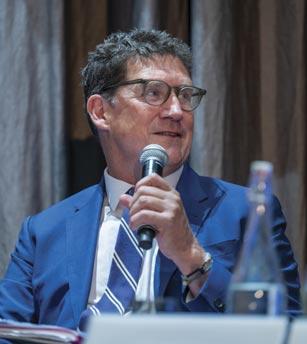
“The technology is leading us in this direction and solar and wind are cheaper and better, more secure, and it is going to take out the need for gas. In the short term, we will still need gas and we are producing an extra 2GW of gas in order to have the level of flexibility we need. By 2050, that gas will be gone as we switch to this new system. Similarly, industrial heat pumps have a key role to play because they are better technology, and they have 300 or 400 per cent gains in efficiency.”
Citing analysis by EirGrid, Ryan states: “On our existing plans, which we are going to deliver, 5GW of offshore wind will be delivered. This is already being done in the Irish Sea and in the west. It is coming.”
He adds: “Solar is already taking off, just as an example of this revolution, solar is taking off at a speed which nobody could have expected. By the end of this decade, we will have 13 TWh of surplus electricity that we will either have to spill or alter our demand system so that we are using power and using energy at the time when the surplus of renewable electricity exists.
“One of the real potentials is to convert it to hydrogen for use in a whole range of applications that will be the applications that are hard to reach with technology such as heat pumps, EVs, batteries, or other renewable electricity systems. There will still be a lot of that, we still want industry.”
Stating that the energy sector is “at the front line in addressing this climate crisis which is the greatest challenge of our time”, Ryan concludes: “We can provide prosperity and security for our people as we reach these solutions. It will not work by finger wagging, blaming, or telling the other person that they are the problem. It will work by switching to a better system; an energy system which is more secure because it relies on resources which are ubiquitous and which every country has access to, and which can be shared. A renewable system will give us security and prosperity.”
10 renewable energy magazine

Delivering the electricity network for Ireland’s clean electric future
strategy in January 2023, Managing Director of ESB Networks, Nicholas Tarrant, talks to David Whelan about the organisation’s central role in the energy transition.

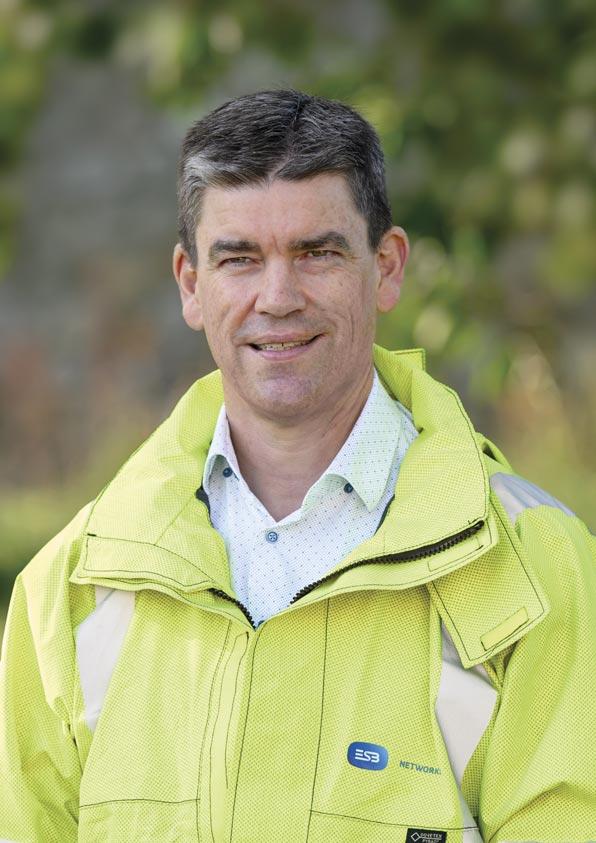
12 cover story
“Our purpose in ESB Networks has always been to connect and distribute electricity safely and securely,” explains Tarrant. “But, by acknowledging the central role that electricity plays in climate action, our purpose has evolved to deliver a clean electric future through the electrification of heat, transport, and industry, as well as connecting renewable generation at scale to the electricity network.”
The Managing Director is speaking in the context of “stretching” targets set out in the Government’s Climate Action Plan 2023 (CAP23), which puts ESB Networks’ purpose at the centre of delivery of the sustainable social and economic development of communities, businesses, the country’s climate action response, and the transition to net zero.
As a commercial semi-state company regulated by the Commission for Regulation of Utilities (CRU), ESB Networks has responsibility for operating, maintaining, and building the distribution network as the electricity Distribution System Operator (DSO), Distribution Asset Owner (DAO), and onshore Transmission Asset Owner (TAO).
Tarrant explains that the new Networks for Net Zero strategy sets out ESB Networks’ role in enabling the delivery of CAP23 and supports the decarbonisation of electricity by 2040, key to the achievement of Ireland’s net zero ambition no later than 2050.
“Through our strategy, we are setting out a clear objective to develop a resilient electricity network that is flexible and smart, and will provide a foundation for a clean electric future in Ireland by 2040,” he states.
While the remit of ESB Networks in the decarbonisation of electricity generation, heat, and transport is large, the ambitions of the strategy are succinctly outlined within three core pillars of: decarbonised electricity; resilient infrastructure; and empowered customers.
Decarbonised electricity

Enhancing the role of electrification to decarbonise Ireland’s economy is reliant on a foundation of an electricity network that facilitates and distributes rising levels of renewable energy. In 2022, ESB Networks connected a record 688MW of wind and solar generation projects.
However, Tarrant explains that well in excess of that number will be needed
year on year, adding that ESB Networks is striving to play its part in the connection of 22GW of renewable generation by 2030.
“As the electricity system transitions towards a smarter, sustainable model, the operation and management of intermittent and renewable generation, coupled with new types of demand, will require a digital network that is both flexible and smart,” he states.
CAP23 sets out targets of 9GW of onshore wind, at least 5GW of offshore wind (including an additional 2GW of offshore wind for green hydrogen production), and 8GW of solar connected to the electricity system by 2030.
Highlighting the breadth of ESB Networks’ work in delivering a decarbonised electricity network for the future, the Managing Director points to its role in building the transmission projects onshore to facilitate offshore wind projects, and the increased connection of microgeneration. ESB Networks is also working to grow the electricity network to enable the expansion of electric public charging infrastructure to 20 times its current capacity in order to comply with EU regulations by 2030.
Outlining some of the successes to date, enabled by a 60 per cent rise in capital investment through the regulated price review for the period 2021 to 2025 (PR5), Tarrant says: “Last year, we connected a record 688MW of wind and solar projects to the network, however, significantly in excess of that will be needed every year out to 2030 if we are to make net zero a reality.
“We are also managing significant
growth of microgeneration. Currently, we have over 68,000 individual connections to rooftop solar, and those connections are growing at a rate of approximately 700 per week. In 2022, approximately 95MW was added to the network through projects classed as small-scale generation and below, (these are projects below 200 kW in size) which is a significant number when added to the 688MW also generated by large scale projects.
“This year, we expect to double that figure to reach 200MW, showing that we are managing the connection of microgeneration on rooftops right through to the large scale generation.
“To continue this progress, a growing programme of investment is needed to facilitate the increased connection of renewable generation to the network both on the transmission and distribution sides. In this regard, our upcoming Price Review 2026 to 2030 (PR6) is of critical importance, and we will continue to work with the CRU and our wide range of stakeholders to ensure continued momentum to achieve net zero.”
Resilient infrastructure
Ensuring that the electricity network has the capacity to connect and accommodate renewables, as well as serve the demand growth driven by projected population growth, and demand increase due to the electrification of heat, transport, and industry, is a key consideration for ESB Networks.
Tarrant explains that major investments are being made in network infrastructure at all voltage levels, 4
13 cover story
alongside the development of new tools and procedures to enable the use of new innovative technologies.
Key to managing these shifting demands is the building into the network of demand flexibility. The Networks for Net Zero strategy sets out a target for ESB Networks to manage 20 to 30 per cent of all electricity demand flexibly by 2030, with a 2025 target of 15 to 20 per cent, in line with CAP23. Tarrant points to the establishment in 2020 of the National Network, Local Connections (NN,LC) Programme, aimed at supporting the reduction in peak electricity demand and putting measures in place to improve electricity demand management, as key to future progress.
Outlining ESB Networks’ recognition that the continued partnership approach between the transmission and distribution system operator will be required to deliver an “optimal wholeof-system” solution, he explains: “As dependence on the electricity network increases, the quality, condition, and performance of the network will become increasingly important.

“We will continue to adapt and strengthen our network so that we can collectively transform our energy future and improve the resilience of the
network from the risk of extreme weather events and cyberattacks.”
The Networks for Net Zero strategy adopts a ‘build once for 2040’ concept, which Tarrant explains will see ESB Networks anticipate the needs of customers in 2040, and beyond, as electricity demand growth accelerates with the electrification of heat and transport. The proposed development of renewable hubs is set to explore advance build network reinforcements, increasing customer engagement to provide guidance on different pathways for connecting renewables.
Empowered customers
Tarrant stresses the importance of the design of Networks for Net Zero as a customer-centric strategy. Discussing the ‘empowered customers’ pillar, he says: “The way in which customers engage with the electricity network, and electricity in general, is changing rapidly, as shown by an uplift in the volume of people electrifying their transport, their heat, and availing of time-of-use tariffs.”
The public support for climate action is vital for this transition and Tarrant stresses the importance that ESB Networks delivers on the trust that has been placed upon it to connect, distribute, and build an electricity network that will meet future demand. This includes a target to connect up to
one million EVs and 680,000 heat pumps to the distribution system by 2030.
“Our commitment is to connect our 2.4 million customers with a great experience through proactive engagement, and by consciously placing their needs at the centre of everything we do,” he says.
“That also means enabling new opportunities for our customers to take part in the energy transition through selfgeneration and storage, demand management, energy efficiency opportunities, and selling electricity by exporting back onto the electricity network.”
Major progress in empowering consumers by ESB Networks can be seen in the roll-out of over 1.4 million smart meters to Irish homes through the National Smart Metering Programme, with Tarrant indicating a current instalment rate of some 10,000 per week.
“Alongside the instalment of meters, we have launched a new customer online account to enable customers to have access to their data, to be able to share it. The ESB Networks online account offers a range of digital services to empower customers with self-serve options such as applying for a new connection, finding their MPRN and learning about their energy consumption.
14 cover story
Economy
ESB Networks plays a large role in Ireland’s economic future. The organisation, which employs 3,600 people and has more than 1,000 Irish suppliers, invested €869 million in 2022 across all of its work programmes with the investment expected to grow to over €1 billion per year.
Alongside a key role in helping to deliver the Government’s energy policy ambitions, it is also a key enabler of other policies such as the Housing for All programme, facilitating a 36 per cent uplift in new connection requests in 2022.
Tarrant explains that ESB Networks is continuing with an intensive recruitment process of skills at all levels of the organisation, including the doubling of its apprenticeship intake to almost 100 in 2023, and the expansion of its contractor base.
On the challenges facing ESB Networks, Tarrant says: “We are coming from a good place in that there are very clear government targets set out in CAP23, and our ambitions were supported by an uplift in capital resources in PR5. For the second half of the decade, PR6 will be very important but we are already working to address those longer-term challenges we foresee, for example, through recruitment and ensuring we have the right skills to meet future demand.
“We are also working closely with our contract partners to ensure that they have sight of the long-term vision and can see the work programmes in front of them, which allows them to ensure they have the correct resources in place to deliver for the country.”
Nicholas Tarrant, Managing Director, ESB Networks

The Managing Director believes that proactively addressing future challenges will mean that ESB Networks, and ultimately, Ireland, will be able to stay ahead of the global competition for skills, resources, and supply chain.
“We know that change is happening at pace, and we are evolving our business processes, systems, and ways of working in anticipation of future network requirements,” he outlines.
Tarrant stresses the importance of ESB Networks’ flexibility and agility in the coming years to build resilience against any shocks, but also create space for new innovation and policy shifts. During PR5, major changes in policy, and therefore ESB Networks’ operating environment, included the EU’s REPowerEU strategy, the National Energy Security Framework, and CAP23. Praising the agile investment framework built into PR5, he expects a similar measure to be utilised in the
second half of the decade to enable ESB Networks to best meet the needs of customers in a dynamic environment. Concluding with his vision for what the success of the Networks for Net Zero strategy looks like, he says: “We must deliver, each year, on our commitments to make net zero a reality for the country. However, in a changing environment, we must also have the ability to be flexible. What is fundamental to our history as a company and for our future is customer service, and our aim is to support and enable customers to make this transition by delivering the electricity network for everyone’s clean electric future.
“Ultimately, for the transition to a net zero society no later than 2050, we need to ensure a net zero ready distribution network by 2040,” he states.
Profile: Nicholas Tarrant
Nicholas Tarrant was appointed Managing Director of ESB Networks in September 2021. Prior to this, he held the positions of Executive Director, Engineering and Major Projects and Managing Director, NIE Networks. He has held a number of senior management positions including Generation Manager with responsibility for ESB’s generation portfolio. He is a chartered engineer at the Institute of Engineers of Ireland, a Chartered Director and holds an MSc (management) from Trinity College Dublin (TCD).
15 cover story
“We know that change is happening at pace, and we are evolving our business processes, systems, and ways of working in anticipation of future network requirements.”
The impact of planning and regulatory delays
Economic and Social Research Institute (ESRI) Senior Research Officer Muireann Lynch discusses the cost of planning and regulatory delays for the energy system.
Contextualising her research, Lynch explains that the idea for the ESRI’s paper investigating the cost of planning and regulatory delays for the energy system was stakeholders querying losses incurred in the time it takes to get energy projects connected to the grid and generating power. Lynch and her colleagues analysed electric renewable energy (RES-E) projects due to such projects being a “major pillar of energy policy, both in terms of decarbonisation and of increasing security and affordability”.
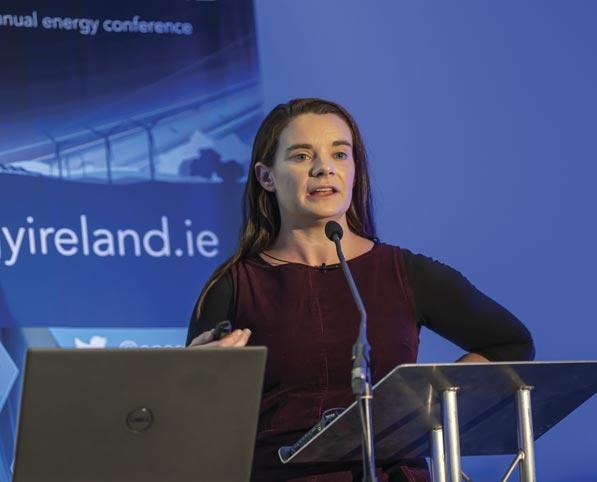
16 renewable energy magazine
“RES-E projects face various planning and regulatory hurdles; you have to get over various jumps before you finally get your project onstream,” Lynch says. “Once you have got your planning permission, you are looking for grid connection, once you have that, you are often looking for subsidy support. The literature would suggest that delays impact on delivery and these issues are not unique to Ireland. Furthermore, there is anecdotal evidence of delays in the Irish system in terms of getting projects delivered.
“On that basis, we had a couple of research questions: what impact do the delays and regulatory setup have on delivery timelines? What are the knock-on impacts on the power system?”
The roles of various organisations had to be factored into this research, as Lynch explains. Firstly, planning permission must be obtained through the relevant local authority and/or An Bord Pleanála. The planning authorisation cycle is continuous, with a targeted decision time frame of 18 weeks, although the average time frame is 37 weeks. Grid connection is governed by EirGrid and ESB Networks, with a yearly authorisation cycle requiring applicants to enter in September of every year and a decision time frame of 12 to 15 months. Generation licenses and authorisations to construct are granted in a continuous cycle by CRU. The RESS scheme operated by the Department of the Environment, Climate and Communications makes yearly awards with a decision time frame of three months, and the Department of Housing, Local Government and Heritage’s authorisation cycle for foreshore licensing and leasing is continuous, with a decision time frame of 18 weeks.
“We want to consider the impact of these decisions being made faster if the time to get planning permission was reduced and also if there were an increased number of opportunities to apply for grid connection and RESS,” Lynch says, explaining the terms of the research. “We are going to track 2,000MW of approved capacity that will eventually overcome these hurdles and get built. The only question here is when this capacity will get on the grid, not if it will.”
Accordingly, the ESRI constructed a number of scenarios (as seen in Figure 1), where various possibilities were considered, such as the reduction of planning decision time to 25 weeks and the targeted 18 weeks, and increases in both RESS and grid offer opportunities per year from one to two.
“This is a linear least cost optimisation model which determines the socially optimal generation and transmission expansion assuming a benevolent social planner with
“These delays are not costless, they are having power system impacts. Increasing the number of opportunities and reducing An Bord Pleanála’s timelines would both be helpful.”
17 renewable energy magazine 4
Muireann Lynch, Senior Research Officer, Economic and Social Research Institute
perfect foresight,” Lynch says, surveying the results of the scenarios examined (see Figure 2 and Figure 3). “Years one, two, and three see nothing built in any model, and in year four there was no difference between them. From years five, six, seven, and eight, we were seeing up to a 3.3 per cent decrease in system costs just from those 2,000MW getting on those few years earlier.
The research shows a possible reduction of up to 4.2 per cent in CO2 emissions with the capacity being installed in year five, a possibility made all the more important, Lynch says, “now that we are in the era of carbon budgets” due to the fact that “if you get that the 2,000MW on by year eight, you still have the extra cumulative emissions from the power system in the meantime”.
It is on price where the biggest impacts of these imagined reforms would be felt, with a decrease in marginal price of 9.9 per cent with the capacity delivered in year five and 7.3 per cent if it were to be delivered in year six. “There is a big impact on the difference in price getting those megawatts on those few years earlier. That can make an impact on marginal prices,” Lynch says, before offering another key footnote: “All of this was run pre-the Ukraine crisis, so if we were to re-run this under the higher fuel prices we see now, we would expect the price decreases to be bigger again.”
Planning delays undoubtedly have an impact on RES-E rollout, Lynch says, and by providing further resourcing for An Bord Pleanála and/or allowing more opportunities per year to apply for grid connections and RESS, the process can be sped up “considerably”.
Concluding, Lynch states that taking on either approach would tackle the costs and increased emissions incurred by such delays: “What I was surprised at was the impact of those delays on the costs, emissions, and particularly prices. These delays are not costless, they are having power system impacts. Increasing the number of opportunities and reducing An Bord Pleanála’s timelines would both be helpful.”
18 renewable energy magazine
Y4 Y5 Y6 Y7 Y8 System cost 0.0% 0.3% -3.2% -3.3% -0.6% CO2 emissions 0.0% -4.2% -3.4% -1.0% 0.0% Marginal price 0.0% -9.9% -7.3% -0.6% 0.0% Status quo ABP#1 ABP#2 Grid offer Hybrid RESS Combined Weeks to ABP decision 37 25 18 37 37 37 18 Grid offers per year 1 1 1 2 n/a 1 2 RESS offers per year 1 1 1 1 1 2 2 Hybrid No No No No Yes No No Status quo ABP#1 ABP#2 Grid offer Hybrid RESS Combined Year four 0 0 0 0 <1% 0 0 Year five <1% <1% 17% <1% 75% <1% 58% Year six 50% 56% 75% 59% 100% 75% 100% Year seven 92% 95% 100% 100% 100% 100% 100% Year eight 100% 100% 100% 100% 100% 100% 100%
Figure 1: Scenarios
Figure 2: Percentage of 2,000MW installed per scenario
Figure 3: Results per year of installation of 2,000MW
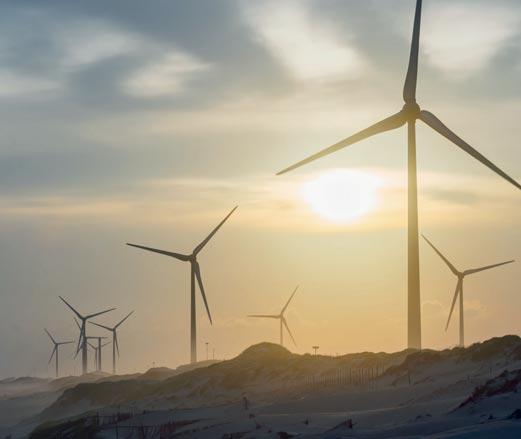




YOUR LEGAL PARTNER Whether you’re interested in wind energy (onshore or offshore), solar PV, green hydrogen or energy storage, Beauchamps has the experience to help you get your project over the line. IN RENEWABLE ENERGY Beauchamps LLP | Riverside Two | Sir John Rogerson’s Quay | Dublin 2 | D02 KV60 beauchamps.ie Get in touch: Ainsley Heffernan | Partner and Head of Energy & Natural Resources T: +353 (0)1 4180600 | a.heffernan@beauchamps.ie beauchamps ReNews Engergy fp ad indd 1 26/06/2023 15:01
Secure, clean, and affordable energy for Europe
While many may now associate the relative urgency on display in energy regulation with the Russian invasion of Ukraine in February 2022, Howes points out that Brussels’ response to the European energy crisis began with its issuance of an energy prices toolbox in October 2021 in response to rising electricity prices. 2022 then saw the invasion and the response of the European institutions, which included the publication of REPowerEU, the proposal of the gas storage regulation, amendments to the Fit for 55 plan, emergency measures on high electricity prices, high gas prices, RES permitting, and an emergency market correction mechanism.

“For me, the important message is that there is lots coming out; existing laws and targets, and priorities that may change from time to time, but the direction of travel is clear and constant,” Howes says. “We get more ambitious, the targets go up
and there is more money to be spent, but the direction of travel is the same.
“We have had Fit for 55, where we ratcheted up the targets and there are a lot of supplementary sub policies that are meant to support that, whether it is on the planning, innovation, or technology sides. Then, there is the EU money that is flowing; I think there have never been more pots of money available for supporting different dimensions of energy technology development, whether that is technical support to help local councils or others implement and understand the laws and process permits, or investment finance through the EIB or the EBRD. That is just the starting point.”
Along with Fit for 55, REPowerEU is the blueprint for the future of securing a clean, secure, and affordability energy supply for Europe. Formulated in the immediate aftermath of the Russian invasion, it aims
20 renewable energy magazine
Tom Howes, advisor on the green energy transition and energy market regulation for the European Commission, discusses measures taken and further measures to come to ensure Europe’s energy is clean, secure, and affordable.
to wean Europe permanently off reliance on Russia for energy supply. Due to the emergency nature of Europe’s response to the invasion, Howes explains that the plan contains both short-term measures, such as “going around the world for every bit of LNG we can possibly find”, and longterm ones, such as “speeding up the rollout of renewables, heat pumps, wind projects, and ratcheting up legislative ambitions with our targets”.
As Howes explains, gas market volatility also reached into the electricity market, creating another area where the European Commission would have to intervene: “There was a feeling that the electricity market that has given us these unacceptably high price spikes is not coping with this kind of crisis. That is why there is now an initiative to review electricity market design. Consultations around that are picking up different things; on the one hand, the spot market is working is as it should be, but everyone feels that there has been too much exposure to the marginal price and to gas playing a price-setting role at a time when gas prices are ridiculously high.
“There is a desire to make more of the longer-term markets, so we are exploring what we can do to make more use of Contracts for Difference, power purchase agreements, and hedging requirements so that these price spikes do not take everyone unaware in the future or cause the havoc that they did in 2022. We are looking at the prudential requirements for suppliers, for instance, in terms of changing strategies there so that suppliers do not suddenly go bankrupt, as has happened, as a result of being too exposed to the price spikes.”
Renewables Directive
In June 2023, political agreement was reached in Brussels on a revision of the Renewable Energy Directive, which saw the EU’s legally binding renewable energy target increase to a minimum of 42.5 per cent. Provisions included within the legislation also include the uncontroversial speeding up of permitting procedures. Under the revised directive, member states will be
Evolution of RE targets for 2030

required to introduce several measures that guarantee the speeding up of permitting processes for renewable energy projects.
“Nobody feels comfortable that the permitting process is fast enough, simple enough, or risk-free enough,” Howes says. “This is being amended in the Renewables Directive and we also introduced short-term emergency legislation to speed up the process. We are trying to make the application of EU environmental legislation easier by creating go-to areas, where you do not need to go through all the particular steps for a particular project and you can group assessments.
“The message is that EU policies and measures are all going in the same direction. Stakeholders thought they had investment opportunities under the 2020 targets, and they delivered. Targets have become more ambitious, which will hopefully mean more
investment opportunities, greater familiarity with the processes, and that it is becoming easier to invest.”
Concluding, Howes once again emphasises the need for coherence in planning and the importance of the message remaining the same: “We have got billions in the Recovery and Resilience Fund available to member states, but we have to make sure that these are consistent with each country’s own reform plans and the way they see things evolving. There is a need to continue to ensure complete coherence with the things we are pushing at the EU level and how that works out in each country.
“The direction of travel does not change. We do not want to bring surprises when we bring changes. We are making things better to address the problems stakeholders raise, to deliver the Green Deal for Europeans.”
21 renewable energy magazine
“We get more ambitious, the targets go up and there is more money to be spent, but the direction of travel is the same.”
Brown to Green: Climate solution expansion
In line with its Brown to Green transition strategy, Bord na Móna is fully committed to the continued expansion of its climate solutions and renewable energy portfolio. As we decarbonise industry, transport, and electricity production, our consumption of fossil fuel needs to be reduced and replaced by renewable energy as much as possible.

This will be best achieved by engaging in a multi-faceted approach that involves investing in, and developing, several renewable energy sources. Bord na Móna exemplifies this approach with its involvement in several important projects, centred around green hydrogen, offshore and onshore wind farms, solar farms and flexible technology.
Wind energy
Bord na Móna made significant progress over the past 12 months with €100 million invested in the expansion of its renewable energy offering, including wholly owned developments as well as joint venture projects. Wind energy milestones included the construction of the Cloncreen Wind Farm and the Oweninny Wind Farm, which is a joint venture with the ESB, as well as the commencement of work at the Derrinlough Wind Farm. These wind projects collectively represent an overall investment of €250 million. Bord na Móna also launched a joint venture with Ocean Winds to develop its first offshore wind farms around the coast of Ireland. The joint venture aims to generate up to 2.3GW of renewable electricity to power up to 2.1 million homes.
Another one of Bord na Móna’s latest onshore developments is the 105MW Derrinlough Wind Farm and the 110 kV Substation project. The site, comprising two bogs, Clongawny and Drinagh, exemplifies how Bord na Móna is transitioning from fossil fuels and peat production to sustainable energy. Comprising of 21 wind turbines with a total capacity of 105MW, the wind farm harnesses the power of nature’s resources to provide sustainable electricity for Irish communities.
Solar
An additional milestone in Bord na Móna’s renewable pipeline was announced in July 2023; Bord na Móna and its project partners ESB commenced construction of a new solar
Bord na Móna is a climate solutions and renewable energy company playing a pivotal role in the achievement of Ireland’s ambitious climate goals.
22 renewable energy magazine
farm at Timahoe North, County Kildare, as part of a wider solar energy joint venture between the two companies.
Timahoe North will be the first largescale solar project that both Bord na Móna and the ESB will bring to fruition as part of their respective renewable energy portfolios. It is expected that Timohoe North Solar Farm will be fully operational by the end of 2024, with an installed capacity of 108MW of renewable energy to the national grid.
This is enough energy to power around 25,000 homes, which will support the delivery of more green energy to communities and businesses across the country in line with Ireland’s renewable energy targets for 2030. The Timahoe North Solar Farm is part of a significant co-development agreement between Bord na Móna and the ESB to develop solar power across four midlands locations in Kildare, Offaly, and Roscommon. The joint venture will collectively deliver up to 500MW of power from solar farms based on Bord na Móna lands.
Green hydrogen
In summer 2023, Bord na Móna announced the development of a new 2MW pilot scale hydrogen electrolysis plant in Mount Lucas, County Offaly, having secured planning permission from Offaly County Council. Once operational, the new plant will generate over 200,000 kilograms of green hydrogen per annum.
This green energy produced at the Mount Lucas site will be used to help decarbonise certain elements of our national transport sector and will produce enough green energy every year to replace over half a million litres of diesel. The plant at Mount Lucas is part of the first phase of Bord na Móna’s overall hydrogen development strategy with construction set to commence in 2024, and production to begin by 2025. This project is the first of its kind in Ireland and an important step for the green hydrogen industry, as it will support the achievement of our national target of 2GW of green hydrogen energy by 2030.
In numbers…
Bord na Móna recently announced record financial results in its 2023 Annual Report, an outcome of a record performance across most areas of the business but driven particularly by Bord na Móna’s renewable energy portfolio which grew by 35 per cent in FY23 versus the previous year – including Cloncreen and Oweninny Wind Farms (both RESS 1 projects) which
collectively delivered an additional 175MW of electricity over the past 12 months. In line with these renewable energy projects, the company continues to invest in accompanying local community benefit schemes.
The ongoing expansion of Bord na Móna’s renewable energy portfolio not only aligns with Ireland’s climate action plan and its 2030 carbon emissions targets but also represents a significant milestone in the company’s transition from brown to green energy.
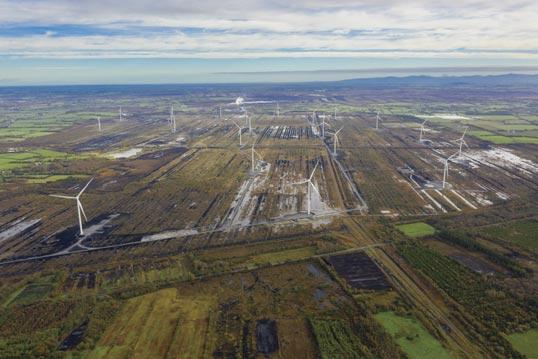
This underscores Bord na Móna’s dedication to further broadening its array of renewable energy and climate solutions initiatives into the future.
T: +353 45 439 000
W: www.bordnamona.ie
23 renewable energy magazine
“The ongoing expansion of Bord na Móna’s renewable energy portfolio not only aligns with Ireland’s climate action plan and its 2030 carbon emissions targets but also represents a significant milestone in the company’s transition from brown to green energy.”
Published in July 2023, the National Hydrogen Strategy is the Government’s first major policy statement on renewable hydrogen and is aimed at increasing certainty and reducing commercial risk to drive private sector investment.
The strategy explores the opportunity for Ireland, hydrogen production, enduses, transportation, storage, and infrastructure, alongside safety and regulation, research, cooperation, and scaling. In addition, it determines Ireland’s strategic hydrogen development timeline, seeking to “provide clarity on the sequencing of future actions needed and guide our [the Government’s] work over the coming months and years”.
Outlining the rationale for developing an indigenous hydrogen sector in Ireland, the National Hydrogen Strategy identifies three primary policy drivers:

1. Decarbonising the economy
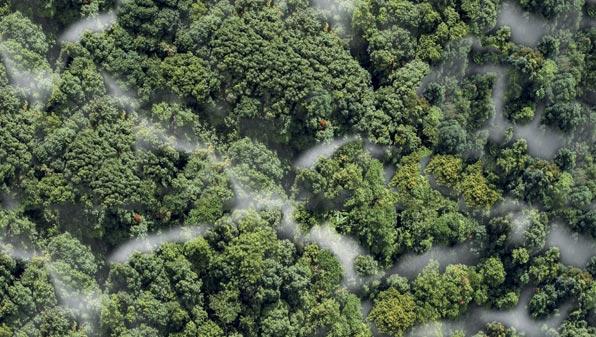
Ireland requires a radical transformation of its entire economy if it is to achieve net zero emissions no later than 2050. Indigenously produced renewable or green hydrogen can play a significant role in this transformation, with its potential to be a zero-carbon alternative to fossil fuels in hard to abate sectors of the economy. This includes those in which electrification is unfeasible or inefficient.
National Hydrogen Strategy published
Long awaited by many in the energy sector, the National Hydrogen Strategy was launched by Minister for the Environment, Climate and Communications and Minister for Transport, Eamon Ryan TD, aboard a hydrogen-fuel-cellelectric double-deck bus.
2. Enhancing energy security

Ireland imports around three-quarters of its energy supply annually. However, by harnessing one of the world’s best offshore renewable energy resources and using the surplus to produce renewable hydrogen, Ireland has an opportunity to reduce reliance and potentially achieve energy independence. While fossil fuels are utilised as a backup to renewable energy sources, renewable hydrogen could become a zero-carbon replacement. As per the National Energy Security Framework, hydrogen is highly energy dense and, therefore, suited to the development of seasonal storage solutions at scale, helping to mitigate variability and seasonal demand.
3. Creating industrial and export market opportunities
In the long term, Ireland has the potential to produce excess renewable energy, including hydrogen. At the same time, many European countries have identified a long-term demand for renewable carbon imports to meet decarbonisation ambitions. As such, the establishment of an export market could be beneficial to the domestic development of renewable hydrogen.
In the short term, the National Hydrogen Strategy establishes a series of actions aimed at enabling the development of Ireland’s hydrogen industry. The strategy
aims to removal obstacles which could inhibit hydrogen projects while enhancing knowledge through targeted research and innovation.
Established in 2020, the Interdepartmental Hydrogen Working Group is tasked with monitoring the delivery of these actions, while identifying further actions to support progress as the sector evolves.
Combining long-term ambitions with 21 short-term actions, the National Hydrogen Strategy aims to:
• kickstart and scale up renewable hydrogen production;
• identify end use sectors, supply chains, and required quantities;





• determine what infrastructure is needed;
• ensure the implementation of rules around safety, sustainability, and markets; and
• establish conditions which foster continued technological advancement and innovation.






Minister
In his foreword to the National Hydrogen Strategy, Minister Ryan asserts that, alongside other decarbonised gases, renewable or green hydrogen will have a key role to play in Ireland’s energy transition. Describing hydrogen as a “major opportunity for Ireland”, he contends: “It provides the potential for long-duration energy storage,
24
Prepared bythe Departmentofthe Environment, Climate andCommunica ons www.gov.ie 4 24 renewable energy magazine
Hydrogen Strategy
Actions to be delivered through the implementation of the National Hydrogen Strategy
1 Develop and publish data sets showing the likely locations, volumes, and load profile of surplus renewables on the electricity grid up to 2030.
2 Establish an initial hydrogen innovation fund to provide co-funding supports for demonstration projects across the hydrogen value chain.
3 Adopt EU standards for renewable and low carbon hydrogen and develop a national certification scheme to provide end users with clarity as to the origin and sustainability of hydrogen.
4 Develop the commercial business models to support the scaling and development of renewable hydrogen, via surplus renewable electricity until 2030 and an initial 2GW of offshore wind from 2030.
5 Develop a roadmap to bring net zero dispatchable power solutions to market by 2030, supporting the establishment of a near net zero energy system by 2035.
6 Assess the role that integrated energy parks could play in the future energy system, including potential benefits and barriers.
7 Publish the draft National Policy Framework on Alternative Fuels Infrastructure and support the roll-out of hydrogen fuelled heavy vehicles and refuelling infrastructure as per the recast Renewable Energy Directive and Alternative Fuel Infrastructure Regulation.
8 Assess the feasible potential for end uses such as eFuels, decarbonised manufacturing, and export via the development of a National Industrial Strategy for Offshore Wind.
9 Determine the quantities and profile of zero carbon long duration energy storage required up to 2050 and develop a roadmap for its delivery.
10 Review the existing licensing and regulatory regimes relevant to the geological storage of hydrogen, progress the necessary legislative changes, and develop regulatory regimes to facilitate future prospecting and development of underground hydrogen storage solutions.
11 Continue to prove the technical capabilities of the gas network to transport hydrogen while working closely with network operators in neighbouring jurisdictions in respect to interoperability between the networks.
12 Develop a plan for transitioning the gas network to hydrogen, duly considering plans to develop a biomethane sector in Ireland; the prioritisation of end uses set out in the National Hydrogen Strategy and their likely locations where known; the need to maintain energy security through the transition; how existing end users can transition from natural gas to hydrogen or alternative energy solutions such as electric heating; and the potential use of hydrogen blends during a transition phase, associated costs, and how the transition from blending can occur.
The plan should look to identify where the network can be repurposed, or where new pipelines may be required, providing detailed costings and a programme of works.
13 Identify and support the development of strategic hydrogen clusters.
14 Review current approaches to energy systems planning and make recommendations to support a more integrated long-term approach across the network operators.
15 Establish a working group comprising relevant regulators, government, and industry representatives to develop a roadmap for delivering the necessary safety frameworks and regulatory regimes across the entire hydrogen value chain.

16 Adopt the hydrogen and decarbonised gases market package into legislation once approved by the EU.
17 Review the entire hydrogen value chain to identify any gaps within the spatial planning, environmental permitting, and licensing regimes.
18 Engage with Ireland’s research sector to ensure sufficient focus is given to renewable hydrogen development and commission relevant research to help close the knowledge gaps identified throughout the National Hydrogen Strategy.
19 Continue engagement in EU hydrogen related initiatives and develop cooperation in renewable hydrogen development with neighbouring jurisdictions and international partners.
20 Continue to assess, and support the future skill needs of the offshore wind and renewable hydrogen sectors via the expert advisory group on skills established under the Offshore Wind Delivery Task force.
21 Review and update the terms of reference of the Interdepartmental Hydrogen Working Group in recognition of its role in oversight and implementation of the National Hydrogen Strategy.
2023-2024
2023-2027
2023-2025
2023-2030
2024-2026
2023-2025
2024-2030
2024-2026
2024-2026
2024-2028
2023-2028
2023-2026
2024-2026
2024-2026
2024-2026
2024-2027
2024-2026
2024-ongoing
2024-ongoing
2023-ongoing
2023-2024
Number: Action: Timeline:
25 renewable energy magazine
dispatchable renewable electricity, the decarbonisation of some parts of hightemperature processing, as well as a potential export market opportunity.”

However, the Minister makes clear that the deployment of hydrogen technologies must be optimised to deliver the most efficient or advantageous solution.
“Hydrogen provides us with an incredible opportunity in Ireland, but its use must be targeted to the uses where it will deliver the greatest benefits. We must not become distracted by the possibility to deploying hydrogen technologies where direct electrification would deliver a better outcome,” he writes.

End-uses
Renewable hydrogen deployment, the new strategy asserts, will centre on hard-to-abate sectors where direct electrification and energy efficiency measures are unfeasible or cost ineffective. Meanwhile, heavy transport applications bound by EU targets for 2030 are expected to be the first end-use sectors to emerge, quickly followed by industry and flexible generation.
While identified as significant highpriority end-users, the aviation and maritime sectors will take longer to develop. Indeed, given the uncertainties which exist in demand projections, it is thought that domestic hydrogen demand could range between 4.6 TWh and 39 TWh by 2050, increasing to 19.8 TWh and 74.6 TWh when including non-domestic energy needs such as international aviation and shipping.
Consequently, more research is required to determine a better understanding of the potential demand of end-use sectors, as well as the role that renewable hydrogen will play in an integrated net zero energy system.
In order of priority, the strategy lists 11 envisioned hydrogen end-uses:
1. Existing hydrogen end-users: Renewable hydrogen will replace niche grey hydrogen uses with a likely market entry timeframe of 2025-2030.
2. Flexible power generation and long duration energy storage: Net zero flexible backup generation and long duration energy storage with a likely market entry timeframe of 2030-2035.
3. Integrated energy parks for large energy users: As a backup to renewable electricity to meet reliability needs with a likely market entry timeframe of 2025-2030.
4. Industrial heat and processing: For high temperature heating and processing needs with a likely market entry timeframe of 20302035.
5. Aviation: As a zero-carbon synthetic fuel alternative to jet fuel with a likely market entry timeframe of 2035-2040.
6. Maritime: As a zero-carbon fuel (e.g. ammonia) with a likely market entry timeframe of 2035-2040.
7. Road and rail transport: For longrange road transport requiring long duty cycles and rail where electrification is unfeasible with a likely market entry timeframe of 2025-2030.
8. New non-energy uses: Such as fertiliser production and other chemical processes not currently undertaken in Ireland.
9. Export: Renewable hydrogen production exceeding domestic demand with a likely market entry timeframe of 2035-2040.
10. Blending: As a mitigation solution for end use variability and excess production with a likely market entry timeframe of 2023-2030.
11. Commercial and residential heating: In niche areas where electrification is unfeasible with a
Hydrogen explainer
likely market entry timeframe of 2035-2040.
Blending
Acknowledging a Gas Networks Ireland technical and safety feasibility study that determined transporting blends of hydrogen and natural gas via the gas network was both safe and feasible, the strategy recognises that “blending may offer an initial demand sink in the short term”. Notably, however, it concludes:
“Overall, blending is not seen as a high priority end-use for renewable hydrogen.”
Commercial and residential heating
Similarly, the strategy indicates:
“Hydrogen is not expected to play a role in commercial and residential space heating.” Rather, a combination of energy efficiency measures, direct electrification via heat pumps, and district heating are identified as “more efficient and cost-effective solutions” for the commercial and residential heat sector. Overall, the strategy contends that hydrogen will play a role in a small number of niche end use cases in commercial and residential heating which will “likely be required to work in parallel with energy efficiency measures such as hybrid heating systems where possible”.
Transportation, storage, and infrastructure
Ahead of hydrogen pipelines becoming the dominant mode of transportation, early hydrogen applications are anticipated to employ compressed
Hydrogen is most commonly chemically bonded to other elements, especially water (H2O) and hydrocarbons (CxHx). Hydrogen production relies on the chemical bonds between elements such as water to be broken, and the hydrogen separated and stored. This process requires an energy input, usually electricity or heat, the source of which, allied to the resulting byproducts, determines the carbon intensity of the production process.
Globally, most hydrogen is currently produced using hydrocarbons and in the absence of emissions abatement of the carbon byproduct. Grey hydrogen production is carbon intensive and unsustainable.
Electrolysis of water utilises electricity to split the molecule into hydrogen with oxygen as the byproduct. If the electricity used is generated via a renewable source, such as offshore wind, the resulting high purity hydrogen has no associated emissions and is therefore renewable or ‘green’ hydrogen.
26 renewable energy magazine
tankering solutions. Initial infrastructure is expected to be concentrated in regional clusters with co-located production, high priority demand, and large-scale storage. Subsequently, as the hydrogen market matures, these clusters will be linked in a national hydrogen network, repurposing existing natural gas pipeline infrastructure where feasible.
To date, the gas network has proven technical capability to transport hydrogen blends of up to 100 per cent. However, the strategy suggests that more work must be undertaken to better understand “the costs, phasing of transition, and potential impacts for existing network users”.
Meanwhile, long duration storage via geological solutions will be essential to ensure the cost effectiveness and price resilience of hydrogen supply.
Simultaneously, allied with network infrastructure, storage will be crucial in ensuring security of supply. Commercial ports, interconnection, and import/export routes will be vital to the establishment of a hydrogen economy in Ireland, and the longterm planning must identify the infrastructure requirements of an integrated net zero energy system.
Long-term vision
Recognising, that renewable hydrogen is a nascent technology with much uncertainty around costs, end-uses, infrastructure, skills, and supply chains, the National Hydrogen Strategy seeks to provide a long-term vision for hydrogen in the Irish economy.
Ultimately, the strategy outlines, the proportion of onshore and offshore renewable energy dedicated to the production of renewable hydrogen “will eventually be determined by the market”. Though the delivery of sufficient renewable energy to both meet indigenous demand and enable export opportunities hinges on optimising the offshore renewable energy potential.
Commentary
Broadly welcomed by academia and industry alike, the Renewable Energy Magazine spoke with several of Ireland’s hydrogen experts to gauge their reactions to the National Hydrogen Strategy.
Rory Monaghan, lecturer of mechanical engineering, College of Engineering and Informatics, University of Galway:
“Overall, the published hydrogen strategy is a great start. It delivered much more than I thought it would. The drafters really took the results of the public consultation seriously and have produced a very impressive document.

“Of particular note are the identification of end-use sectors and realistic timelines for hydrogen deployment in them. I am very happy to see heavy duty transport and public transport feature.
“The key next step for the sector is for the demo project fund to get established as quickly as possible so it can start dispersing support for projects. The commercial and research communities are ready to go.”
James Carton, assistant professor in sustainable energy, Dublin City University:


“Speaking with colleagues, we are quite impressed by the strategy. It is a nice piece of work. Both nationally and internationally, it has been well received. I have received positive feedback from my colleagues in academic, the public sector, and the private sector across Europe, the UK, and Ireland.
“It is a good document that sets out what Ireland is doing well, and that the interest mainly lies in hydrogen production and integrating it with renewable energy. It allows casts a light on some gaps which exist. One of the big gaps that it has identified is in end-use.
“There is a list of 21 actions, and each is very good; they all need to be actioned by the relevant bodies. Meanwhile, the Government has explicitly said that it is going to undertake pilots to learn, upskill, cultivate the knowledge and experience in the industry before building more larger scale projects.
“Government must quickly action the early points made in the action list of the National Hydrogen Strategy, while in parallel get going on ticking off these pilot projects so that we can enhance our experience and knowledge.”
Gillian Kinsella, co-chair of the policy and advocacy working group, Hydrogen Ireland:
“Hydrogen Ireland welcomes [the] release of the Government’s Hydrogen Strategy. The strategy marks a key milestone in the development of a green hydrogen sector in Ireland, one which can enable investment, increase skills and support regionally balanced economic growth. We look forward to supporting the implementation of the strategy in future to aid Ireland’s transition to a secure, net zero economy.”

27 renewable energy magazine
The biomethane opportunity in Ireland
KPMG hosted a round table discussion with key stakeholders to discuss the opportunity of developing a biomethane industry in Ireland.

What are the most significant benefits of establishing a biomethane sector in Ireland?

Ciara
Beausang
The SEAI National Heat Study assessed that around 80 per cent of the potential feedstock for biomethane would come from agriculture, signifying how important the sector is to that 5.7 TWh by 2030 target. The benefits are the opportunities for farmers to decarbonise, to diversify through anaerobic digestion, and realise alternative land use opportunities.
David Kelly
One of the major benefits of biomethane, which has really emerged in the last 18 months, is security of
supply, because it represents an opportunity to reduce our reliance on UK imported gas and give us greater certainty around gas supply. On the consumer side, biomethane is a relatively low cost solution because its similar make up to natural gas means little-to-no change to infrastructure and existing plant, while creating a pathway to the longer-term use of green hydrogen. Finally, Gas Networks Ireland’s recently published Biomethane Energy Report highlighted a large awareness of the local economy benefits of anaerobic digestion plant building, and an appetite to drive economic growth.
Russell
Smyth
What is so compelling about biomethane as an energy vector is its potential to align with so many national policy objectives which can deliver positive benefit. While security of supply benefit has only really emerged in the last number of years, there are a host of other benefits such as the decarbonisation of agriculture, the reduction in fertiliser usage, and the economic stimulus potential, for example. It is a tool that we can use to
drive so many other policy initiatives across the country.
Bill Callanan
There are two drivers of AD within current government policy. The first is the ambitious targets within CAP23 for agriculture, based on the opportunities of reducing emissions, removing emissions through land use, and a contribution to energy. That contribution to energy will be a combination of the opportunity for biomass, for solar on farms, and the development of AD. The second driver is the EU’s Methane Strategy. While primarily focused on fugitive emissions of the gas network, for agricultural methane it identifies opportunities for emission reduction in breeding, feeding, and developing AD, towards that 25 per cent reduction target.
James Russell
The most identifiable benefit is the potential for biomethane, as a renewable resource, to work in those difficult-to-decarbonise sectors of heat and transport. Importantly, it is one of the true circular economy technologies where you can deal with a waste
28 roundtable discussion
problem, produce a renewable resource, and displace inorganic fertilisers. If you include the CO2 capture potential, we can see a situation where you potentially end up in a carbon negative scenario. Added to that is the fact biomethane is storable, transportable, and dispatchable.
Cathal Fitzgerald
Ireland’s national food strategy targets the emergence of Ireland as a leader in sustainable food systems and the reality is that to achieve this, the food corporates need sustainable solutions. Biomethane provides a solution, particularly in relation to heat use by processors. Currently, we are seeing large processors import solutions from elsewhere, but we need to have our own solutions if we are to retain and support those businesses of scale. On the flip side, biomethane offers the opportunity of a new sector in Ireland, one that is rural-based and embedded in communities. In the short term, achieving the 5.7 TWh has the potential to create up to 3,000 jobs, however, longer-term evolution of the sector and upgrading of industries such as biomanufacturing and bioprocessing will be of great benefit.
Which sectors will show the greatest appetite to procure biomethane gas?


James
Russell
One of the major markets will be power generation, large energy users, entities that would have the ability to directly purchase biomethane to meet their carbon requirements. The transport sector will be interesting too, as biomethane is one of the proven technologies that can decarbonise transport.
David
Kelly
Roundtable participants
Ciara Beausang
Ciara Beausang is a Research Officer in anaerobic digestion with Teagasc, the Agriculture and Food Development Authority. Her research interests include environmental modelling of biogas production and optimising biogas yield from agricultural feedstocks. She has a PhD in Biosystems Engineering from University College Dublin.

Bill Callanan

Bill Callanan is Chief Inspector at the Department of Agriculture, Food and the Marine (DAFM). He is responsible for the provision of advice on the practice of agriculture and on science and technology related to the agrifood sector within DAFM. He has direct responsibility for DAFM’s research, feed and fertiliser, pesticides, crops, animal breeding, and horticulture/plant health and is environment policy lead on climate, water, and biodiversity.
Cathal Fitzgerald
Cathal is Senior Investment Director, Food and Agriculture, for the Ireland Strategic Investment Fund. Prior to joining the Fund in 2014, Cathal worked with the Irish Dairy Board (Ornua) in various roles and was Group Finance Director from 2004. He joined the Irish Dairy Board from Price Waterhouse. He is a Fellow of the Institute of Chartered Accountants in Ireland, holds a B.Comm from UCD, a diploma in corporate treasury from DCU, and a diploma in corporate direction from Institute of Directors.
David Kelly


David Kelly is the Director of Customer and Business Development at Gas Networks Ireland. David has over 20 years of executive-level experience having worked extensively in both the private and public sectors throughout his career. Prior to being appointed to his current role, Kelly was the Group Head of Customer Operations and Public Affairs for Ervia.
James Russell James Russell is Chief Technical Officer for BioCore Environmental Ltd. He is responsible for the development of strategic project opportunities including the engineering and construction activities across BioCore’s key business areas including renewable energy project development, waste management, sludge and biosolids management, and R&D. BioCore aim to develop a significant pipeline of AD biomethane projects over the coming years, building on their current AD operations.
Russell Smyth
4 roundtable discussion
Russell Smyth is a Partner in KPMG Ireland and leads the firm’s dedicated renewables and climate change advisory division, KPMG Sustainable Futures. Smyth has extensive experience in renewables M&A, transacting over €3 billion of Irish renewable assets over the past three years across a wide variety of technologies including onshore and offshore wind, solar and battery storage. He is also assisting corporate and public sector clients navigate the wider climate change and sustainability agenda as Ireland transitions to a net zero economy, including corporate PPAs, decarbonisation pathways, and sustainability strategies.

Our role in Gas Networks Ireland as the network operator is almost like a matchmaker, we link renewable gas developers to customers and in particular the industries that have demand for high amounts of energy. We are also seeing interesting movement in transport. DHL, one of the largest logistics companies in the world, has recently made an investment worth €80 million into a dedicated biomethane production facility in Cork and purchased 150 BioCNG vehicles that will result in an annual carbon reduction of 15,000 tonnes. However, we do not have the renewable gas to supply those 150 BioCNG vehicles today. We will inject about 70GW this year and all of that is going into transport and that is a problem for the 29
other industries that need it. As soon as we can get volume and scale in place, there is a large market out there to take it.
Russell Smyth
One of the challenges is that we will never have enough biomethane, certainly in the early years, to satisfy all the demands that will be placed upon it. One of the decisions that has to be taken on government policy is whether there is a requirement to guide its allocation. In theory, biomethane should be directed to the sectors where it will have most substantial decarbonisation benefit, and research suggests that will be the sectors that have the fewer alternatives available. That is typically high temperature thermal users, however the problem in talking to many sector participants is that while they would love to utilise biomethane, there is a risk that they cannot afford to pay the premium over natural gas, and it will instead go to sectors that can afford to pay it, such as electricity generation. That generation however may be better done through offshore and onshore wind, so there is a risk that a free market will not necessarily allocate this to the sectors that the State would see as the most optimal users.
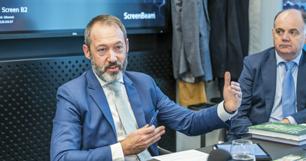 Bill Callanan
Bill Callanan
From a State perspective, the question is: how do we optimise the contribution and the benefit for what is a scarce resource? We are a food island; we have an opportunity with a strong coop structure to get involved in this. If we look at areas such as dairy processing, where there is a high heat demand, it is a natural fit in terms of circularity. If you look at it from a livestock protein point of view, a grassbased rain-fed system is very sustainable on an international scale.
Linking that with a processing system that is circular would give you a huge opportunity. There is then the issue of cost differential between natural gas and biomethane and as a government we have to look at where there are logjams in terms of regulation or feedstock or other issues. They have to be addressed in the strategy to chart a mechanism for going forward for the industry to give it some leadership in that area.
Ciara
Beausang
There is a natural fit with the food sector and the opportunities AD can provide in terms of circularity, especially along the whole supply chain. Digestate is going to be a valuable byproduct from the AD sector, so there is a good story to tell there for the food sector. One of the other things to think about is the potential of more decentralised biomass and how that could be used in industry clusters where there is demand. Not all of our biomass resource for AD is going to be located directly beside the gas grid, so there may be opportunities for more decentralised solutions for these types of energy users.
To what extent can the sector develop without a specific government biomethane subsidy support?


Russell Smyth
Government subsidy is undoubtedly the most topical discussion in our consultation with stakeholders as we continue to develop the draft
“The benefits are the opportunities for farmers to decarbonise, to diversify through anaerobic digestion, and realise alternative land use opportunities.” Ciara Beausang
“The ability to have that cost certainty in the long term means that industry is more willing to pay that higher price, in the knowledge that they also have to satisfy that external pressure to decarbonise.”
30 roundtable discussion
James Russell
recommendations for a national biomethane strategy. The argument for support is often framed in the context that no other European country has developed a biomethane industry without some form of government specific support. While it is likely some form of government support is required, we are in a much different landscape than was the case for Denmark, France, or the UK in the last decade. Up to two years ago, industry demand was minimal and even then, demand was based on assured cost-parity with natural gas. Now, corporates with commitments and budgets to decarbonise are no longer looking at natural gas as a comparator, it is no longer an option. The demand for the next-best, decarbonised option to natural gas may be enough to break the cycle of the need for significant government subsidy.
James Russell
I would agree in that we do not see the Renewable Heat Obligation (RHO) as initially being a major driver of AD, because there is no certainty of the price for biomethane. Instead, the drivers are from industry, where large energy users are willing to commit to taking certain volumes over the longer term. Instead of hedging their bets on the price of natural gas, there is a realisation that biomethane can enable cost projection of up to 20 years. The ability to have that cost certainty in the long term means that industry is more willing to pay that higher price, in the knowledge that they also have to satisfy that external pressure to decarbonise.
Bill Callanan
I would be reluctant to interfere with the market but where plausible, government support has to be focused on areas that align with government policy because we are using taxpayers’ money. The energy cost shock over the past 12-18 months has necessitated a reappraisal of risk, and we are now seeing organisations giving security of supply as much consideration as that external pressure to decarbonise their offering. The reality is that the capacity to pay depends on the sector and so government support and policy direction must try and find the sweet spot that best meets the objectives set out in CAP23. That is not just about finance, it is about developing a framework which deals with things like regulation, planning, and the speed of process of approval.
Cathal Fitzgerald
We know that there are buyers out there willing to pay a green premium, but the challenge lies in ensuring we do not have an industry, with greater capacity to pay, outcompeting others where solutions to decarbonise are much more limited. The focus must be on decarbonising those hard-to-abate sectors, but in a free market, resources go to those who pay the most. Can we direct to the areas where there are no alternative solutions? I think to get to the core of this challenges it will require intervention.


David
Kelly
The key word is certainty. One year ago, I would have said that based on all other European biomethane industries, government support was clearly needed. However, what we are witnessing through recent initiatives is large energy entities securing equity funding to build AD plant based on what they see as latent demand. Certainty in this regard is based on sectors being willing to sign corporate PPAs, but that is far from ideal. It is very understandable as a business model in the absence of government
supports, but the problem is that Ireland will end up with a lot of plants selling straight into the sectors which have the most cash, sectors which could possibly be better served by offshore wind.
Bill Callahan
One of the cautions government is considering is the role of farmers in a large biomethane industry. Food waste will be the predominant raw material for biomethane in, say, the first 50 of 200 AD plants, depending on scale. However, beyond that it will be silage, etcetera. The critical thing here is that farmers do not just become price takers in terms of the provision of the feedstock but need to fully engage and not just be suppliers of raw material. Design of support needs to be based on engagement with farmers and communities.
4
31 roundtable discussion
“The problem is that Ireland will end up with a lot of plants selling straight into the sectors which have the most cash, sectors which could possibly be better served by offshore wind.” David Kelly
Ciara Beausang
The idea has been floated of the possibility of biomethane being costed based on its carbon footprint in relation to trading, which is something that is really interesting, particularly in relation to agriculture. In the current iteration of the Renewable Energy Directive, there is a credit given to manure when used as a feedstock, because it is recognised as improved manure management when compared to traditional slurry storage. The codigestion of cattle slurry and grass silage, bringing down the carbon footprint means that the attractiveness of Ireland’s biomethane could be accelerated.
How can participation of the rural economy be maximised?


Ciara
Beausang
There is an onus on the agriculture sector to decarbonise, but a challenge exists in the recognition that while farmers will play a vital role in the production of these feedstocks, most of the displacement will actually take place in the energy sector. I think it is
really important to recognise the role of the farming community in their contribution to the broader decarbonisation agenda and to raise awareness within that community of the longer-term benefits such as biofertilisers and digestates, once the industry is up and running. Finally, I think we need to acknowledge those

rural communities where AD plants are located. The Renewable Electricity Support Scheme’s establishment of a Community Benefit Fund has been very successful, and I think there is scope to develop something similar for rural communities in relation to creating a biomethane industry.
David Kelly
Education and awareness are probably the greatest challenges we have in relation to plant development. Gas Networks Ireland recently visited the site of a 600GW AD plant in Billund, Denmark which is designed in a way that ensured seamless integration with its surrounds and is recognised for its local positive impact. Those are the types of designs we need to promote. Equally, Ireland’s first directly connected AD plant will go live in Q3 of 2024 in Munster. When operational, the volume of biomethane produced could make 40 per cent of Waterford’s gas supply renewable. If we can educate around those types of examples, we can bring people along and they can see the community benefit.
James Russell
It always perplexes me that we have a renewable technology that can slip so seamlessly into the agriculture industry, an industry that is being hammered from a climate perspective, that farmers are not jumping up and down demanding an AD agri-industry. Maybe the reason is that there is a perception that the benefits are going to other
“There is a risk that a free market will not necessarily allocate biomethane to the sectors that the State would see as the most optimal users.” Russell Smyth
32 roundtable discussion
“The energy cost shock over the past 12-18 months has necessitated a reappraisal of risk, and we are now seeing organisations giving security of supply as much consideration as that external pressure to decarbonise their offering.” Bill Callanan
sectors, but in any case, there has been a failure to properly articulate the multibenefits of the industry and to bring the agriculture communities along.
Bill Callanan
There are learnings to be taken from wind energy development, where engagement with communities has massively changed the dynamic locally. One of the main benefits I see is how the diversification of land use fits in with the changing nature of the farming lifestyle. We are now seeing a significant amount of part-time farmers. There is a genuine appetite from parttime farmers for income certainty without the traditional time commitment, and particularly when it comes to beef farming, there is an opportunity to utilise land with less demand on time. Importantly, however, it must make financial sense.
Cathal Fitzgerald
It is important for agriculture and rural farmers that they see the credit of their endeavours going to agriculture and I think there is a role for the large corporates in this regard. As large businesses in their own right, corporates can not only be off-takers, but also have a role in communicating to their members the positive benefits. Once you get over the barrier of social acceptance, then the benefits for the rural economy become clear through exemplars. That is about effective communication, but it is also about collaboration with key stakeholders to help promote the benefits.
Russell Smyth
Northern Ireland represents a good example of government policy enabling farmers to make lifestyle choices through certainty. I am not aware of any farmer in Northern Ireland who has expressed regret about building an AD plant and in fact, most are asking how they can expand. However, there is a challenge in that the scale of electricityled Northern Ireland plants do not translate into the modern biomethaneled approach expected to dominate going forward, so it is unlikely that there is a desire to replicate that scheme entirely.
What is the most significant challenge the sector faces in achieving scale?


Cathal Fitzgerald
It is hard to identify one single challenge due to the interlinkages between planning, licensing, and all
other parts of the process, but the one I would pick is the social acceptance piece. If we can get social acceptance and policy that gives people confidence in this sector, where certainty feeds into pathways, then people will see that this is an acceptable way for them to make a living.
James Russell
For us, it is down to price certainty on the biomethane side. Long-term guaranteed revenue streams that we can have in our business models is the key factor.
Bill Callanan
Confidence. Confidence locally, in terms of community involvement; confidence from the farming sector, in terms of engaging with it; and confidence in terms of the business model to allow the finance to flow.
Russell Smyth
We have a proven technology and I believe there is demand to provide a route to market. There is no shortage of funding, and there are developers who want to develop it. The thing I am most worried about is the timelines of getting projects through planning, the EPA, vetting, and getting grid connections built. Every single one of those has the potential to create a long lead time, which would make this a slow sector in which to build tangible momentum.
David Kelly
Regulation. The CRU has a key role to play in the safety case around all of this. We have had a challenge over the last number of years. We have CNG running in transport and got a safety case manual signed off in September 2023 after four years. We are going to have to do the same with our central grid injection facility in Mitchelstown and with all the other facilities we build around the country. Educating the regulator and the policymakers on all of this is a challenge. We need them to feel confident that this is a well-proven technology and all we are doing is catching up.
Ciara Beausang
The main challenge is going to be the knowledge transfer and demonstration that is going to be required in the timeline we have until 2030. We need to have examples of farms where feedstocks are being grown sustainably, where farmers can see what it looks like in practice and examples of plants that are using agricultural feedstocks, so we can show what that looks like to the industry. Teagasc will have a vital role to play in terms of that knowledge transfer.
33 roundtable discussion
“It is important for agriculture and rural farmers that they see the credit of their endeavours going to agriculture.” Cathal Fitzgerald
Decarbonising Ireland’s heat demand
Barry Quinlan, Assistant Secretary, Energy – built environment, retrofit and heat policy at the Department of the Environment, Climate and Communications, talks about government priorities in the decarbonisation of heat demand.

Setting the context for his responsibilities and the immediate pressure under which he operates, Quinlan states that when threatened, for example by the war in Ukraine, “security of supply and affordability trump everything else”, pointing to his work on 2022’s electricity credit, ensuring that the country had requisite diesel levels, and making market adjustments to ensure access to fossil fuels. “It is about making sure people can heat their houses,” he says.
However, Quinlan outlines that the decarbonisation of the heating of houses will be a major part of the State’s push towards net zero by 2050, with the overall policy context dictated by the Climate Action Plan. “Chapter 14, Built
Environment, is how we are going to decarbonise our buildings,” he says. “We have done a lot of work on new buildings and the standards. In my old department [the Department of Housing, Local Government and Heritage], they are very, very strong. People buying houses now are buying Arated houses with heat pumps primarily, but it is a completely different story for older homes which are on oil and gas. That is the big thing we have to change.”
District heating
This change will be governed by the currently progressing National Heat Policy, which is “working through the system at the moment”, and its emphasis on electrification and district
3434 renewable energy magazine
heating. In the case of district heating, Quinlan acknowledges that “we do not do [that] at any scale here yet, but we know it works well in Europe”. “The great thing about district heating is that when you have one source of heat for multiple buildings, as is the rationale for changing our heating source, you can do that,” he elaborates.
The National Heat Study highlighted progress in the area of heat pumps but said that district heating still requires significant work. “District heating needs to be focused on a district or a part of a large town or city,” Quinlan says. “We have brought together good people from the system: planners, regulators, finance, and local authorities which have already done district heating here, looking at the delivery model at scale.
“We are going to need major district heating projects in all of our cities as a start. At the moment, the primary delivery model is a co-operative model based on local authorities, which certainly has its merits, but to do it at scale, we can see from countries which have done this that it requires a mix of public and private.”
Heat and Built Environment Taskforce
A number of taskforces have been set up by Minister for the Environment, Climate and Communications Eamon Ryan TD, with Quinlan chairing the Heat and Built Environment Taskforce, whose members include nine government departments, Enterprise Ireland, the HSE, the local authority City and County Managers’ Association, IDA Ireland, the Office of Public Works, SEAI, and Teagasc.
Quinlan states that the membership of the HSE is especially important, given that the executive owns 4,500 of the circa 11,500 public buildings in the State. The membership of the Department of Agriculture, Food and the Marine allows for “a lot of work” to be done on biomethane, and the area of residential retrofit – where Quinlan acknowledges “a huge job” – is also being covered.
“The taskforce is bringing all sorts of people together from different departments,” Quinlan says. “We also have subgroups covering industry. Industry has a big job to do in terms of heat, processes, and also buildings. We have the public sector, and the public sector has to be a leader. We have to formulate a policy there which works over
time, particularly to retrofit our buildings.”
Renewable heat
Another major focus for Quinlan is the Renewable Heat Obligation, and the taskforce is playing a role in this regard by participating in the formulation of a biomethane strategy. “A key part of it is building that whole business model to make those projects work,” he says. “We are looking at biomethane and anaerobic digestion with not only a link to agriculture, but the key parts are around feedstock and how you feed this over time. The other bit is being able to offload the energy efficiently at the end. That is the whole piece around the Renewable Heat Obligation, and we will be going out to consultation.”
Some “incredible schemes” are being run through SEAI’s industry programmes in this regard, Quinlan says, pointing to a recent trip to a large industry network in a “major facility” in Tipperary as an example. “It was incredible; a big solar farm, working towards a massive heat pump, going to use the excess energy that will deliver from offshore wind,” he says.
“They are all moving in this direction; it is coming from their own boardrooms. They are looking for the Irish regulatory regime and how we support them. We do not have to ask them to go on this
journey, those decisions have been made and the decarbonisation is just as high a KPI as profit at boardroom level.”
Quinlan also makes note of “improvements” made to the “very generous” Renewable Heat Incentive Scheme and reaffirms the Government’s commitment to it, despite admitting that the process has been “difficult”. This contrasts with the National Retrofit Plan, where “huge progress” is being made according to Quinlan, much like the rollout of heat pumps. “Huge amounts of people have to make those decisions,” he says. “It is a big intervention, and it is not a well understood technology for people that are in existing homes. New homeowners are very familiar with it now.”
Concluding on a positive note, Quinlan focuses on the success of the retrofit scheme as evidence of the progress being made towards weaning Irish domestic heat off oil and gas: “We doubled the amount of money spent. 27,200 upgrades is 80 per cent up on the year before; that tells its own story.
“Heat is one of the last big challenges that Ireland needs to get on top of. We are preaching to the converted when it comes to industry. We are going to have to bring homeowners and others with us and make sure that the transition is just.”
“We are going to need major district heating projects in all of our cities as a start.”
35 renewable energy magazine
Barry Quinlan, Assistant Secretary, Energy –built environment, retrofit and heat policy at the Department of the Environment, Climate and Communications
Electricity consumption flexibility key to decarbonisation

For Ireland to meet its carbon emissions targets for the energy sector, as set out in the Government Climate Action Plan 2023 (CAP23), it will be necessary for electricity demand to become more flexible. This demand flexibility will allow energy customers to optimise their use of renewable generation and reduce demand during times of high-carbon intensity generation on the electricity grid.
The objective of the strategy is to support electricity customers to move their consumption to times that will reduce carbon emissions, even as the expected energy demand increases in Ireland over the next number of years. This will provide a better pathway to reducing greenhouse gas emissions in line with the legally binding carbon sectoral emission limits.
The new strategy will address how customer groups can be facilitated to bring greater flexibility to their electricity consumption, leading to decarbonisation, enhanced security of supply, and lower system costs.

36 renewable energy magazine
The Commission for Regulation of Utilities recently published a new strategy to reduce the carbon intensity of energy demand in Ireland.
This strategy will also consider options for new large demand connections, to invest in more flexible solutions, and for customers to move their consumption away from times of high carbon intensive generation.
The first phase of the strategy will consist of three key areas:
Smart meters and services: Targeted at putting in place measures that will encourage greater flexibility among domestic customers and smaller business customers. The first step in this is to incentivise the further uptake of smart time of use tariffs. As of April 2023, approximately 7 per cent of consumers with a smart meter avail of a time of use tariff. Given the benefits of time of use tariffs to consumers, the environment, and the electricity grid, the CRU is proposing a number of measures to incentivise further uptake. These include:
• amending the Price Comparison Website accreditation framework to allow consumers to upload their smart meter data to receive a personalised price comparison;
• implementing an Estimated Annual Bill for all time of use tariffs; and
• increasing the limit on the number of time of use tariffs that suppliers are allowed to offer to domestic customers from four to eight.
Demand flexibility and response:
Putting in place schemes to incentivise the provision of demand response at certain times, or system conditions. This is led by ESB Networks’ National Network Local Connections Programme, which is targeting scenarios to provide for increased flexible system demand. In response to the accelerated targets that are set out in CAP23, and the commitment made by ESBN in its Networks for Net Zero Strategy, ESBN has developed a set of evidence-based scenarios exploring possible pathways to achieve Ireland’s national target of 15 to 20 per cent flexible demand by 2025. Each of these scenarios reflect a different way in which the step change needed to deliver on 2025 demand side flexibility and carbon abatement targets could be achieved.
New demand connections: Targeted initially at very large energy users (LEUs) seeking to connect to the electricity or gas network. This will include a review to provide a pathway for new LEU connections to the
electricity and gas systems, which minimises the impact on national carbon emissions. This may be through the provision of connections which are low to zero carbon emissions, or bring significant flexibility by a LEU when they connect to the electricity or gas network. This area will seek to dramatically lower the carbon intensity of our future economic growth, working with industry to align their own decarbonisation targets and strategies with the national frameworks within which they operate.
Commenting on the Energy Demand Strategy, Commissioner Aoife MacEvilly says: “As we transform our electricity system to a high renewables, low carbon system, we also need to develop more flexible demand. Customers can benefit from using electricity at times of high renewables, while also helping us achieve our carbon targets.
“The past winter has shown good progress in terms of reducing demand at peak times and a new Energy Demand Strategy is the next foundation piece to this transition. This will provide a clear pathway for increasing the flexibility of
all customer groups to moving their demand from times of high demand and carbon intensive generation to times of lower demand and higher renewables sources of generation.”
The Energy Demand Strategy and the additional proposals were published for public consultation in June 2023, with an extension request to accommodate stakeholders added to the process until the end of August. The CRU is currently reviewing these submissions with a view to publishing the next stage of the Energy Demand Strategy before the end of 2023.
For further information on the CRU Energy Demand Strategy go to www.cru.ie

Commission for Regulation of Utilities
T: 01 4000 800
E: info@cru.ie
W: www.cru.ie
“The past winter has shown good progress in terms of reducing demand at peak times and a new Energy Demand Strategy is the next foundation piece to this transition.”
37 renewable energy magazine
Head of Development for Solar and Battery, Daniel Barnes
RESS 3: Low levels and higher prices
Of the 20 solar projects accepted, ESB Solar’s Tracystown Solar Park is the largest of all the projects accepted at 101.1MW, and projects range in size down to the Tead More Solar project (3.95MW), the smallest successful applicant.
The competitive auction determines which generators receive support, which typically applies for approximately 15 years.
Following the publication, Wind Energy Ireland said that Climate Action Plan targets are “unachievable” without government action.
CEO Noel Cunniffe congratulated those successful in the auction but said that rising prices and lowering of renewable energy volume in the latest auction is the opposite to what should be occurring.
“At a time when we should be accelerating the delivery of renewable energy, we are slowing down, he says, “The critical issue remains the failure of the Irish planning system to meet its timelines for processing applications for renewable energy projects.”
He adds: “We are living in an energy and climate crisis, but we do not have a planning system that has been given the resources, the expertise and the personnel to deliver.”
Calling on the Government to urgently review the development of renewable energy and the RESS auction system, Cunniffe states: “The system is not working. We cannot make Ireland more energy-independent and achieve our 2030 Climate Action Plan targets this way.”
Wind and solar industry bodies have called for reform of the planning system after the Renewable Electricity Support Scheme (RESS) 3 delivered the lowest volume of renewable energy to date, at a price higher than the previous auction. Just three wind farms (148MW) and 500MW of solar were deemed successful in the provisional results announced by EirGrid at the end of September 2023.
The average price for all projects is €100.47 per megawatt hour, an increase compared to €97.87 for RESS 2. A total of 36 projects applied to
participate in the RESS 3 qualification process, with 33 qualifying to participate and 31 submitting an offer price. Of the 31, 23 projects have been deemed provisionally successful, with eight provisionally unsuccessful.
The three onshore wind projects vary significantly in size. Green Wind Energy’s Yellow River Wind Farm in Wexford is the second largest overall project and largest wind project accepted at 101MW. Gromane Limited’s Farranroy Wind Farm is offering 43.2 MW, while Bradan Wind’s Bradan Wind Farm is 4.2MW.
Adding to the criticism, Conall Bolger, CEO of the Irish Solar Energy Association (ISEA) described the RESS 3 auction as “overly rigid” and said that avoidable systemic failures limited its potential for success.
“There is close to universal support for the vision behind these annual auctions. However, what started out with a clear goal to boost the level of renewables in Ireland has become bogged down in overly complex terms, conditions, rules, and red tape. The sum total of this has been that RESS 3 delivered fewer projects and less green energy than should have been the case and done so at a higher cost to consumers,” he says.
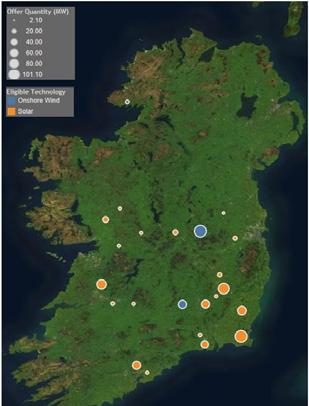
38 renewable energy magazine
Provisional results of the Government’s third onshore renewable energy auction have been branded as “extremely disappointing” after the smallest level of generation to date was deemed successful.
Location of RESS 3 provisionally successful projects.
Credit: EirGrid
Grant embraces transition to fully renewable heating technology manufacturer

construction, and existing heating design of older buildings traditionally incorporated high temperature heating systems. For an older building to become heat pump ready it is essential that upgrades are made to the building fabric and air tightness before the heat pump installation takes place. However, the HVO biofuel compatible Grant Vortex boiler range is offering a solution for rural and hard to heat homes as using 100 per cent HVO, can result in around 88 per cent reduction in carbon emissions, and using this or a percentage blend of HVO with kerosene, will enable properties to transition to a renewable green alternative from 100 per cent kerosene at an affordable cost, with minimum disruption to everyday lives.”
Grant’s diverse range of renewable heating technologies work together seamlessly, to provide a fully integrated, highly efficient, and cost-effective heating system for a property to ensure it is future-ready.
A global leader in the heating industry, Grant announced an R&D breakthrough in 2021 after innovating its well-known Grant Vortex condensing boiler range to be 100 per cent HVO biofuel compatible, meaning the manufacturer has largely transformed into a renewable heating company. This transformation is reflected in Grant’s diverse product portfolio which includes HVO biofuel ready condensing boilers, air to water air source heat pumps, condensing wood pellet boilers, solar thermal panels, underfloor heating, hot water cylinders, and aluminium radiators.
“As a company we are committed to helping homes reduce their carbon footprint and prepare for the future with highly efficient and sustainable heating technologies,” says Barry Gorman, National Renewables Sales Manager at Grant.
• Award winning heat technology
Renowned for its innovative range of technologies, Grant is currently supporting many social housing projects, new build developments, and retrofit projects throughout Ireland in a drive to help advance the deployment of renewables.
Gorman explains: “Air to water heat pumps like the Grant Aerona3 R32 models are a popular choice for new builds as the minimised heat loss of these homes perfectly matches this medium temperature technology. The increase in interest of renewable technology is great to see and to help support the move to heat pump technology we have diversified our education offering for installers, architects, engineers and local authorities, to include CPD courses via our onsite Training Academy and online eLearning Academy.”
Gorman continues: “Retrofits can be more difficult because the layout,
• Highly Efficient A+++ Energy Rating
• Available in four outputs (6kW, 10kW, 13kW, and 17kW)

• 13kW and 17kW models recognised by Quiet Mark for their quiet operation
To help those working on new build developments to ensure the correct heating technology, size and specification is chosen for a property, Grant offers a free of charge heating design service. Simply send property plans and choice of heat emitters to heatpump@grant.ie.
T: 057 912 0089
E: heatpump@grant.ie
W: www.grant.ie
Facebook and Twitter: @GrantIRL Instagram: @grant_irl
LinkedIn: Grant Engineering ULC
• Offers a superior seasonal coefficient of performance (SCOP) even at colder temperatures
• Can help achieve compliance required under building regulations
• Sized and specified by Grant as part of their free home heating design service
Continuing to demonstrate its commitment to helping lower carbon footprints and prepare homes for the future, Grant has ensured all its heating technologies can be renewable.
the Grant Aerona3 R32 air to water, air source heat pump:
About
39 renewable energy magazine
Grant Aerona3 R32 6kW air to water, air source heat pump.
Towards an enduring offshore regime
The second Offshore Renewable Energy Development Plan (OREDP II) is set to take Ireland a step closer towards an enduring regime for offshore renewables. Despite a Government pledge to publish in summer 2023, the finalised plan has yet to be made public.
Ireland’s new national spatial strategy for offshore renewable energy (OREDP II) has been touted as a cornerstone of a future, long-term model for Ireland's offshore renewable energy sector.
The enduring regime envisaged by Energy Minister Eamon Ryan TD comprises a much broader utilisation of offshore renewables into policy ambitions around hydrogen, interconnection, and the economy, but OREDP II is focused on an earlier stage of ensuring the right technology is deployed in the right areas.
The Programme for Government delivered a commitment to developing a long-term plan to take advantage of a potential 30GW of floating wind off the

Atlantic coast and become a major contributor to a pan-European renewable energy generation and transmission system.
OREDP II seeks to not only consider technological advances to assess the potential for offshore energy in Irish waters, but also map areas most suitable for infrastructure, considering maritime activities and biodiversity.
The OREDP II assessment encompasses the maritime area covering all of Ireland’s Exclusive Economic Zone (EEZ), which reaches up to 200 nautical miles or 370 km off the coast.
40 renewable energy magazine
Timeline
2014
OREDP I published
2021
Updated OREDP I begins.
Maritime Area Planning Act
National Marine Planning Framework, Policy Statement on the Framework for Ireland’s Offshore Energy Transmission System
2021 Climate Action Plan

2023
February 2023: Draft OREDP II consultation
April 2023: Consultation closes
According to the Government: “The second OREDP II is an important tool in setting out the overall framework and spatial strategy to facilitate the transition from a developer-led approach to the enduring plan-led regime. It will lay out the overall framework and national spatial strategy to guide the long-term, sustainable, and planned development of ORE in our maritime area.”
It adds: “The OREDP II is a dynamic framework which will be updated cyclically to manage the development of ORE in a proactive and holistic way to support our transition to the enduring plan-led regime for ORE in Ireland.”
The Maritime Area Planning Act 2021 (MAP Act) proposes Designated Maritime Area Plans (DMAPs), and OREDP II proposes criteria to identify initial broad areas of interest for future ORE development, further refined into smaller geographical areas as part of the DMAP assessment process. The criteria utilised has identified three broad areas of interest in the form of the Celtic Sea, Shannon/Foynes area, or the north-west coast. Consultation on OREDP II comes after the Government issued Maritime Area Consents (MACs) to the first phase of seven offshore wind projects following the publication of Climate Action Plan 2023. The award enabled all Phase One projects to begin their pre-planning application engagement with An Bord Pleanála and participation in the first auction for offshore wind under the Renewable Electricity Support Scheme (ORESS).
Text
Launching the consultation, and encouraging participation, the Minister for the Environment, Climate and Communications, Eamon Ryan TD said:
“The Offshore Renewable Energy Development Plan (OREDP II) is one of the key building blocks being progressed now by government to deliver on our ambition to develop 2GW green hydrogen and at least 30GW floating energy beyond 2030.
Summer 2023: Final OREDP II due for publication
Q4 2023: OREDP II expected publication
Ireland’s maritime area out to the Exclusive Economic Zone limit

“How we plan for this development will be important to ensure benefits are delivered for everyone.”
With the consultation having closed on 20 April 2023, the Government had stated that OREDP II would be published during “summer 2023”, but as of late September 2023, the finalised plan has yet to be published.
A spokesperson for the Department of the Environment, Climate and Communications said:
“The Department received a significant amount of feedback during the public consultation period, which ran from 24 February to 20 April 2023, on the draft Offshore Renewable Energy Development Plan II (OREDP II) and its associated environmental assessments.
“An updated approach to the post-consultation version of the document has been significantly advanced, in line with feedback received. Publication is expected in Q4 of this year (2023).”
Key objectives for the OREDP II:
• assess the resource potential for ORE in Ireland’s maritime area;
• provide an evidence base to facilitate the future identification of broad areas most suitable for the sustainable deployment of ORE in Ireland’s maritime area; and
• identify critical gaps in marine data or knowledge and recommend prioritised actions to close these gaps.
2020
Credit: National Maritime Oil/HNS Spill Contingency Plan
41 renewable energy magazine
Switch to Calor for a reliable energy source for modern living
Calor has worked with Irish builders, architects, and specifiers for decades to assist them in ensuring that their customers have a flexible and reliable energy solution at their disposal.

With homes and businesses now being designed for greater energy efficiency and lower environmental impact, Calor’s LPG and Futuria gas, BioLPG, are the ideal solution for developers, architects, and specifiers to consider when planning their next building project.
LPG is suitable for both commercial and home heating systems and a range of household appliances. It offers instant and controllable heating and hot water on demand. This premium energy source is a popular choice in industry, agriculture, and hospitality sectors.

Calor works with all types of businesses, small and large, to create tailored solutions for their energy and sustainability needs. Calor LPG’s lower carbon emissions and reduced air pollutants compared to coal and oil have already made it an appealing choice for those looking to make a positive impact. By choosing to use LPG, businesses can avail of CO2 savings of over 15 per cent in comparison to heavy fuel oil.*
The transition from LPG to Calor Futuria gas, BioLPG, takes the sustainability journey even further. Calor has been working hard to develop a range of energy solutions for homes and businesses across Ireland through its Futuria range of sustainable energy products. Calor Futuria gas offers an even lower carbon footprint than regular LPG. It is made from a blend of wastes, residues, and sustainably sourced materials and performs the same as conventional LPG.
This flexible energy solution is stored in the same way as LPG and is suitable for the same equipment and appliances as LPG meaning that there are no additional costs to change. As this reliable and efficient gas is chemically identical to conventional LPG, the two can be blended. This means Calor can offer its customers flexible options to reduce carbon emissions instantly. With a wide range of blend options available, depending on preference and budget, customers who switch to BioLPG can make CO2 savings of up to 90 per cent+.
Calor’s team of experts manage the process from site visit to installation to aftercare services, helping make your
journey or your client’s journey towards lower carbon energy as easy and seamless as possible. The professionals at Calor offer customers an initial consultation, a project proposal, and a complete gas installation design.
Everyone is on their own unique journey towards living more sustainably and Calor wants to make lower carbon and renewable energy solutions as convenient as possible. With a range of gas blend options available, Calor is providing customers with an opportunity to begin their own individual pathway towards sustainability.
For more information visit
W: www.calorgas.ie
*source SEAI Energy conversion and emission factors 2023 + source % CO2 Savings based on using 100 per cent BioLPG vs LPG taking the lower range gCO2 per kWh figure which is based on actual 2022 deliveries. Actual figure is dependent upon input feedstocks. 42 renewable energy magazine
Calor understands the importance of providing reliable, efficient energy for its customers and giving them choice from a range of energy solutions to fit different needs and budget preferences.
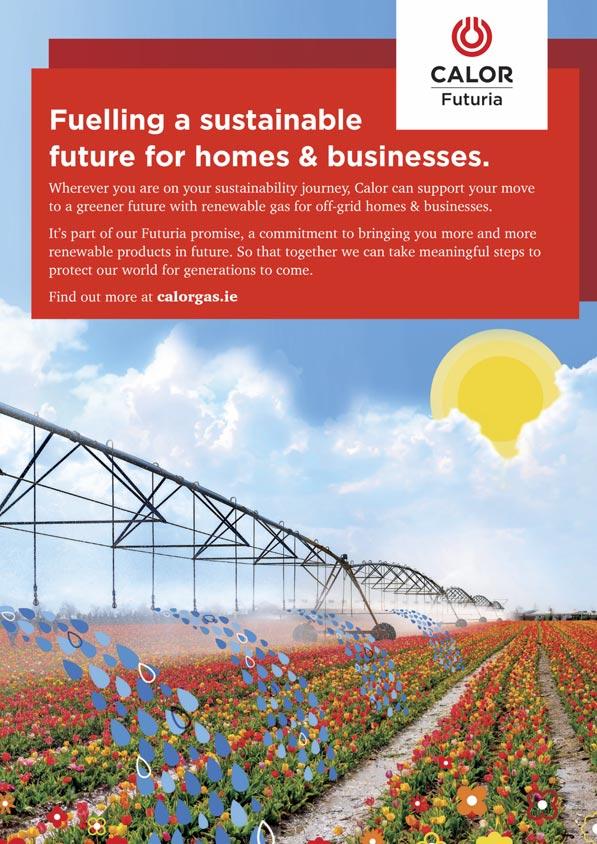
A route to market
In 2016, the closure of the Northern Ireland Renewables Obligation (NIRO), a support scheme designed to boost the generation of renewable energy, coincided with the region’s soaring reputation for renewable generation across the globe.
Far from coincidental, the scheme had served its purpose in incentivising investment in, for the most part, onshore wind turbines. Onshore wind aided Northern Ireland to far exceed targets set for renewable electricity generation in 2020 and is largely responsible for renewable electricity levels reaching over and above 50 per cent by the end of 2022.
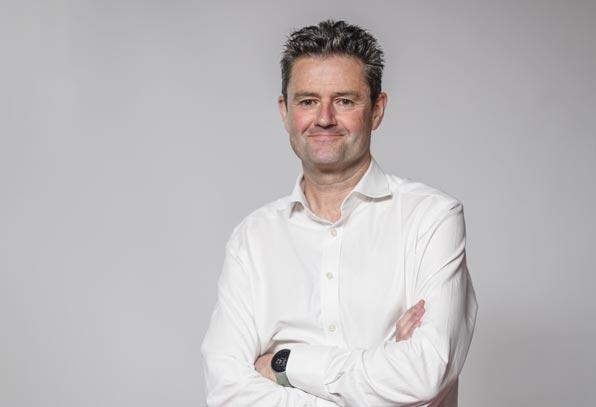
However, since 2016, Northern Ireland
has shifted from leading to lagging in renewable generation, a fact articulated by the Department for the Economy’s Head of Energy Richard Rodgers.
On why the shift has been so dramatic, Rodgers contends that Northern Ireland, as a region, failed to grasp the economic opportunity that presented itself in the form of renewable incentivisation. However, the Deputy Secretary is adamant that the opportunity still exists, so long as the region moves at speed.
In the wake of the NIRO scheme, as Great Britain and the Republic of Ireland delivered fresh supports, work on revised renewable supports for Northern Ireland were put into stasis as
a public inquiry dealt with the fallout out of the failed Renewable Heat Incentive (RHI) scheme.
“RHI stopped a lot of things in their tracks, which is much of the reason as to why we have gone from being a leader in this area to being behind all of our neighbours. Looking forward though, the drive to a totally decarbonised energy system for this region is now much more focused.”
In March 2023, the Department for the Economy published its second iteration of the annual energy action plans, necessitated by the overarching Path to Net Zero strategy published in December 2021. Included in the 2023 action plan is a pledge to publish the final design of renewable electricity
Following the publication of the Energy Action Plan 2023, Head of Energy for the Department for the Economy in Northern Ireland, Deputy Secretary, Richard Rodgers, discusses the need for acceleration towards a totally decarbonised energy system.
44 renewable energy magazine
support, along with a pathway and timeline for the support being in place, within the year.
Describing the support scheme as “critical” to putting energy policy to effective use, creating the conditions for investment, and delivering consumer protections, which are lacking today, Rodgers says: “This is so important because everyone can see that the current market is delivering high energy prices, that we, as consumers, are forced to pay.”
The final design of the support scheme, along with a timeline for the support being in place, is expected by the end of 2023. It is understood the support will target offshore wind generation, but Rodgers explains that the Department’s vision is for all future renewable generation technologies to potentially fall under the scheme’s remit.
“The launch of the design is going to be a critical path to getting offshore wind by 2030, but it has implications for all other energy, such as geothermal and biomethane. It is a design for electricity, but essentially the same principles apply to all the energy we produce.”
Asked about the potential shape of the scheme, Rodgers says that the principles are similar to that of the Contracts for Difference (CfD) scheme used in the UK, or the RESS scheme in the Republic of Ireland, whereby the aim is to competitively establish a strike price that will be payable over the lifetime of the asset.
Although it was originally touted that Northern Ireland may be part of the UK’s CfD scheme for offshore, the unique circumstances of the region meant that the decision was not taken forward. Use of CfDs has been trending
across Europe because of recognition that they prove cost-effective for consumers, while offering long-term price stability that investors require to cover upfront costs.
Rodgers believes that learnings from both the UK’s and the Republic of Ireland’s schemes mean that Northern Ireland has the opportunity to do better for consumers and investors, in the scheme’s design. For example, the absence of indexation in the Republic of Ireland’s RESS has pushed prices up. Similarly, shorter contract lengths in other countries have been recognised as an obstacle, while auction frequency and eligibility criteria are also critical.
Action Plan 2023
The action plan sets out progress made by its predecessor, the 2022 action plan, but also flags a number of 2022 actions which were not achieved, and so have been rolled over.
While many may point to the absence of a functioning government in Northern Ireland, as well as the recently published ‘restrictive’ budget for public services, as cause for delay, Rodgers is quick to point out that the Department’s work is progressing on a solid foundation.
“A huge positive is that the Executive approved the overarching energy strategy, which means we have an agreed and accepted vision for where we want to get to: self-sufficiency in affordable and renewable energy. The prize, which is crucially important in today’s global energy market, is that we can become our own price maker, and not a price taker.
“That vision, which underpins the economic opportunity in selfsufficiency, provides us with the opportunity to tackle fuel poverty and boost economic growth. It is a very exciting prospect.”
Importantly, underpinning the Department and wider Government’s vision is legislation in the form of the Climate Change Act (Northern Ireland) 2022 and the draft Northern Ireland carbon budgets and recommended annual emissions for each sector, produced by the Climate Change Committee.
Asked about the pace of decarbonisation, in comparison to neighbouring countries, Rodgers states: “We must move fast because we want to be part of enabling supply chains, not waiting at the back of the queue. That is why our action plans are so important, they are setting out what we are aiming to deliver now.”
Rodgers accepts that the absence of a Northern Ireland Executive and Assembly could be a barrier to future progress, highlighting the need in the near future for legislation in areas such as offshore wind, or hydrogen, he adds: “That is not stopping us from getting on to be ready for those technologies right now.”
Offshore wind
In January 2023, the Department and the Crown Estate issued a statement of intent on a commitment to establishing offshore wind leasing for Northern Ireland. The statement signalled progress on the Energy Strategy’s ambition to generate 1GW of offshore by 2030. Around the same time as the statement, the Department published its draft Offshore Renewable Energy Action Plan.
Rodgers describes the statement as a “sign of real intent”, outlining the focus on what can be done in the absence of political leadership, building on the elements approved by the previous Executive. Interestingly, Rodgers says that the 1GW is an ambition which could soon be enhanced, stressing that it is the enabling components of creating an offshore wind market, which are most valuable.
4 45 renewable energy magazine
“We must move fast because we want to be part of enabling supply chains, not waiting at the back of the queue. That is why our action plans are so important, they are setting out what we are aiming to deliver now.”
“What we need is a route to market for an abundance of offshore wind, which is not just about meeting our own current needs, but also attracting new manufacturing opportunities and producing the sustainable maritime and aviation fuels of the future.”
Heat
On progress made to date under the annual action plans, Rodgers lists the approval of permitted development rights for heat pumps, as early stages of aligning Northern Ireland with the rest of the UK and the Republic of Ireland in enabling heat pumps to be in every home in Northern Ireland, if policy assesses this as the most cost effective route to domestic heat decarbonisation. The Head of Energy explains that the potential benefits expand beyond environmental benefits alone and could be a huge economic opportunity. Highlighting a number of indigenous businesses which are already serving as disruptors in the British market, Rodgers says: “The benefit of this is not
just the expansion of the footprint of a single business, but the 50 or so local companies which are in the supply chain. That is the 10X economy in action.”
Another big advantage of market creation, Rodgers explains, is the enablement of a pathway for skills development. An energy skills audit, proposed in the 2022 action plan, was published in June 2023.
The Deputy Secretary believes that a real opportunity exists for tertiary education, and indigenous companies, to create an eco-system of skills development for a net zero future, much like the software clusters which exist now, and building on Northern Ireland’s historic reputation for quality engineering.
“The real question is: how do we enable these innovative companies?”, Rodgers asks. “I think a point which is really worth stressing is that unlike the past, where Belfast was a central hub for manufacturing and engineering, the
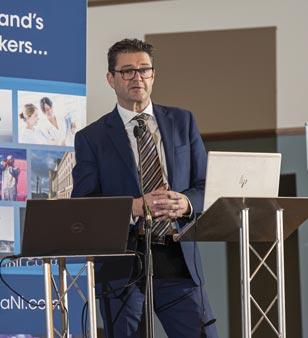
innovative companies which exist currently are spread across the region. By fostering more organisations like this, we have a real opportunity to drive economic growth on a regional basis.
“We can bring back the manufacturing we lost when we have an abundance of renewable energy, but we cannot have that abundance of renewable energy unless we have a route to market for the investment. That is where technologies like offshore wind, heat pumps and hydrogen provide that pathway. However, in order to make that happen, we need to be giving signals to industry that there is a longterm and sustainable future for these technologies in Northern Ireland.”
Resources
In a time of serious budget constraint, Rodgers believes that the finite resources in public services must be focused in the right areas in order to offer those signals to industry. To this end, he believes a truly joined-up approach across government, with a multi-year commitment is the solution to driving forward on missed targets under the 2022 action plan, such as the launch of domestic and business energy efficiency schemes.
Rodgers says that he is keen that investment in these schemes is a priority for a new Executive, to leverage private investment and create a multiplier effect for local communities, skills development, and the local economy.
“I am confident that if we create the conditions for the innovators in this region, it will not take much to succeed in moving the dial on our decarbonisation journey,” he states.
He concludes: “Going back to our 10X economic vision, we want to be one of the elite small economies in the world. That means increasing GVA, so not just creating jobs, but creating high-value jobs, much like the software cluster has done.
“That work can inform and enable the energy revolution. Our solution must be to focus on our strengths and create the right atmosphere to foster innovation, investment and ultimately, economic growth.”
46 renewable energy magazine
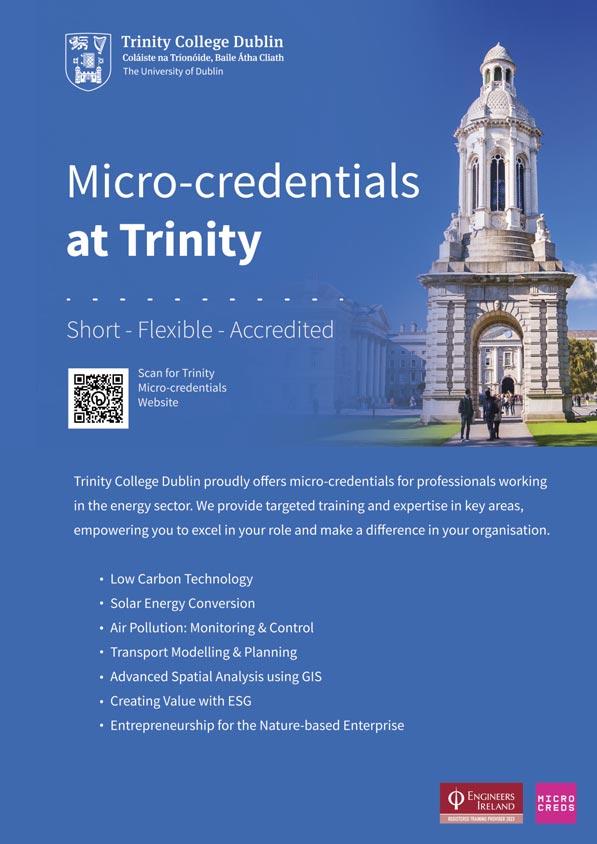
Kevin O’Sullivan: Supergrid super solution
cooperation, and with a very quick payback period. I was very interested in how much we spend on fossil fuel subsidies. Diverting all that funding could really accelerate development of the supergrid. It is in all our collective best interest. It is not for one particular company or one particular transmission operator to benefit, but we still do not have the breakthrough yet.
Now just to underline, most people say, ‘oh, yeah, we need the supergrid, we need cooperation’. But this book is saying that we need a high degree of innovation, using materials that can transmit power without resistance over vast distances with no loss. That is the essential part. It is not saying we will have a grid and we will use traditional cabling in the form of copper wires, it is saying we must make that big leap.
CG: Am I right in saying that the central thesis is connecting Europe’s best renewable sources – northern Europe’s offshore windfarms and southern Europe’s solar PV?
Launching Supergrid Super Solution: The Key to Solving the Energy Crisis in February 2023, Tánaiste Micheál Martin TD asserted: “I [have] articulated the idea of the supergrid as the only ultimate way to go over the next number of decades.” Ciarán Galway speaks with the book’s coauthor and current environment and science editor of The Irish Times, Kevin O’Sullivan about the concept.
Ciarán Galway (CG): Could you begin by explaining how your book –Supergrid: Super Solution – came about?

Kevin O’Sullivan (KO’S): Eddie O’Connor [SuperNode Chair] rang me this time last year [May 2022] and said, ‘I am thinking about writing a book’. It was very interesting in the sense that he wanted to outline the need for the supergrid in the global context, in the climate context, and in particular, the context of continuing kowtowing to the
fossil fuel sector. Within a very intense three-month period, we produced the book. It is not going to be a best seller, but its purpose is to sell the big idea. Eddie believes – and this is what really attracted me – that this is a big idea that will transform not just Ireland but transform Europe and with every chance that others will follow if Europe succeeds in generating the supergrid.
I am very conscious of the slowness of getting things done, so we produced a blueprint in this book about how it can be done properly, with a high degree of
KO’S: Absolutely. There is perfect complementarity with those two sources. In other words, in winter, we are likely to have high wind in the North Atlantic, which is the primary power source when solar might not be so predominant. Then in summertime, when we are likely to have low wind, we will have vast amounts of Mediterranean solar PV resources, not just within Europe, but across north Africa. There is a graph in the book from the International Energy Agency. When Eddie saw that graphic, he was gobsmacked because it shows how each source resonates perfectly with the other.
CG: So the idea is that a variable supply of renewable energy becomes a firm supply. Does that then negate the need for storage altogether?
KO’S: No, the particular element Eddie wrote in the book on the technology side explains that we will need some storage and battery technology. But having the supergrid not only enables total decarbonisation of Europe, but it also means less reliance on batteries and other technologies. And Eddie
48 renewable energy magazine
believes that it can be cost competitive.
CG: The line is to “electrify everything”, but does that really mean everything? Given the chapter provocatively titled ‘Hydrogen: A Major Distraction’, is there a role for hydrogen?
KO’S: The line is really electrify almost everything. But you are right. Summarising Eddie’s view on hydrogen – and I have a slightly different perspective on it – he believes that people, energy companies, and countries are falling for a sort of deception on cost. Contrary to what some of the coverage is, he fully recognises the importance of hydrogen and in particular, green hydrogen, for difficult-to-decarbonise heavy industry sectors. But he just feels that Europe is not going to become the powerhouse of green hydrogen –even though there is evidence that it is gearing up for that – because of price. Eddie is saying that we will get our hydrogen from solar in particular and from obvious places that can compete on price, whether it is Africa, the Middle East, or South America. Therefore, he believes that there is a dominant view within Europe that is fundamentally wrong. He is actually saying that when we generate all our offshore power, that it will be power that we transmit to Europe, not hydrogen, and that the cost case will be very clear on that.
CG: In October 2022, in A Power System for a Carbon Neutral Europe, ENTSO-E wrote that, “the [supergrid] concept could materialise for bulk exchanges with neighbouring countries if geopolitical conditions will allow it”. To what extent then has the Russian invasion of Ukraine brought us all into sharper relief?
KO’S: The Russian invasion has concentrated minds greatly. And I think even within the national mindset of Ireland, that has been the case because our energy security has been exposed to a very grave extent. That has broken down a lot of the barriers and there is a greater sense of urgency. As you know, Ireland is supporting the Ostend Declaration in terms of building a meshed offshore grid. Now, it has not made the jump in terms of saying what technology will be deployed and I think it should, in that it must use the best available technology. I think superconductors are proven; they are not just a theoretical concept. Now, they must be scaled up and that that is accepted. We need to scale up to the
point where we can transmit vast amounts of power over hundreds and hundreds of kilometres using a meshed grid. The argument in favour of a meshed grid is widely accepted now, which is good. How exactly that is constructed and connected to individual countries and put offshore is the challenge.
CG: What are the barriers in an Irish context? I know Eddie O’Connor has previously mentioned or referenced bureaucratic inertia.
KO’S: Eddie has no time for any future investment in fossil fuels. He thinks we have been conned for far too long, the scale of the damage is appalling in terms of the planet, and the quicker we have a path away from fossil fuels, the better. It is fair to say the fossil fuel
down this renewable route, we are going to stop exploration, and we are going to stop fossil fuel subsidies and redirect all that money, not to just towards development of renewable technology, but obviously towards a just transition’. There are very obvious steps for Ireland to pursue.
CG: With regard to the technology, where is the research focused at the minute?
KO’S: The research is at a very interesting stage, because it is at scale up towards commercialisation and that is outlined in the book. We are talking about commercialisation within a decade. A lot of the work is done around insulation, because it is necessary to reduce the temperature by so much for this superconductivity effect. Obviously, the best installations are required. But also, it is very interesting the extent to which transmission materials like yttrium and gadolinium are so effective. In terms of quantity, much less of them are needed in comparison to say copper. Much of the work is around maximising the efficiency of all that. SuperNode is just one player, but it is certainly at the cutting edge. Recently, it announced a very interesting collaboration with CERN, and I think that is a really amazing coalition and that will help shorten the timeframe. SuperNode has a facility close to the M50 at the Red Cow roundabout where it is actually scaling up the length of these transmission devices and also optimising the best use of insulation.
CG: Where does the rubber hit the road and the supergrid become reality?
sector has reasserted itself during the energy crisis. And from my own perspective, it has engaged in an appalling rolling back of its renewable targets, and most of the big players are guilty of that. That is the climate battle being fought. Ireland must step up and say, with greater clarity, ‘we are going
KO’S: The rubber hit the road yesterday. The level of investment is about €10 or €11 billion within those projects alone, and the amount of energy is very significant in sense of how many homes would power in the shorter term. It is a question of building on that. The book really highlights the offshore elements in the sense that it is the option to accelerate. Yes, we must have onshore and yes, we must have all the different solutions to decarbonise and to address our greenhouse gas emissions. But the scale of our exclusive economic zone is such that we have huge potential, and the technology is improving all the time. That is where we need to concentrate our efforts and that is where we get the quickest return.
49 renewable energy magazine
“It is fair to say the fossil fuel sector has reasserted itself during the energy crisis. And from my own perspective, it has engaged in an appalling rolling back of its renewable targets...”
Kevin O’Sullivan, coauthor of Supergrid Super Solution: The Key to Solving the Energy Crisis
Budget 2024 is our last chance to accelerate Ireland’s energy revolution
For us in Ireland, that means speeding up the delivery of the renewable energy that will replace harmful fossil fuels, shifting more of our energy consumption to electricity generated from those renewables, and empowering people and communities to play a more active role in this energy revolution.
Budget 2024 provides the Government with an opportunity to invest resources in the key building blocks for an Ireland which is energy independent and well on the way to net zero.
Planning
An Bord Pleanála has not approved a single new wind farm in nearly a year. Every day lost means higher electricity prices, more carbon emissions, and greater dependency on imported fossil fuels but critically needed wind farms are still waiting more than 18 months for a decision.
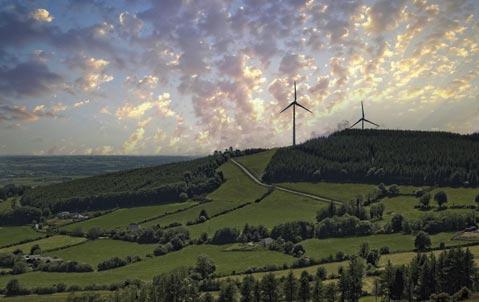
Ireland has huge potential, and the ambition, to be a renewable energy leader. We are already a world leader in the development of onshore wind energy.
There are more than 11,000MW of onshore wind energy projects at various stages of development right now, all hoping to deliver by 2030 if they can get through the planning system.

Momentum is growing behind Ireland’s offshore wind energy revolution with the first six new offshore wind farms due to apply for planning permission before the end of the year.
In the next two to three years, our planning system will need to deal with applications from literally dozens of wind
A summer when the impact of climate change is dominating global and national headlines, from heat waves to wildfires to flooding, should encourage us all to accelerate ending our reliance on fossil fuels which is at the heart of the problem, writes Wind Energy Ireland CEO Noel Cunniffe.
Ireland is a world leader in the development of onshore wind energy.
50 renewable energy magazine
Credit: Kevin Barrett
farms, solar farms, and grid reinforcement projects. These are big and complicated pieces of infrastructure. They must be thoroughly and fairly examined by people with the right expertise.
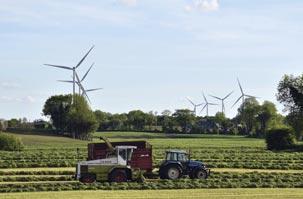
But if our planning system is struggling now to cope with the demands placed on it, how will it manage to respond to projects of greater complexity, and in greater volume, than it has ever dealt with before?
The Government must give the planning system the resources it needs to ensure applications are thoroughly, but quickly, processed. That means agreeing with An Bord Pleanála, the NPWS, MARA, and local authorities involved in assessing renewable energy projects the number of staff, with the right expertise, they will need to achieve our Climate Action Plan targets.
These resources are a vital investment in our future, not a cost. If we do not do this, we cannot hit our Climate Action Plan targets. It is that simple. We will fail.
Electrification
If, and when, this renewable energy is flowing we need to have a society that can use the electricity generated. This means having the grid infrastructure in place to distribute the energy to our homes, businesses, and transport systems. All of these need to change to electricity as their source of power and away from polluting fossil fuels.
Budget 2024 is an opportunity to provide adequate funding and financial incentives for key infrastructure like EV charging points, facilitating commercial car fleet electrification, industrial and domestic heat electrification, and thermal storage.
A zero carbon electricity system, while essential in itself, is also the key prerequisite to decarbonising how we heat our homes and businesses, how we travel to work and to school. Every new heat pump, every new electric vehicle, every public transport network we can electrify, cuts our carbon emissions and accelerates the transition to a truly independent and secure Irish energy system.
Alongside investing in the resources and infrastructure required to support our energy transition, attention should be given to how we properly inform people about the scale of the challenge to be faced in every community across Ireland.
Communications
That is why we are calling on the Government to establish and fund a National Climate Emergency Communications Unit in Budget 2024. Whether it is increasing our usage of electric vehicles, supporting active travel, or installing solar panels, educating businesses and communities about sustainable solutions should be at the forefront of our efforts to inspire people to change.
The whole-of-government communications response to the Covid19 emergency is an example of a successful campaign, which tried to ensure people had the information they needed to respond to difficult and complex circumstances.
We need creative marketing and communications campaigns that carry the urgency and the seriousness of the challenges before us into every home around Ireland. We have no time to lose, every one of us has a responsibility both
to act but also to advocate, to demand action from leaders in politics, business, and industry to accelerate the revolution and to cut our carbon emissions.
Ireland’s energy revolution can be a national success story, but it will not happen without the right resources.
The good news is that if the investment is there, if government, industry, and communities work closely together, we can and will deliver the Climate Action Plan targets and make Ireland a true leader in renewable energy, attracting leading businesses, providing cleaner air for all of us, and providing warmer homes for the people of Ireland.
Energy independence is within our grasp if we are willing to reach out and take it.
T: 045 899 341
E: office@windenergyireland.com
W: www.windenergyireland.com
“We need creative marketing and communications campaigns that carry the urgency and the seriousness of the challenges before us into every home around Ireland.”
51 renewable energy magazine
Communities must be empowered to be part of Ireland’s energy revolution.
Accelerating the energy transition
Contextualising Ireland’s 1.9 per cent reduction of CO2 emissions in 2022 within the EU’s 2.4 per cent reduction for the same period, Ó Gallachóir explains that Ireland’s energy system experienced different dynamics to the rest of Europe, where emission reduction was driven by a 19 per cent reduction in gas demand.
Despite Ireland’s positive performance, Ó Gallachóir expresses concern around “the blind spot we have in consumption growth, which is impacting our emission trajectory relative to our ambition”.
Carbon budgets
Ó Gallachóir describes the introduction of carbon budgets as a “gamechanger”, due to the increase in
ambition and governance in how Ireland aims to achieve its emission reduction targets.
Under the first climate budget framework Ireland needs to remain within 295 MtCO2eq emissions during 2021-2025, however, GHG emissions for 2021 and for 2022 indicate that Ireland is some 10 MtCO2eq over budget for those first two years.
“We have passed by 40 per cent of the time of the first carbon budget but we have emitted 47 per cent of the overall carbon budget,” he explains.

“In broad terms, we have been emitting 70 MtCO2eq per year, meaning that in the final three years, we have an average budget of 52 MtCO2eq per year, requiring a significant reduction.
“We need to accelerate the energy transition,” he states.
Energy
Focusing the emission lens on the energy sector, the Associate VicePresident says that for sectoral emissions, the introduction of carbon ceilings is also “game-changing”. Energy now accounts for just under half of Ireland’s greenhouse gas emissions, incorporating transport (17 per cent), electricity (14 per cent), and the thermal heat sectors of buildings (11 per cent), and industry (6 per cent).
To date, electricity has been Ireland’s greatest decarbonisation story, achieving a 45 per cent reduction
Associate Vice-President of Sustainability at University College Cork, Brian Ó Gallachóir, outlines Ireland’s performance with the current carbon budgets and ceilings and asks whether a greater focus needs to be put on reducing consumption and climateproofing industrial and economic policy.
52 renewable energy magazine
between 2005 to 2020, despite a 12 per cent growth in electricity demand.
Despite this progress, Ireland is furthest off track in relation to its electricity ceiling target, prompting Ó Gallachóir to suggest the existence of “blind spots” within ambitious decarbonisation efforts.
“We are ignoring the need to rapidly reduce energy consumption and that is a key challenge,” he says.
In the two years which have passed included in the fiveyear carbon ceilings periods (40 per cent of the time), Ireland has used 49 per cent of its electricity emission ceiling, 42 per cent of the transport emission ceiling, and 47 per cent of the industry and buildings emissions ceilings.
“We have a real challenge to bring ourselves back on track in terms of those sectoral emissions ceilings and we need to understand the reasoning behind those numbers. Transport, for example, looks like the sector which is closest to being back on track but if you remember the spring of 2021, the country was essentially in a lockdown scenario, and that context is not captured in the numbers.”
The challenge for each sector is clear. For electricity Ireland needs to move from 10 MtCO2 of annual average greenhouse gas emissions in 2021 and 2022 to 7 MtCO2 between 2023 to 2025.
For transport, the reduction required is 11 MtCO2 of annual average greenhouse gas emissions in 2021 and 2022 to 10 MtCO2 between 2023 to 2025.
Buildings and industry will require a move from 15 MtCO2 in 2021 and 2022 to 11 MtCO2 between 2023 to 2025.
Source: UCC
Ó Gallachóir points out that these challenges are not without policy direction and welcomes the shift to an annual iteration of the Government’s Climate Action Plan to build in flexibility.
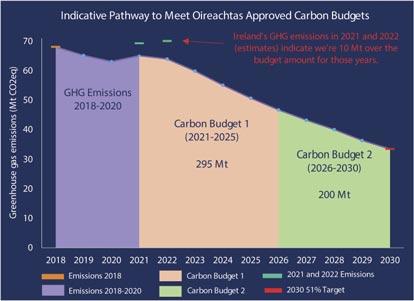
Electricity
Discussing what is needed if the electricity sector is to stay below its sectoral ceiling, Ó Gallachóir points to the obvious need to accelerate renewable electricity deployment, but also be conscious of how supply is being maintained when renewable generation is not available.
“We have to move towards a trajectory of increasing our share of renewable electricity but the other part of the electricity mix, and how we make up that shortfall, is very important. One of the reasons we have overshot our annual emissions within the ceiling so far is around how coal has displaced gas in the last couple of years relative to 2018/19.
“In 2022, gas use in Ireland increased as oil, peat, and coal demand decreased. This represents a positive trend of emission reduction, but it is also one of the reasons our gas demand has not reduced in the same way it has across Europe.”
On the need to reduce electricity consumption, Ó Gallachóir raises the question as to whether industrial and economic policies are fully cognisant of how things like data centres are having a unique impact on Ireland’s electricity growth, relative to other member states. Similarly, he highlights the conundrum that is that while the co-benefits of emission reductions are best targeted at those in experiencing energy vulnerability, those of higher disposable incomes tend
53 renewable energy magazine
GHG emissions for 2021 and 2022 indicate Ireland is 10 Mt over budget for the first two years of the carbon budget
4
to be the largest emitters and have greater capacity to take advantage of available grant supports.
Transport
Renewable energy use in transport grew by over one quarter in 2022 relative to 2021, driven mainly by use of biofuels. This growth, however, mitigated only 1 per cent of a 7 per cent growth in transport emissions for 2022.
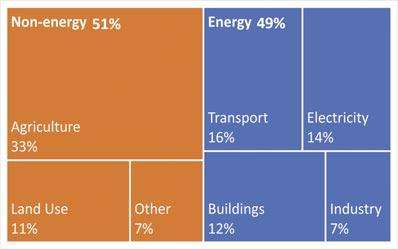
Flagging another potential blindspot, Ó Gallachóir, while welcoming the impressive uplift in EV sales in Ireland in recent years highlights that something which is often not part of the narrative is even larger growth of SUV sales. SUVs are now more than 50 per cent of new car sales in Ireland.
“While we are seeing progress in emission reduction in key areas, it is clear that if we only focus on those key areas, we are not going to achieve the overall change we want to.”
Similarly, he highlights the co-benefits of the promotion of active travel and public transport in not only reducing emissions but reducing car dependency. To this end, he highlights a focus on accelerating EVs as a positive step, but states that this must be done in conjunction with the displacement of private car travel.
He adds: “While our national emissions targets are
set around road transport, reduction of our overall transport emissions will also require a rethink of maritime and aviation policy.”
Heat
In 2022, the share of renewable heat in Ireland went down by 6 per cent, placing Ireland at the bottom of the European league table in this regard. While a reduction of overall heat demand in 2022, could be seen as a positive, the reality is that this reduction was largely driven by high energy costs, and not by a conscious effort to reduce emissions. Explaining that the acceleration of retrofitting, the electrification of heat and renewable heat generation are critical to emission reduction and meeting the sectoral targets, the academic is also quick to point out that efforts to reduce heat demand must be tailored in a country where winter excess mortality rates remain a challenge.
Concluding, Ó Gallachóir says: “We need to accelerate renewable electricity, electrification, and retrofitting but we also need to have a stronger focus on reducing consumption, promoting and encouraging demand reduction, but we also need to climate-proof some of our industrial and economic policies in terms of what type of organisations and activities we are attracting to Ireland.”
54 renewable energy magazine
Ireland's total GHG emissions 2021= 69.3 MTCO2eq
Source: UCC
“We have to move towards a trajectory of increasing our share of renewable electricity but the other part of the electricity mix, and how we make up that shortfall, is very important.”
The Irish biomethane sector requires policy and action to mobilise
The remit of the Irish Bioenergy Association (IrBEA) covers the bioenergy sectors of biomass, biogas/biomethane, biochar, biofuels, energy crops and wood fuels. As a representative organisation, IrBEA has members across the full biogas/biomethane supply chain including feedstock suppliers, project developers, technology providers, consultants, and end users.
Biogas is produced using anaerobic digestion (AD) technology to convert organic waste to energy and biofertiliser. The biogas can be upgraded (impurities removed) to make biomethane.
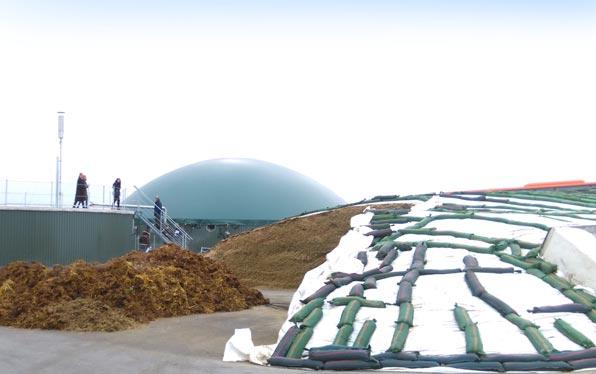
Biomethane can be injected into the gas grid and used as a transport or heating fuel. AD technology can be deployed at varying scales utilising a wide variety of feedstocks.
In the Republic of Ireland, there are up to 20 biogas plants operating with over 70 in Northern Ireland. Biogas production is a mainstream industry in many European countries.
Support required
There are currently no government supports available for biomethane production. A support mechanism is required by the industry to bridge the gap between the cost of production of biomethane and price of fossil gas. A large scale biomethane sector will see AD plants centrally located with feedstocks sourced within a plants hinterland. IrBEA’s vision is for the Irish biomethane industry to be mobilised on a phased basis.
Key items for success
Biomethane production must address agricultural sustainability. Everyone along the supply chain must receive a fair return. It needs to complement rather than compete with mainstream food production. AD plants must be geographically spread, and reliable technology be used. Developers need to ensure that there is appropriate community engagement. There are a few regulatory and planning consent challenges that need to be addressed also.
Biogas addressing agricultural and industry challenges
Due to the Renewable Energy Directive, a mix of feed stocks are required to satisfy the directive’s sustainability criteria. The co-op model should be utilised as a structure which farmers know and trust for the collection and mobilisation of feedstocks. By utilising digestate as a biofertiliser, the agriculture circular economy is being promoted. Biomethane will be a key enabler of emissions reduction and
decarbonisation in the processing and industrial sectors by displacing fossil fuels.
The supply chain is ready
The supply chain is ready to deliver. The mobilisation of an Irish biomethane industry lies firmly in the hands of the Government and key policymakers. Leadership from government and policy is required to kickstart this industry which would provide real opportunities and benefits for many as well as jobs, economic activity, renewable fuel, and biofertiliser to name but a few.
Seán Finan Chief Executive Officer Irish Bioenergy Association (IrBEA) E: seanfinan@irbea.org


55
renewable energy magazine
Biomethane in Denmark
Christian Bendrup Faurholt, project manager and country lead, Energinet, explains how Denmark has been able to achieve an unprecedented level of integration of biomethane into its gas networks.

Energinet is the transmission system operator (TSO) of Denmark’s gas and electricity network. Owning, operating, and developing the transmission grid in Denmark, Energinet has responsibility for the overall security of supply as well as the system balance of electricity and gas in the Nordic state.

The organisation is an independent public enterprise, owned by the Danish Ministry of Climate, Energy and Utilities. One key difference between Denmark and Ireland is that whilst Energinet operates Denmark’s transmission grid, another group, formerly part of Energinet, operates the distribution grid.
Faurholt explains that creating a robust energy system is a “balancing act”. “We call it the energy trilemma,” he says.
“A robust energy system must be secure and reliable, environmentally sustainable, and affordable and accessible. This is what Energinet, and the rest of the energy industry, are trying to achieve.
“Our entire mission is transforming the energy system, so it is based on 100 per cent renewable energy, without compromising on security of supply. Our goal is ensuring that this is done in a way that is affordable for society and individual consumers.”
Denmark’s gas system
With 58 biomethane facilities already fully operational in Denmark, the share of renewable power and gas is already very high in Denmark. Faurholt explains that this has been achieved “while maintaining zero failures in gas supply
56 renewable energy magazine
and an electricity security of supply of 99.996 per cent”, further outlining that they have two gas storage facilities; one aquifer and one salt cavern.
“Towards 2030, Energinet is actually expected to reduce the security of supply to 99.993 per cent as we increase the levels of renewable power in Denmark. Our current strategy, Energy in Time, heavily emphasises the importance of security of supply. This is where biomethane becomes incredibly important, because if we in Denmark want to achieve our climate targets and become carbon neutral by 2045, biomethane will play a pivotal part in achieving that.”
The Energinet project manager outlines how political ambitions have been critical for Denmark’s development of biomethane and integrating it into the country’s gas network. “Our government has been a strong driver. Back in December 2021, the Danish Government outlined the ambitions for reaching 100 per cent of our gas consumption coming from biomethane by 2035,” he explains.
“Due to a combination of factors such as the war in the Ukraine and a limited supply of Russian gas, as well as decline in general gas consumption in Denmark, we can probably reach that target by 2029 or 2030.”
In 2022, 39 per cent of Denmark’s gas consumption came from biomethane, up from 33 per cent for 2021. “That rate of development has been pretty good,” Faurholt states, “but the key element of this has been a combination of both biomethane facilities being connected to the grid and general gas consumption declining.”
Whilst the “vast majority” of Denmark’s biomass has been produced from manure, Faurholt sees a “greater potential for development of biomethane from deep litter and straw biomass mix, as well as food waste and industrial waste”.
Five steps to 100 per cent biomethane coverage
The vision for the increased usage of biomethane in Denmark has five steps, all of which are based on milestones in gas infrastructure development. These steps are:
• local;
• upgraded;
• transmission;
• interconnected; and
• continental.
Currently, Denmark is at step four, meaning that further action is needed before progressing to the next step. “This is our potential for further development, which can contribute to achieving 100 per cent biomethane coverage,” Faurholt says.
“With the local step, the most important thing is ensuring that there is a connection between the consumers and the producers at a local level. The second point is that you need to upgrade this connection and inject the gas into the distribution grid.”
With the transmission grid, Faurholt outlines that “you want to think about having a subsidy scheme for producers”. “At this step, you inject the gas into the transmission system and make sure that the gas quality of the biogas is the same as the standards you have for natural gas. When this is done, you can start to phase out the previous subsidy scheme.”
The interconnected step is the current step in Denmark’s biomethane transition. “We have interconnected to Poland and want to interconnect to Germany too,” Faurholt states.
“However, a stumbling block exists currently as, in Denmark, the oxygen level allowance for biomethane is 0.5
per cent whereas in Poland this is 0.2 per cent, and in Germany, it is less than 0.01 per cent. Faurholt believes that there are “grounds for good discussion in the European Union of getting a common standard for oxygen levels”.
When this step has been completed, the final step will be the development of interconnections between continents, which Faurholt states is where “Energinet is aiming to be”.
Conclusion
Concluding, Faurholt outlines his belief that subsidies are necessary to ramp up biomethane production and that large scale production of biogas and biomethane creates flexibility in an energy market.
“Byproducts from the agricultural sector such as manure will be considered a resource and not waste, revolutionising the rural economy. This is why we need sector-coupling perspectives between the agriculture and energy sectors.
“Doing this requires leadership from industrial gas-users on promoting biomethane and ensuring that there are those arguing for the needed regulatory/legislative development.
Doing all of this, the big advantage is the dramatic improvement of security of supply by decentralising supply from biomethane production.”
57 renewable energy magazine
“Our entire mission is transforming the energy system, so it is based on 100 per cent renewable energy, without compromising on security of supply.”
Unlocking Ireland’s solar potential
Akash Bais, Key Account Manager, Utility and C&I, Ireland for SKE Engineering GmbH, discusses the evolution of Ireland’s solar industry and

Established as a leading organisation within the European solar market, PV specialist SKE is expanding in the Irish market, in parallel with the growing contribution of solar to Ireland’s energy transition.
The growth of Ireland’s solar industry has been highlighted by the inclusion in the Government’s Climate Action Plan 2023 (CAP23) of a target of 8GW solar generation by 2030, and Bais believes that SKE’s global expertise will play a huge role in assisting Ireland’s solar journey.
Founded in 2008, SKE is an Austrian-based

company and a value-added partner (VAP) of Huawei, with responsibility for distributing products in the middle and southeastern European market, as well as Ireland and the UK.
Serving 16 countries ranging from Albania to Croatia, Austria, and Cyprus, SKE is responsible for all sales and services activities for Huawei FusionSolar, and as Bais explains, supports customers throughout Europe.
While the solar sector in Europe is still at an emerging stage, it is the source of energy
the innovative technology set to drive growth.
58 renewable energy magazine
growing at the highest pace in the EU. In 2021, 5.7 per cent of the EU’s total electricity production came from solar energy and it is estimated that, over the decade from 2010 to 2020, the cost of solar decreased by some 82 per cent.
The European Green Deal and the REPowerEU plan have turned solar power into a building block of the EU’s transition towards clean energy, while CAP23 has clearly outlined the enhanced role of solar technology in relation to capacity, flexibility, and affordability.
Explaining that SKE offer products for residential, commercial, and industrial (C&I) and utility markets, Bais says: “SKE always strives to provide the best possible pre and after-sales service to its customers,” he says. “Our technical sales management provides all SKE partners with in-depth product knowledge via dedicated roadshows and hands-on practice training.
“Our highly experienced key account management team supports our corporate accounts within the Irish market.”

Innovative new products being offered by SKE includes three levels of Huawei FusionSolar PV systems. Outlining the systems, Bais says: “Huawei FusionSolar Residential is an intelligent PV technology for solar energy generation in private living areas. While Huawei FushionSolar C&I is a smart PV technology for commercial and industrial infrastructures and helps businesses become independent of unpredictable electricity prices.
“On the larger scale, Huawei FusionSolar Utility Scale is the leading technology for solar power generation with large-scale PV systems.
“Every Huawei FusionSolar PV system
PV
is a smart investment for maximum yield and return. We have LUNA2000 series storage system from 5 kWh to 2 MWh capacity, they can easily cover the range from residential to utility scale.
“They are easy to install, reliable, and powerful. The perfect backup for the future.”
Irish market
Acknowledging the high potential for solar PV projects in Ireland due to its geography and demography, the Key Account Manager points to recent government incentives which have helped to drive solar technology in Ireland including the expanded NonDomestic Microgeneration Scheme, the domestic Solar Electricity Grant, Targeted Agriculture Modernisation Schemes (TAMS), and the introduction of new reduced EU VAT freedoms to zero value added tax (VAT) on the sale and installation of solar panels for private dwellings.
Highlighting that these incentives will help build upon the good customer engagement already experienced by SKE in Ireland, Bais says that the organisation’s recently held installer event, where new generation inverters were showcased, received a very positive response from partners.
“At the beginning of the 21st century, solar technology in itself was the innovation but today, the development of the technology is much further,” he explains. “It is no longer a matter of producing electricity from sunlight at all, but of making the systems as efficient, durable, and smart as possible.
“Huawei FusionSolar is developing advanced technology such as solar batteries and optimisers for PV systems to do just that. Our goal is to make these innovations available to as many
59 renewable energy magazine 4
“Every Huawei FusionSolar
system is a smart investment for maximum yield and return.”
operators, installers, and dealers as possible. That is why we offer comprehensive consulting services in addition to technology.”
Bais points to a recognisable increase in demand for battery storage in Ireland, as consumers seek to utilise the electricity dual tariff, charging at times of lower cost and discharging at peak times.
“We have enjoyed good success in the rollout of residential batteries, but the last six months have seen a large increase in demand for commerce and industry. Our latest C&I battery of 200 kWh was launched especially for the Irish market to accommodate large organisations ranging from companies to data centres and agricultural sites.
“Importantly, all of the technology of scale is custom built for the customer.”
Bais believes that alongside its
unique selling points which place it as a leader in the Irish market. The first is its offering of a hands-on practice training programme, conducted multiple times per month, giving customers training from SKE’s technical experts.

“HOP, or Hands-on Practice, is the expert training from SKE. This is the main part of the SKEPP, or SKE Partner Program, to become certified and listed as an SKE partner,” he explains.
“The training takes place either at our headquarters in Steyregg, Austria or onsite in the SKE countries. Each training session consists of a theoretical and a practical element and to become a certified SKE partner, everyone without exception must take part and pass the exam.”
The second unique element of support highlighted by Bais are the SKE

60 renewable energy magazine
Roadshow trucks, which are on the road throughout Europe, with a specific truck located in Ireland. “On site, at wholesalers and installers sites, SKE presents the Huawei FusionSolar portfolio, where SKE experts are available to answer any questions.
“In addition to this, SKE utilises a state-of-the-art ticketing system which is being monitored regularly. We have multilingual tech support teams sitting across different strategic locations across Europe to support customers and recent data shows a response time of less than five minutes.”
Growth
Bais is confident the solar industry in Ireland will continue to grow, and points to some key trends he believes will shape that growth.
The first is the cost reduction of solar generated renewable energy, which has been happening in recent years, a trend which he expects to continue: “As technology improves and economies of scale are achieved, the cost of solar energy will become even more competitive with traditional sources of energy,” he says.
The second is the recognisable increase in solar technology adoption. He adds: “As solar energy becomes more affordable and accessible, I expect to see a continued increase in the adoption of solar energy by homeowners, businesses, and governments around the world. This will be driven in part by government incentives and regulations that encourage the use of clean energy.”
Finally, he points to the development of more efficient and cost-effective energy storage systems as a driver of growth. “As energy storage
technology improves, solar energy will become a more reliable and practical source of energy,” he explains. “As energy storage increases, solar energy will increasingly be integrated with other technologies, such as electric vehicles and smart homes, which will create new opportunities for energy management and optimisation and help to further drive down the cost of solar energy.”
Concluding, Bais says: “Overall, I believe that the solar industry will continue to be a major player in the energy sector in the coming years, as technology improves, and the world continues to shift towards clean, renewable energy sources.
“We are pleased that we can already inspire many partners with our concept and the forwardlooking technology of Huawei FusionSolar. Furthermore, we are proud to contribute to the energy transition towards renewable generation with our products and solutions in accordance with our company philosophy and to further increase efficiency with Huawei inverters. SKE not only advises you when it comes to inverters for PV systems, but also supports you in all questions on how to best use them.”
Akash Bais
Key Account Manager Utility & C&I, Ireland


T: +353 87 247 7203
E: akash.bais@ske-solar.ie
W: www.ske-solar.com
61 renewable energy magazine
“As energy storage increases, solar energy will increasingly be integrated with other technologies, such as electric vehicles and smart homes, which will create new opportunities for energy management and optimisation and help to further drive down the cost of solar energy.”
Maritime Area Regulatory Authority established
the expansion of offshore wind infrastructure. Under Climate Action Plan 2023, the Government is committed to expanding Ireland’s offshore wind capacity to 7GW by 2030, which includes 2GW earmarked for the production of green hydrogen. Production of green hydrogen involves the splitting of water molecules, a process which requires heat and therefore requires a renewable source of energy to ensure that CO2 is not emitted into the atmosphere during the process.
The agency is chaired by Laura Brien, who has over 25 years’ experience in regulation and policy, particularly in the energy sector where she has worked for the CRU as a director. Brien is also a member of the Bureau of the OECD Network of Economic Regulators.

Minister O’Brien additionally announced Mark Mellett, the former Chief of Staff of the Defence Forces, as the Chair of MARA.
The new agency will have responsibility for assessing applications for maritime area consents (MACs) which will be required before developers of offshore wind and other projects in the maritime area can make a planning application. It will also be responsible for granting licences for what the Department of Housing, Local Government and Heritage describes as “certain activities” in the maritime area.
The Department states that the establishment of MARA “marks the transition to the new maritime consenting regime and will be a key enabler in respect of Ireland’s ambitions for the offshore renewable energy sector”. MARA will be based in
Wexford in line with the Government’s regionalisation policies under the National Planning Framework.
The agency has been established under the auspices of the Maritime Area Planning Act 2021 (MAP Act), which establishes a new marine planning system, underpinned by a statutory Marine Planning Policy Statement (currently in development), guided by the National Marine Planning Framework, and consisting of a new licensing and development management regime from the high water mark to the outer limit of the State’s continental shelf, administered by An Bord Pleanála, the coastal local authorities, and the Maritime Area Regulatory Authority (MARA).
Implementing offshore wind infrastructure

The establishment of MARA will, the Government hopes, be an enabler of
The agency was established shortly after the results of the State’s first offshore wind auction under the Renewable Electricity Support Scheme (ORESS 1). The auction secured a price for offshore wind production of an average of €86.05/MWh. Over 3GW of capacity will be procured from four projects, enough to power approximately 2.5 million Irish homes with clean electricity and reduce greenhouse gas emissions by over one million tonnes in 2030.
Minister O’Brien says: “MARA will be responsible for regulating development and activity in Ireland’s maritime area and comes about as part of the biggest reform of marine governance in Ireland in almost a century.
“MARA will have in place the process and procedures relating to maritime area consent applications for offshore renewable energy and for marine infrastructure that supports the delivery and deployment of offshore wind projects, such as port development work.”
62 renewable energy magazine
On 17 July 2023, the Maritime Area Regulatory Authority (MARA) was formally launched, following an announcement by Minister for Housing, Local Government and Heritage, Darragh O’Brien TD, on 17 May 2023.
Chair, Laura Brien
Ireland’s solar revolution
Successes
ESB Networks recently stated that solar is “the fastest growing renewable power source in Ireland.” This exciting progress was unlocked by two changes: removal of barriers to rooftop solar; and a route to market emerging for utility scale ground mount solar.
Consumers are placing solar on their homes and businesses at an unprecedented rate. Domestic users are installing an average of 500 systems a week. Commercial players are installing not only kilowatt scale but megawatt scale.
Complementing this rooftop growth has been the long-awaited flourishing of the substantial utility scale pipeline developed by the solar industry. A key enabler has been the Renewable Electricity Support Scheme auctions.
The growing confidence in solar’s potential was reflected by Government increasing the country’s solar PV target from 1.5-2.5GW by 2030, to 5GW by 2025 and 8GW by 2030. Solar is not a
fringe technology but a significant part of Ireland's decarbonisation toolkit, alongside storage and wind.
Opportunities
The question is not whether solar will scale, but how large an industry can be built in Ireland. To facilitate that growth, fundamental decisions need to be taken by the State.
We must build the network to support a zero-carbon system, quickly. Building that grid will deliver the green electrons needed to shape and power the future clean economy of Ireland.
Planning remains a challenge. The system requires resourcing. For example, the national planning authority An Bord Pleanála is struggling to decide on solar planning appeals within the mandated 18 weeks, currently averaging close to 36 weeks, with some cases taking over 70 weeks. 86 per cent of projects are successful in that process, suggesting something needs fixing. There is no pathway to a sustainable
energy future that does not involve Irish farmers. Inconsistencies in the policy framework unnecessarily place these sectors at odds. For example, our taxation framework is not supportive of multiple land uses such as growing food and generating solar in the same field.
Ireland has among the highest cost renewables in the world. We would welcome a review of the policy and state factors influencing those costs. We incur a higher price than needed for our energy transition.
The future is bright for solar in Ireland if we grasp the opportunity.

T: 01 902 0620
E: info@irishsolarenergy.org
W: www.irishsolarenergy.org

Solar’s recent growth in Ireland has been revolutionary.
From 0 per cent in 2022, Sustainable Energy Authority of Ireland (SEAI) statistics showed a day in May 2023 where solar provided 10 per cent of the country’s electricity.
Credit: Statkraft Ireland
63 renewable energy magazine
Ballymacarney solar farm.
Hitachi Energy: Advancing a sustainable energy future for

The signature of the Climate Action and Low Carbon Development Act1 2021 is a major step to support the country’s commitment to decrease its own emissions by 51 per cent in the next decade. The potential for renewable energy production and growth in the sector is huge, and further boosted by an ideal geographical position for wind generation, particularly large-scale and offshore wind energy.
Identifying and funding renewable projects is an integral first step, equally
important is the role of managing and integrating generation into the grid, providing power to communities, businesses, and transportation.
Delivering sustainable technologies and solutions for its customers is at the core of Hitachi Energy’s mission. With more offshore wind projects expected to come online throughout 2030, and Ireland striving to have 5GW of installed offshore wind capacity and a further 2GW of floating wind capacity under development by 2030, the company is
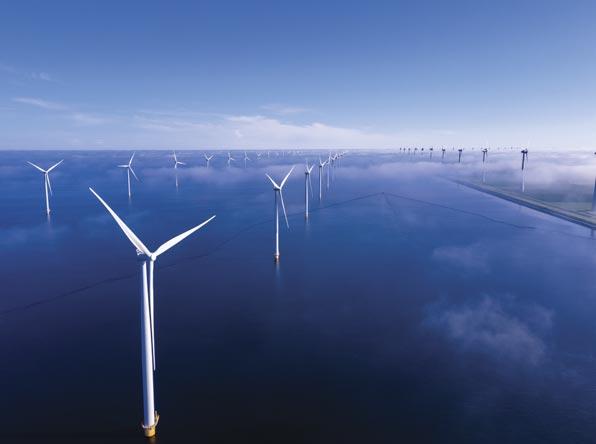
ready with the right combination of products and services to help customers accelerate the energy transition.
With the increasing integration of renewable energy sources like offshore wind or solar, the grid must adapt and be able to be consistent and reliable by having the right solutions in place. The decentralised nature of renewable energy has accelerated the need for new infrastructure and technologies to efficiently transmit and distribute power
Ireland’s Climate Action Plan has ambitions to generate significant renewable energy production from wind resources in the coming years. A major focus will be to significantly decarbonise the electricity system by 2030.
Offshore wind power at sea. 64 renewable energy magazine
all
and this is where Hitachi Energy comes in.
All over the world, the company has been collaborating with partners in the utility, industry, and infrastructure sectors to integrate the latest technological advancements, upgrade ageing grids, and helping to develop new ones to handle higher capacities and incorporate smart grid solutions to manage fluctuating energy flow.

Hitachi Energy’s Smart Digital Substation answers rising demand and complexity from distributed energy resources. The offering brings together the latest in digital substation technology with the unique predictive, prescriptive, and prognostic capabilities of Hitachi’s industry leading Lumada Asset Performance Management (APM) solution.
In March 2023, Hitachi Energy, alongside Petrofac, announced it had been selected by TenneT, the DutchGerman transmission system operator, to supply multiple record-breaking renewable integration systems, each with a capacity of 2GW and a voltage level of 525 kV, a world-first for offshore wind. Closer to Ireland, Hitachi Energy is supporting a new HVDC link to connect the Shetland Islands to the UK transmission system, helping to transmit wind power generated on the islands.
Local Sales Manager, and Market Manager for Hitachi Energy Ireland, Ruairi Williamson sees the opportunity to bring technology like the HVDC Light converter stations to Ireland: “At a global level, Hitachi Energy has been focused on creating a standardised approach that can be tailored for local markets. This has not happened overnight. It is the result of decades of working with our customers to support them in making the energy system to be more sustainable, flexible, and secure.
“As a leader that is advancing a sustainable energy future, we must push the boundaries of technology and innovation together with our customers and partners to create a suite of infrastructure solutions which help operators overcome their new challenges,” remarks Williamson.
solutions. Hitachi Energy has already been working to electrify one of Ireland’s leading bus fleets by providing the new infrastructure needed for indepot charging. The company’s GrideMotion Fleet smart charging solution means that buses connect to grid-toplug charging while not out on the roads. It also offers the smallest footprint for the connection as well as low noise emissions and high reliability – three key requirements for bus depots in a densely populated urban environment, where space is limited, and seamless charging is vital to ensure buses run on time.
Hitachi Energy positions itself as a “trusted lifecycle partner for customers looking for reliable, sustainable, and cost-effective service solutions”. Its teams work closely with partners to optimise their energy infrastructure today and for the future.
“Navigating today’s rapidly evolving energy landscape requires a suite of essential services. These critical services enable assets to perform as expected throughout their lifecycle, even under the most challenging conditions. Our solutions enable our customers to minimise downtime, reduce maintenance costs, and enhance safety, all while maximising productivity and profitability,” Williamson notes, commenting on his confidence that Hitachi Energy can respond where required.
Ireland’s first offshore wind auction, a drive to electrify Ireland’s roads, and a team to deliver on their solutions.
“Delivering the energy transition and enabling Ireland to successfully move towards a renewable-backed, net zero grid will only happen through collaboration”, explains Williamson, “working across sectors, across stakeholders, and the entire value chain”. As the pioneering technology leader, the company collaborates with customers and partners to enable a sustainable energy future, for today’s generations and those to come.
“We, along with our ecosystem of partners, are now in the middle of an almost perfect storm. The opportunities are there, we just need to make sure we grab them with both hands. We must come together, from energy suppliers and grid operators to OEMs and policymakers, to embrace the challenges that lie ahead and deliver the energy infrastructure for the future,” he concludes.
Advances in sustainable transportation and a greater degree of adoption in the electric vehicle market also means that local authorities are looking to electrify bus fleets and explore maritime and rail
Energising the future
Hitachi Energy is positioning itself to meet Ireland’s energy transition with
For further information visit W: www.hitachienergy.com 1. www.gov.ie/en/press-release/9336b-irelands-ambitious-climate-act-signed-into-law/
–
65 renewable energy magazine
Hitachi Energy employees working on transformer bushings.
Scaling up the green hydrogen sector
Born in the United Kingdom and raised in Canada, Phillips now works in Denmark for Dynelectro, a Danish green energy innovation firm which aims to accelerate Power-to-X solutions. The organisation aims to enable Denmark to meet a 70 per cent reduction in CO2 emissions by 2030. “I started out in coal, transitioned into oil, then to light oil, then to natural gas, and now I get to work in green hydrogen,” Phillips says, adding: “The consumer base of green hydrogen has truly changed in a short period of time.
“We need all solutions simultaneously.
We are entering a new era where we have to do everything in a condensed timeframe. That is the key point that needs to be made about scaling up green hydrogen. The timeline is unprecedented in what we are trying to achieve. We are talking huge numbers; an 80 per cent increase in projects each year, from one year to the next.”
Phillips believes that one of the main challenges of scaling up green hydrogen production is the high cost of the technology and infrastructure required to carry out conversions at a large scale.

Other challenges outlined by Phillips include the variability and intermittency of renewable energy sources, which she explains can make it “difficult to predict when and how much energy will be available for conversion”. “This variability also affects the efficiency of the conversion process, as the optimal conversion conditions may not always be present.”
In addition, the regulatory and policy environment can also pose challenges for scaling up within the Power-to-X industry. “For example, there may be limited incentives or support
66 renewable energy magazine
Samantha Phillips, Chief Commercial Officer, Dynelectro, discusses the challenges facing the green transition globally and the need for innovation in order to meet these demands.
programmes for companies to invest in these technologies, or regulations may restrict the use or distribution of certain types of fuels,” Phillips says.
Explaining how there may also be challenges related to the supply chain and logistics of the Power-to-X industry, such as sourcing and transporting raw materials, managing waste products, and distributing finished products to end-users, Phillips states that these challenges can all “affect the scalability of the industry, and will need to be addressed in order to realise its full potential”.
Central to all of these challenges is strong policy co-ordination at both national and international levels, as Phillips explains that “policy is the key feature which will help drive long-term investment into the green hydrogen sector”.
Addressing key challenges to Power-to-X
Phillips outlines her belief that the current regulatory and policy environment is “arguably the most important challenge to address,” as favourable policies and regulations can create a more supportive environment for Power-to-X technologies, while unfavourable policies can create barriers to entry and hinder investment.
“It is important to work with governments and regulatory bodies to develop policies and regulations that encourage the deployment of these technologies,” she says.

On the high cost of technology and infrastructure, Phillips states that while this is a significant challenge, it is “one that can be addressed through research and development efforts, as well as through partnerships and collaborations”. “By improving the efficiency and reducing the costs of conversion processes, companies can make these technologies more economically viable, which will help to drive adoption and investment.”
Another challenge is the variability and intermittency of renewable energy sources, which Phillips explains is “more difficult to address” as it is largely dependent on the natural variability of renewable energy sources. However, she says that there are “still steps that
can be taken to improve predictability and stability, such as energy storage and hybrid energy systems”. “While this challenge may be difficult to fully address, progress in this area will help to make Power-to-X technologies more reliable and efficient.”
Although Phillips says that supply chain and logistics challenges are important to address, she nevertheless believes that they are “somewhat secondary to the other challenges I have spoken of”. “However, by streamlining supply chain processes and improving the environmental sustainability of these technologies, companies can reduce costs and improve the overall viability of Power-to-X solutions.”
The need for innovation
Phillips tells of the need to innovate on the financial side and on how projects are made, as “this is where we are actually problem solving”. “We have a way which addresses the variability of wind and the renegades. The solutions exist, it is just that the heavily subsided amount of funding going into fossil fuels is the biggest obstacle which has to shift.
“There is $320 billion being subsidised to the fossil fuel industry globally. As for renewable, it is only half that, $162 billion. The money is still being funnelled into our fossil fuel development,” she says.
She outlines five broad areas where there are innovative theories which can enable the narrowing of this financial gap. They are:
• breakthroughs in conversion technologies;
• advances in energy storage;
• integration with renewable energy systems;
• digitalisation and automation; and
• circular economy solutions.
Concluding, Phillips emphasises the importance of “sensible time scales” as “bringing new technologies and solutions to market takes time”.
“Experience shows that the innovation process usually takes 20 to 70 years from prototype to commercialisation, with large-scale process technologies taking typically longer than small modular technologies.”
67 renewable energy magazine
The economic impact of climate change
The Earth’s climate is changing at an unprecedented rate due to human activities, primarily emissions of greenhouse gases like carbon dioxide and methane. This ongoing transformation in our climate is causing a wide range of economic impacts across the globe, from extreme weather events, to shifting agricultural patterns, and rising sea levels. The consequences of climate change are far-reaching and increasingly costly.
One of the most visible economic consequences of climate change is the increasing frequency and severity of natural disasters, hurricanes, wildfires, floods, and droughts are becoming commonplace and more destructive. These events result in substantial economic costs, from property, infrastructural repair, healthcare expenses, and to worst of all the loss of life.
The insurance industry is particularly vulnerable to these escalating costs. As
the number of climate-related disasters rises, so do insurance claims, which can lead to higher premiums for individuals and businesses. This, in turn, affects the cost of doing business and the affordability of insurance coverage.
Climate change can disrupt supply chains, causing interruptions in production and distribution. A very real example of this was during the protracted heatwave and drought in Europe during the summer of 2022. The Rhine, a major trade artery for German, Dutch, and Swiss economies had become virtually impassable. This had a huge impact as vessels carrying diesel and coal could not move up river (or to reduce their loads), and in most instances were unable to deliver to ports most in need. This also hampered the preparation for winter, as the summer months are usually used to build reserves. Half of Europe’s territory was suffering from droughts. The Danube, which flows through much of central and

southeastern Europe to the Black Sea, was like the Rhine – only flowing at a trickle. Italy’s rice fields were nearly dry as the PO was too low to provide the quantity of water needed, so much so, they started taking water from Lake Garda until that started running low. France found it difficult to cool its nuclear power stations as the Rhône and Garonne were too warm.
Very frightening situations that will be repeated year on year across the globe. But you know this already. I am communicating with the converted. There is light at the end of the tunnel, transitioning to a low-carbon economy has emerged as a pivotal driver of economic growth and sustainability in the 21st century. The growth of the renewable energy sector including solar, wind, geothermal, and hydroelectric power offers not only environmental benefits but also a plethora of economic opportunities.
Climate change is no longer just an environmental issue, it has profound economic implications, writes Colm McGrath, Managing Director of Surety Bonds.
68 renewable energy magazine
As the world grapples with the challenges of climate change and the imperative to reduce greenhouse gas emissions, the transition to renewable energy sources has become a global priority. In Ireland, we are only beginning to see the benefits of investments both from government and the private sector, as projects slowly but surely start to take off. It is essential that we do not waste any more time or hamper the growing momentum of this sector. Ireland is in a key position to become a net exporter if we can tap into lucrative export markets.
The renewable sector attracts substantial capital investment, both from public and private sources. Governments around the world offer incentives, grants, and subsidies to promote renewable energy development. Private investors, including venture capitalists and institutional funds recognise the long-term economic potential of renewable energy and are willing to allocate significant resources to it.
Building the infrastructure required for renewable projects means substantial investment which in turn stimulates economic growth. They create a demand for ancillary services such as transportation, logistics, maintenance, and the ever-growing need for additional grid infrastructure. Once in place, these forms of energy contribute to energy independence and security. By diversifying the energy mix away from fossil fuels, countries, and in particular island nations such as ourselves, reduce reliance on imported oil and gas. This has the benefit of reducing vulnerability to fluctuations in global energy markets helping to stabilise pricing, providing cost certainty.
There is a massive incentive right now to cut our ties with fossil fuels, 20, yes just 20, fossil fuel
companies contribute to 35 per cent of all energyrelated carbon dioxide and methane pollution worldwide*. The power lies with governments to change the status quo by investing in renewables, of which Ireland should even be a net exporter. The delay by successive governments in embracing renewables is just hard to fathom.
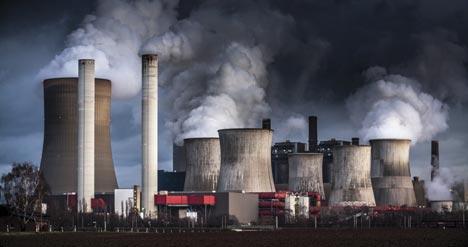
The renewable energy sector offers a wealth of economic opportunities that extend well beyond environmental benefits. From job creation and attracting investments to fostering technological innovation and enhancing export potential. Renewable energy is a driver of sustainable economic growth.
As the world seeks to address the challenges of climate change and reduce greenhouse gas emissions, embracing these economic opportunities becomes not only a responsible choice but a strategic one. Nations and businesses that invest in renewable energy today are positioning themselves for a more prosperous and sustainable future.
*The Guardian, 9 October 2019
Surety Bonds

Colm McGrath, Managing Director
W: www.suretybonds.ie
69 renewable energy magazine
Renewable gas: Ireland’s energy future
Jerry Murphy, Professor of Civil Engineering at University College
Cork and Director of MaREI, discusses the role of renewable gas in decarbonising Ireland’s energy system.
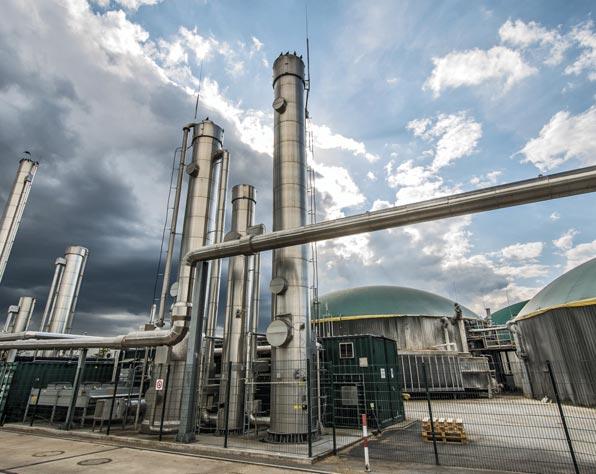
Murphy breaks down the science behind the energy transition, and how, in a sense, hydrogen is already being used for our energy systems. “When I think of the term ‘gas’, I always think of the hydrogen molecule itself. When Germany gets natural gas [methane] (CH4) from Russia, it is the hydrogen molecules within the methane that those in the energy sector are interested in. From natural gas, we can make ammonia (NH3), and methanol (CH3OH); green hydrogen molecules will allow us to produce green ammonia, green methanol, and also green steel.”
A civil engineer by trade, Murphy outlines his excitement for the scale of infrastructure being developed under the Dublin Declaration. “Offshore wind is very exciting. My graduates will be very heavily employed for the next 20 years putting these massive devices into the ocean. We are talking about high levels of development of nonsynchronous penetration which will mean us having very high levels of intermittent renewable electricity in the system.”
Murphy outlines his ambition for a potential long-term production of hydrogen in Ireland, arguing that the opportunity for the economy of Ireland must be maximised, rather than the future hydrogen surplus simply serving the energy needs of other countries.
70 renewable energy magazine
“It is expected that Ireland will produce and distribute hydrogen molecules to other European countries so that European countries can use that hydrogen to produce ammonia and methanol and steel and have big industry.
“I do not want to see our electricity or hydrogen just being exported at a cheap price to Europe. I want us to use this to energy to create jobs and prosperity at home. We must develop the offshore electricity infrastructure, and electrify energy in Ireland as much as possible; energy beyond our needs should be converted to a form or product that, if exported, optimises value for money in Ireland.”
Caution against ‘cheap hydrogen’
In a paper carried out by MaREI, Hydrogen from offshore wind: Investor perspective on the profitability of a hybrid system including for curtailment, Murphy’s team examine the expected surplus in hydrogen production Ireland will have by 2035 and grapple with the question as to whether Ireland should produce electricity or hydrogen. “We have this idea of a hybrid system where if the sale value of electricity from a wind farm drops to €0.04/kWh, the developer produces hydrogen instead of selling electricity until the value of electricity on the wholesale market increases; hydrogen from electricity at €0.04/kWh will cost around €3.70/kg, which is around €0.11/kWh of hydrogen.”
Murphy continues: “Electrolysers are around 70 per cent efficient, so when we hear people talk about cheap hydrogen of say €0.11/kg, which is equivalent to €0.03/kWh of hydrogen, we worry. Because the electrolyser is 70 per cent efficient, the maximum price that the electricity would get for this cheap hydrogen would be €0.02/kWh, if we assume electrolysers are free – which they are not. We need reality when we talk about the price of hydrogen: the guy
producing the electricity needs to make money, and the person producing the hydrogen needs to make money.”
How to use a hydrogen surplus
Whilst expressing his scepticism that hydrogen can be used to cover the whole energy system, Murphy believes that “hydrogen as a transport fuel works well”. “If we have hydrogen at €0.11/kWh, that is equivalent to €1.10 per litre of diesel. If you put into a fuel cell, which is more efficient, it has a lot of economic merit; hydrogen is ideally suited to long distance heavy transport and may be more beneficial than a battery powered truck for distances in excess of 450km.”
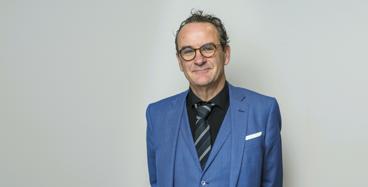
On developing the infrastructure to produce hydrogen in line with the Government’s Climate Action Plan commitments, Murphy outlines the scale of the challenge of constructing approximately 467 15MW wind turbines necessary to meet the 5GW electricity and 2GW hydrogen target for offshore wind by 2030. “The scale of this is enormous when we consider a 15MW turbine can be 320 metres high, similar in scale to the Eiffel Tower,” he says.
The UCC professor also outlines the choices between having electrolysers on land and bringing electricity ashore in a high-voltage direct current (HVDC) cable. “HVDC cables are expensive, have a limited GW capacity and there are bottlenecks in supply leading to delays in development time. The alternative is positioning electrolysers in the ocean, and use a relatively straightforward hydrogen pipe which can transport a lot more energy to shore.
“For hydrogen production in the ocean, you need a battery, a de-salination unit – because you need clean water to put into your electrolyser – and an electrolyser all floating on a platform with the turbine in the ocean. 4
71 renewable energy magazine
These are essentially massive factories floating on the ocean.”
Other areas for development
Murphy says that his work is all about ‘Power-to-X’, a formula on how best to use electricity and energy surpluses. “When ‘x’ is equal to ‘1’, it is hydrogen (H2); when ‘x’ equals ‘2’, it is methane (CH4); and when ‘x’ is equal to ‘3’, it is methanol (CH3OH),” he explains.
“We are going along pathways on which the renewable hydrogen molecule is extremely important. We can produce green methanol from renewable methane – worldwide production of methanol is 110 million tonnes and additional to this, it is going to be the shipping fuel of the future.”
Explaining that with hydrogen production Ireland could produce ammonia (NH3) fertiliser, Murphy states: “There are 150 million tonnes of ammonia produced globally. If we want to have decarbonised agriculture, we have a fantastic opportunity with our expected offshore wind production in 2035. Green ammonia can be made with hydrogen (from offshore wind) and nitrogen from the atmosphere. We have a route to produce green fertiliser in significant quantities.”
He also adds how this course of action could have the best means of promoting climate action policies to the agricultural sector.
On the current target for anaerobic digestion of 5.7 TWh, which Murphy says is “equivalent to 600MW anaerobic digesters putting methane into the gas grid”, the MaREI Director argues: “If you put biomethane into the gas grid you have CO2 left behind which could
be the biogenic source of carbon to allow conversion of hydrogen (H2) to methanol (CH3OH). We can have a renewable hydrocarbon industry through combining of anaerobic digestion with renewable hydrogen.”
Although he states that he has “struggled with the slow pace” of the anaerobic digestion industry in Ireland, Murphy believes that “anaerobic digestion is very important for organic farms”.
“If you want an organic farm but you have no fertiliser being brought in, your yields drop, but if you can digest all your dungs and slurries and make a biofertiliser, your yields go back up.”
German and Danish examples
With the scope for development of green gas in Ireland, Murphy points to successful examples with anaerobic digestion in Denmark and Power-to-X in Germany.
In the German town of Wertle, there is a 2MW digestor treating the local area’s food waste. Murphy tells of how biomethane goes directly into the region’s gas grid and CO2 is left behind as a by-product. The facility also has a 6MW electrolyser which produces hydrogen. Murphy tells that “with this facility, you would have offshore wind, from off the north coast of Germany and because the electrical infrastructure required to bring the electricity to the industrial heart land in the south is limited, they have an electrolyser”.
Murphy further explains the science behind the Power-to-X process which operates through the Sabatier Equation, where four moles of hydrogen (H2) and one mole of carbon dioxide (CO2)
makes one mole of methane. This, he says, is “Power-to-X when ‘x’ is equal to 2”. “You are converting the hydrogen to methane and the reason for that is that there is a gas grid there already.”
The catalytic Sabatier process in Wertle operates at 420oC. Murphy explains how an alternative biological process can operate at 55oC and be more suitable for development at biogas facilities. “Microbes eat hydrogen and carbon dioxide and make methane. We found a biological way to convert hydrogen to methane. We just fed our biogas reactors with hydrogen and carbon dioxide. There are always challenges, hydrogen is very slow to go into solution, but we modelled and then built the system, and we are operating at over 95 per cent efficiency.”
Murphy further elaborates on more expansive facilities: “The oxygen (O2) from an electrolyser could go to a cement factory which gives you lean cement. You can then capture the carbon dioxide (CO2) from the cement factory, to react with the hydrogen from an electrolyser to make methanol.
Doing this, you have now reduced the CO2 output from cement, you are using electricity that may otherwise be dispatched down, you are making methanol which can be a precursor to sustainable aviation fuel.”
In Denmark, the Danish Government decided in 2010 that there would be no more spreading slurry on the land by 2030. As of 2020, they are halfway there. This, Murphy explains “is to overcome eutrophication and pollution of wells”.
Currently, 35 per cent of Denmark’s energy supply comes from green gas in the form of biomethane. Murphy explains: “The Danes are proposing to use electrolysers and biological methanation systems which will upgrade their biogas to pure methane and would also double their overall gas production as the CO2 in the biogas is converted to biomethane. The Danes are saying that they will have 100 per cent green gas in their gas grid by 2035.”
Concluding, Murphy emphasises that we must use as many technologies as possible so that: “By 2035, we will have met our renewable energy production targets and will be able to power ourselves.”
72 renewable energy magazine
“Electrolysers are around 70 per cent efficient, so when we hear of people talk about cheap hydrogen of say €1/kg, which is equivalent to €0.03/kWh of hydrogen, we worry.”
Steven Agnew, Director says: “Figures from the Department for the Economy (DfE) for the 12 months to end of June 2023, show that 45.5 per cent of our electricity used came from renewable sources.
“These figures show that we are stagnating, and we risk going from world leaders to laggers and urgently need to act if we are to change this.”
At the beginning of September 2023, RenewableNI launched Accelerating Renewables in Northern Ireland, conducted by KPMG. The report focuses on grid, planning, and market issues, which were identified as key failures by the renewable industry.

Report author, Russell Smyth, KPMG, says: “More than $350 billion of capital has poured into renewable infrastructure investment around the world in the first half of 2023, yet
Northern Ireland has attracted virtually nothing in the past four years, with 82 per cent of our survey respondents concluding Northern Ireland is currently considered an unattractive investment location for renewable developers.”
RenewableNI will be discussing how government and industry can work together to achieve the report recommendations at the upcoming Smart Energy Conference on Thursday 19 October in ICC Belfast.
Smart energy decisions need urgent action
The premier renewable energy event in Northern Ireland, the conference will also include a panel discussion on the climate and biodiversity crises.
Speakers include DfE, DAERA, RSPB, The Crown Estate and Alliance Party leader Naomi Long MLA, in addition to event partner Carson McDowell.
The afternoon will focus on how to create Northern Ireland’s offshore wind industry, worth a potential GVA of £2.4 billion for the economy.
In addition to meeting enough clean electricity annually to power 1.6 million homes, creating this emerging sector will create 1,500 new jobs, with £1.9 billion will be spent on Northern Ireland suppliers.
Agnew continues: “Northern Ireland has been without an Assembly for 18 months, but there has been an energy policy vacuum for 10 years. This has left Northern Ireland as the only part of these islands without a renewables support scheme since the closure of NIRO in 2017. With only 70MW of new electricity in the past four years, it is
clear to see that a lack of support is having a major impact on development here.
“To put this into context, last year the Republic of Ireland developed 20 times the amount of new renewable electricity generation as Northern Ireland. They benefit from a support scheme, shorter planning timelines, and a government committed to climate action.
“We hope as many people can join us at Smart Energy to ensure we make smart decisions and achieve vital clean energy for Northern Ireland.”
You can read Accelerating Renewables, along with RenewableNI’s other reports and consultations at www.renewableNI.com/policy
Learn more about the Smart Energy Conference at www.RenewableNI.com/SmartEnergy
RenewableNI, the voice of Northern Ireland’s renewable electricity industry, has said urgent action is needed if the Climate Change Act target of 80 per cent is to be reached by 2030.
73 renewable energy magazine
(L:R): Dagny Ahrend, RenewableNI; Russell Smyth, KPMG; and Steven Agnew, RenewableNI at the Accelerating Renewables report launch.
Pinergy calls on businesses to avail of new €30 million Solar Energy Fund

New Pinergy fund offers solar installations to businesses removing upfront capital costs.

Pinergy, the clean energy supply and solutions company is now operating a €30 million fund to accelerate the delivery of solar energy to businesses across the country. Funded solar is a new service for commercial energy users that will enable them to access lowercost renewable energy as they get ready for the energy transition.
As part of this new service, Pinergy will design, install, and maintain the solar PV installation in its clients’ commercial properties with no capital outlay for the business. The client will agree a Power Purchase Agreement (PPA) with Pinergy to buy electricity generated by the solar panels which will be lower cost than prevailing prices from the grid. When the €30 million fund is fully taken up the renewable energy generated would meet the equivalent needs of 7,000 typical homes, reducing demand on the grid.
The new service enables commercial clients to experience the benefits of a solar PV installation without the upfront
capital cost, whilst ensuring the business can immediately benefit from the generation and use of renewable energy. As a result, clients will see their operating expenses and cashflow improve as they will require less electricity from the grid, thus resulting in reduced energy prices and increased energy security for the next 25 years.
This new funded solar service will enable organisations of all sizes with good roof space to utilise renewable energy to reduce their carbon footprint and move towards a more sustainable business model. The initiative is ideally suited to commercial energy users across a range of sectors including public sector, retail, hospitality, leisure, manufacturing, logistics, pharma, and industrial sectors, who have seen their grid energy costs increase in recent years.
Commenting on the new €30 million solar energy fund for businesses, Pinergy CEO, Enda Gunnell, says: “Many businesses have been faced with rising
operating costs due to volatile energy markets over the last few years. We recognised that there is a need to provide a simple solar solution that maintains security of supply while reducing costs to businesses across the country, while also enabling them to play their part in a sustainable energy future.
“Pinergy will fund the initial installation and maintain the solar PV project. At the same time, our clients benefit from certainty on supply and reduced energy prices for the next 25 years.”
To learn more about the service, please go to:
www.pinergy.ie/businesselectricity/funded-solar/ or contact Esme Murphy at: emurphy@solarelectric.ie
74 renewable energy magazine

Solar at scale
Emerging as the fastest growing renewable power source in Ireland, the inclusion in Climate Action Plan 2023 (CAP23) of a target of 5GW of solar PV capacity (including at least 1GW of non-new grid solar) by 2025 and an 8GW target for 2030 represents a significant shift in the role of solar in reaching the overarching 80 per cent of electricity demand from renewable energy by 2030.
2022 was a record year for renewable generation capacity being connected to the grid, with solar PV generating circa 700MW compared to a high of circa 4,562MW from offshore wind and a low of circa 9MW from biomass.
In June 2023, the Irish Solar Energy Association published its Scale of Solar report, aimed at highlighting the significant growth of solar PV in 2022 to 2023.
Most notably, RESS 1, the Government’s first Renewable Electricity Support Scheme, saw the first grid-scale project connected in 2022. While micro-generation solar PV has a huge role in Ireland’s energy transition by empowering consumers to manage their own energy consumption and costs, turning the dial on solar PVs contribution to the renewable electricity mix will require projects of scale.

The significant upgrading of the Government’s solar PV targets from 2.5GW to 8GW by 2030 exemplifies solar energy’s shift from a fringe technology to a crucial element of Ireland’s renewable transition.
76 renewable energy magazine
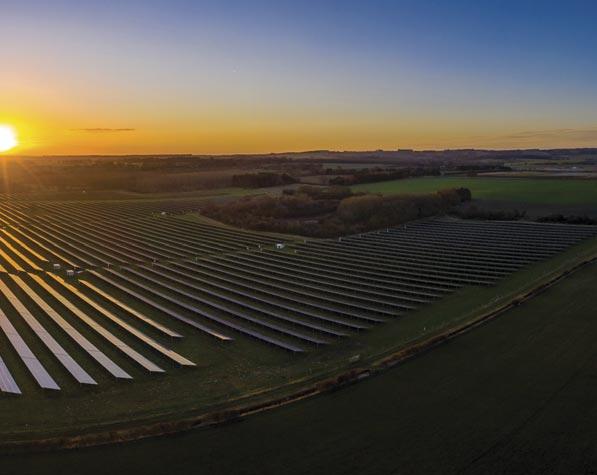

77 renewable energy magazine Utility-scale (>5MW) 349 MW Utility-scale (1MW-5MW) 22 MW 200kVA-1MW 0.3 MW Small Scale Generation 0.54 MW 4 Minigen 5 MW 141 Microgen 208 MW Auto production ground mount 95 MW 59,500 7 5 1 230 CAPACITYNUMBERCAPACITYNUMBER Overview Solar energy can save 202,127 CARBON TONNES each year Solar energy can generate 599,131 MWh of electricity each year Equivalent to annual electricity demand of 144,650 homes Equivalent to 1.4 billion kilometres of driving Total 680 MW 59,888 * 4 Source: ISEA - Scale of Solar RESS 3 final auction quantity results for solar: successful 497.60MW unsuccessful 148.40MW
Currently, Ireland has 349MW of utility-scale solar (>5MW) connected to the grid from large solar farm projects. However, smaller solar farms and large commercial rooftop installations, which are still classed as utility-scale (1MW5MW), generate just 22MW currently, highlighting a need for acceleration of projects in this band.


Most projects under 1MW capacity are commercial installations used by organisations to offset their carbon emissions, and the ISEA points to 0.84MW connected to the grid at this scale.
Alongside the largest utility-scale generation, the amount of solar PV now entering Ireland’s renewable energy mix is being driven by both mini- and micro-generation scale. Minigeneration, defined as those projects which typically have a capacity between 17kVA and 50kVA and usually installed by businesses, farms, and other commercial operations for consumption of their self-generated electricity, has 5MW connected to the grid.
Recent Government initiatives, not least the removal of VAT on the supply and installation of solar PV panels, as well as the removal of planning permission, tied with grant availability, has led to over 60,000 homes with solar rooftop installation – and an estimated 500 domestic connections taking place per day.
Away from the grid, ground-mount solar, those projects



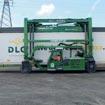


which do not export to the grid but instead generate electricity for self-consumption by households or businesses, are responsible for 95MW of generation.


ESB Networks estimates that almost 1GW of solar will be connected to the electricity grid by 2023, making the solar industry the fastest-growing renewable power source in Ireland.

Challenges





Some of the existing challenges to solar PV include delays in the planning process, the necessary upgrading of the electricity network, and the need for investment in storage technology.
Analysis from Cornwall Insight’s all-island forward curve suggests that Ireland must achieve a total of 1.7GW of solar capacity at every renewable energy auction until 2030, if it is to avoid missing its climate targets. Reaching the 1.7GW target would mean an uplift of 0.5GW at every RESS auction. Pinpointing limited capacity for connecting renewable generation and concerns over electricity system security as some of the hurdles facing the expansion of the solar industry in Ireland, the analysis also says that crucial to the growth of solar PV generation will be ensuring investment in storage technology keeps pace with levels of renewable generation.
78 renewable energy magazine Bulk Food & Chemical Transport Specialists QFICD Inland Depots (Dublin & Cork) QPL Transit & Cross Dock Warehousein Rotterdam Port EU, Scandinavian, Eastern European & Iberian LCL services Global LCL Services Intermodal Specialists with in-house trucking Heavy lift & OOG Specialists Professional Project Teams Energy StorageProjectManagement Renewable &WindEnergySpecialists Power Generation Freight Solutions Belfast Cork Rosslare Santander Bilbao Rotterdam Antwerp Zeebrugge Le Havre Dunkirk Dublin Norway Sweden Copenhage Project Freight Port Operations OOG SpecializedTransport Project Management Customs and Compliance – incl. QHSSE Our 5Areas ofActivity T: +353 1 8366233 E: sryan@qualityfreight.com E: sryan@renewable-logistics.com W: www.qualityfreight.com W: www.renewable-logistics.com
Progress in offshore wind infrastructure development in North
regulatory and planning challenges in conjunction with other government departments.”

The announcement, made on 16 January 2023, seeks to build on the Northern Ireland Energy Strategy, which establishes a commitment to diversify the renewable generation mix with a commitment to offshore wind forming a part of the future renewable electricity mix.
The Energy Strategy Action Plan 2022, published on 16 January 2022, included Action 14 to “develop an action plan to deliver 1GW of offshore wind from 2030”. However, the 2023 action plan only includes one mention of offshore, simply stating that “work also continues” on delivering offshore wind in Northern Ireland.
Previously, the direction of offshore renewable energy policy was driven by the Offshore Renewable Energy Strategic Plan 2012-2020. It identified the potential of up to 900MW of offshore wind and 300MW of tidal energy that could be developed in Northern Ireland’s waters.
In 2011, the UK and Irish governments signed a memorandum of
understanding which clarified the marine jurisdiction of both states and the waters around Northern Ireland, which led to the announcement of three leases in October 2012.
However, at the end of 2014, it was announced that a £1 billion plan to build up to 120 wind turbines off the coast of Northern Ireland had been abandoned, with the developer blaming delays to new market and incentive arrangements.
In 2019, a Department for the Economy report stated that Northern Ireland’s coastline was not suitable for offshore wind infrastructure development due to likely objections at how they would appear, meaning that Northern Ireland was excluded from the 2019 leasing round by The Crown Estate.

The Department for the Economy stated: “The purpose of this statement of intent is to outline the ways in which the two organisations will work together to enable leasing for offshore wind in the Northern Ireland marine area, in parallel with work to address relevant
Peter Russell, Director of Electricity and Security of Supply at DfE said: “Our ambition of delivering 1GW of offshore wind energy is Northern Ireland’s most ambitious energy infrastructure plan, with the potential to supply enough energy to power one million homes. The Statement of Intent is a major milestone for the Department for the Economy and The Crown Estate towards unlocking the potential of the Northern Ireland seabed and achieving the Energy Strategy vision of selfsufficiency in affordable renewable energy.”
Gus Jaspert, Managing Director of Marine at The Crown Estate said: “We are highly committed to working in partnership to sustainably manage the seabed and the natural environment for its many users, and to unlocking its potential to support the transition to a net zero energy future. This statement of intent marks an important step forwards, laying the groundwork for building the right conditions for offshore wind leasing and realising the potential benefits for the people of Northern Ireland – local economic investment, low-carbon electricity, and a more sustainable and secure long-term energy supply.”
The Department for the Economy (DfE) and The Crown Estate, in January 2023, announced a statement of intent to establish offshore wind leasing in Northern Ireland.
renewable energy magazine 79
The north Antrim coast has one of the highest scopes for development of offshore wind technology in the North.
Environmental consenting
Progress with the Bill
The Bill represents a long overdue consolidation and streamlining of our national planning framework. Some of the positive measures in the Bill include the introduction of mandatory timelines for processing all consent applications and changes to the right to bring, and the conduct of, judicial reviews, including the introduction of statutory time periods for each stage of the judicial review process.
The Bill completed pre-legislative scrutiny in April 2023 with the publication of the report of the Joint Committee on Housing, Local Government and Heritage. With respect to the proposed changes to the judicial review process, in particular the measures included in the Bill to restrict the right of certain organisations to bring a judicial review, the report identified some concerns and made a recommendation that the proposed changes be reviewed for consistency with the Aarhus Convention.
The Minister for Housing, Local Government and Heritage is in the process of revising the Bill considering, the Joint Committee’s report. A revised draft Bill is expected to be published by the end of September 2023 with the Minister targeting to have the Bill enacted before the end of the year.

Impact of the Regulation

In last year’s Renewable Energy Magazine, we discussed two positive legislative developments aimed at accelerating the consenting process and the deployment of renewable energy, the Draft Planning and Development Bill, 2022 (the Bill) and Council Regulation (EU) 2022/2577 laying down a framework to accelerate the deployment of renewable energy (the Regulation).
In this article, we provide an update on the progress of these legislative measures, discuss their impact, and further examine legislative developments aimed at streamlining the consenting of renewable projects; in particular, the proposal for a directive amending Directive (EU) 2018/2001 (the Renewable Energy Directive or REDII) endorsed by the Permanent Representative Committee of the EU on the 16 June 2023 (the Proposed Directive).
The Regulation was introduced on 22 December 2022 as a temporary emergency measure in response to the threat to security of supply posed by the war in Ukraine and has effect for an 18month period. Notwithstanding it is a regulation, and therefore directly effective, there are elements of the regulation more akin to a directive with member states afforded significant discretion as to its implementation.
For example, Article 6 permits, but does not oblige, member states to exempt
80 renewable energy magazine
Stuart Conaty, Partner in Beauchamps’ Energy and Natural Resources team discusses progress on policy measures aimed at accelerating renewable energy deployment.
renewable energy projects and associated infrastructure from the requirement to undertake an environmental impact assessment where the project is located in “a dedicated renewable energy area… and… the area… has been subject to a strategic environmental assessment”. Unfortunately, the Irish Government has made no moves to identify such dedicated renewable energy areas and we are not aware of any such moves across the Union.
Applicants for consent for renewable energy projects are invoking the regulation. In particular, applicants are highlighting the declaration in Article 3 that renewable energy projects are in the overriding public interest and that the consenting authority must ensure that such projects are given priority when balancing competing legal interests. We are not aware of any relevant decisions as of the date of this article where such a balancing of legal interests was a live issue but no doubt the issue will emerge as more applications move through the system.
The proposed directive
The proposed directive adopts many of the measures included in the Regulation aimed at accelerating the permit granting process including the designation of “renewables acceleration areas” and seeks to build on some of the existing requirements under the Renewable Energy Directive such as mandatory time periods for the consenting process.
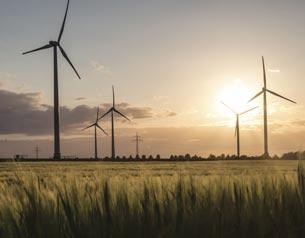
Unlike the Regulation, the proposed directive requires member states to identify areas (land and sea) for the development of renewable energy sufficient to meet their 2030 renewable energy targets and to have completed this process within 18 months. Within 27 months, the relevant competent authorities are required to designate subsets of these areas for the development of renewable energy with these areas, to be known as “renewables acceleration areas”, to be subject to a strategic environmental assessment. Renewable energy projects located in renewables acceleration areas will be exempt from the requirement to undergo an environmental impact assessment or an appropriate assessment.
The consenting authority will be required to carry out a screening exercise to determine if the project “is highly likely to give rise to significant unforeseen adverse effects… that were not identified during the [strategic] environmental assessment of the plan or plans designating renewables acceleration areas”. Where it is determined that the project is not highly likely to give rise to significant unforeseen adverse effects, the project shall be deemed to be authorised.
Conclusion
The Bill contains welcome amendments to the existing legislative framework, in particular, to the judicial review process. However, given the criticism of these measures during pre-legislative scrutiny, we await the publication of the revised Bill in the hope that many of these beneficial measures are retained.
The full benefit of the regulation has not materialised due to an unwillingness on the part of government to designate renewable energy areas. The proposed directive removes the discretion afforded to member states to opt out and instead requires them to designate sufficient renewables acceleration areas within 18 months – this must be welcomed and will have a real impact on the timeline for the consenting of renewable energy projects once adopted.
Stuart Conaty,
Energy and Natural Resources Group E: s.conaty@beauchamps.ie
Emma O’Connell, Trainee
Energy and Natural Resources Group E: e.oconnell@beauchamps.ie
Partner
Solicitor
81 renewable energy magazine
“The full benefit of the Regulation has not materialised due to an unwillingness on the part of government to designate renewable energy areas.”
Europe’s biomethane journey
Taking stock in biomethane production in the European Union’s 27 member states, Kulišić explains that the Commission is using a “linear growth in production [of biomethane] based on the projections communicated in the national energy climate plans”.

“At the moment, 17 member states have reported their national energy climate plans (2020-2021), reflecting what has been implemented and challenges faced. In parallel, member states are submitting their bi-annual
national energy and climate plans 20232030, looking forward towards the targets, given the past experiences. Collecting biomethane related ambitions from each member state would help us assess how far along we are on the 35bcm target. It is not going to be linear; it will be a bumpy road, especially as the first actual biomethane molecule will be available in 2026 at the earliest, if the investment is made today.”
Currently, biomethane is only produced

Biljana Kulišic, Policy Officer, Bioenergy, European Commission, outlines the state of play and scope for development of the European biomethane sector.
82 renewable energy magazine
in 15 out of the 27 EU member states. Kulišić describes Ireland’s biomethane sector as “small, but nonetheless existing”, as it contains small numbers of biomethane plants.
“Ireland is taking inspiration from Denmark which is the right thing to do,” she says. “Denmark took only eight years to come to 38 per cent of replacement of natural gas supplied by biomethane and has a plan to have fully phased out natural gas by 2027 from their gas grid system, so we see that this can be done. I am sure that Ireland, from its own experience of being a European champion in bioeconomy, has learned that it can be a champion and a forerunner in biomethane development rather than being a laggard.”
A united approach to a changing policy context
Praising Minister Eamon Ryan TD’s “brilliant leadership” in ensuring that Ireland plays a full role in the EU’s Biomethane Industrial Partnership, a public-private partnership between industry and the European Commission established to accelerate sustainable biomethane production, Kulišić, as a co-chair of Task Force 1 that is consisted of member state representatives, believes that a cohesive approach can be taken from all EU member states working together to enhance a network of civil servants “that would actually accelerate biomethane production in Europe”.
“Everyone knows that there is a fastchanging policy context. Energy security is a must for a country to have sovereignty. We want to have it to be not just independent and secure, but also green. This will help us to our net zero emissions targets,” she says.
“History has taught us that if we frame bioenergy related policies around only the energy content produced from that bioenergy, these policies tend to backfire in terms of neglecting what is done to the carbon sinks, embracing the renewable energy production byproducts in rural development, or how to mix energy with other policies and targets.”
Kulišić states that the visions among EU member states for their energy transitions are mostly “very much about
electrification” but explains that some of the sectors that are difficult to abate through electricity will still remain and, therefore, there are going to be some renewable gases needed and limited use of fossil gas will remain necessary in the medium term. “Fossil gas in the perspective of the climate target may give us the least greenhouse-gas emitting fossil among the fossils, but it is not an excuse to not have renewable gases of our own origin.”
Trade of biomethane
With the European Union targeting 35 bcm of biomethane and biogas production by 2030, Kulišić outlines her belief that Ireland can have an important trading role as the quality of biomethane produced in Ireland is likely to be the most valuable, due to the fact that it will be primarily produced from manure rather than other feedstock.
“Industry estimates that there is a €2 billion total gross market margin by 2030. This will be linked with a carbon offset price meaning that a batch of biomethane produced from manure will have a better price than the batch of biomethane produced from food and feed feedstock,” she says.
Looking at how best to synchronise trading across the EU, Kulišić states: “Union database for biofuels has been established for biofuels, not just for biomethane but also for liquid biofuels in transport. This creates a positive synergy between guarantees of origin [GOs] and voluntary certification schemes [VCSs].
“GOs are an important mechanism carrying the information how much biomethane [in energy units] has been injected to the grid or used off-grid. VSCs are focused on biomethane sustainability criteria and minimum greenhouse gas emission thresholds [under Article 29, RED II], to be eligible to for public financing support and be attributed to the national RES targets. “Combining GOs and VCSs, with the global mass-balance system would allow trading of sustainable biomethane. In reality, that means gas will flow through its own wave through the pipelines of different mixtures, but the trade will be happening with the global balance system.”
Concluding, Kulišić outlines that pumppriming investment is vital to ensure the long-term viability of the biomethane industry, with the sector still in an early stage of development.
“The inspirational country in terms of access to finance, although large, is Spain, which has been remarkable in combining the different aspects of the supply chain of biomethane. It is important to finance not just on the kWh but also by the digestate and biogenic CO2 to improve the business model and reduce the biomethane price.”
83 renewable energy magazine
“Ireland, from its own experience of being a European champion in bioeconomy, has learned that it can be a champion and a forerunner in biomethane development rather than being a laggard.”
It is solar’s time to shine
SSE’s Net Zero Acceleration Programme (NZAP). This programme will see SSE Renewables increase its installed renewable energy capacity to 9GW by 2027, and over 16GW by 2032.
In line with its NZAP objectives, SSE Renewables is expanding its pipeline of solar and battery energy storage system (BESS) projects in Ireland, as well as its team of expert engineers and technicians to deliver them.
However, according to SSE Renewables’ Head of Development for Solar and Battery, Daniel Barnes, much needs to be done to speed up the development of these vital emerging and innovative projects.


“There are a lot of challenges in the development of solar and battery in Ireland that need to be addressed,” Barnes says.
“We have seen significant delays in our planning system which need to be fixed. These delays are consequently affecting grid applications, resulting in fewer eligible projects for Ireland’s Renewable Electricity Support Scheme (RESS) auction.
For almost three decades, SSE Renewables has been harnessing the wind energy resource around our island to generate green power for Irish homes and businesses. From its very foundation in the early days of Eirtricity and then Airtricity, through its acquisition by SSE plc, and then the creation of SSE Renewables as a standalone renewable energy developer and operator, the company has always pioneered the possibilities that windpowered generation could afford for Ireland.
Through grit and graft, passion and persistence, its wind analysts, engineers, and development personnel led the way in advancing the case for wind energy in Ireland. Today, wind energy is very much the mainstream,
and SSE’s own portfolio of onshore wind farms is one of the most prized on the island.
But nearly 30 years on, new challenges face us, requiring new thinking and new approaches. No longer are we solely focused on achieving net zero carbon emissions by 2050 to combat climate change; today, it is as crucial that Ireland achieves its energy independence to reduce its exposure to costly and volatile gas markets. To achieve this, the country will need to deliver unprecedented levels of clean, affordable, and sustainable energy, across all commercial-scale renewable energy technologies.
That is why SSE Renewables is taking action to deliver an expanded pipeline of projects across the island as part of
“Projects that were successful in the RESS 2 auction are now walking a tightrope trying to navigate grid connection delays, cost increases, higher interest rates, and a tight supply chain. The Department may need to consider some options to ensure that the RESS 3 auction takes account of the challenging development environment.
“In order to help expedite the deployment of solar and energy storage we anticipate the need for more frequent grid connection processing rounds and removal of the existing grid connection offer cap on storage projects.”
In November 2022, the Department of the Environment, Climate and Communications published its consultation on electricity storage policy framework for Ireland. SSE is now
The speedy delivery of solar and battery technology across the island can support Ireland’s Climate Action Plan goals, says SSE Renewables.
Daniel Barnes
84 renewable energy magazine
Leo Green
keenly awaiting the publication of the framework alongside storage objectives for incorporation into the Climate Action Plan.
For its part, SSE Renewables supports a review of firm access rights for energy storage projects, as Barnes points out: “The potential for energy storage is to optimise that of existing generation. This can have a positive and significant impact on managing constraints, as well as dampening the impact of generation intermittency on the system. It is critical that a review of this impact, and scheduling and dispatch into the market, takes place as soon as possible to ensure a level-playing field on the matter of firm access between battery storage and other technologies.
“Battery storage can support near-term and long-term security of supply and give huge support to the grid by participating in the day-ahead market, reducing day-ahead emissions, and helping with the integration of renewables by reducing oversupply.”
Solar and storage colocation
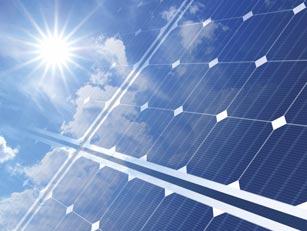
Solar and energy storage co-location has multiple benefits when it comes to achieving net zero ambitions, not least with regards to reducing costs by sharing existing infrastructure and making the most effective use of grid capacity.
SSE Renewables sees co-location as a key part of its strategy. In September 2023, the company submitted a planning application for a solar farm located adjacent to its current 27MW wind farm at Richfield in the ‘sunny south-east’.
The proposal would see a 21MW solar farm constructed on a 44-hectare site in south Wexford, and close to the existing 18 turbine wind farm which has been operational since 2006.
It is one of the first co-location projects currently in planning for SSE Renewables but one which the company hopes will make the case for future colocation sites.
Leo Green, Head of Onshore Programmes at SSE Renewables, says co-location of new solar beside existing wind generation would make the site much more productive and resilient, capable of contributing power to Ireland’s grid at times when the sun shines but when the wind does not blow.
“Richfield Wind Farm currently generates enough energy to power up to 18,000 homes per annum and through co-location we can increase that output by around 25 per cent, which could power an additional 4,500 households. This could further support efforts to meet Ireland’s target of generating 80 per cent of its electricity from renewable sources by 2030,” Green says.
“However, there are some ongoing regulatory barriers facing hybrid projects in Ireland, such as the installed capacity cap and the sharing of export capacity. The Regulator plans to consult on both barriers shortly, and addressing these challenges will be imperative to achieve the targets of the Climate Action Plan.”
With this in mind, the development of the Richfield co-location project will be subject to changes and reforms in Ireland’s current grid connection consenting regime to allow for hybrid technology grid connections to facilitate co-location of wind and solar generation
sources. Delivery of the project is also subject to securing an economic route to market ahead of a final investment decision expected around early 2026.
Green continues: “If co-location projects are to help deliver Ireland’s climate goals, we will require more certainty as to how the regulatory framework will be evolved to support developments like Richfield.
“SSE Renewables is ready to work closely with key government and regulatory stakeholders to remove the barriers to co-location projects and support the delivery of important solar and battery technology projects colocated at existing sites.”
For more, visit sserenewables.com/solarandbattery
“There are a lot of challenges in the development of solar and battery in Ireland that need to be addressed.”
85 renewable energy magazine
Head of Development for Solar and Battery, Daniel Barnes
Minister for the Environment, Climate and Communications, Eamon Ryan TD welcomed a “breakthrough moment” for Ireland’s offshore wind future, following EirGrid’s announcement of the provisional results of the ORESS 1.
A total of six offshore wind projects were issued maritime area consents (MACs) in December 2022 and successfully underwent the ORESS 1 qualification process, however, following the Final Competition Ratio (FCR), the mechanism designed to drive competition price between bidders, only four projects were successful under ORESS 1.
The provisional results mean that of the 4.1GW of bids submitted, a combined capacity of over 3GW were accepted. Notably, these projects are currently in the early stages of making planning applications to An Bord Pleanála, which has been resourced with a dedicated marine directorate to process these applications.
The Climate Action Plan to 2020 has set an ambition of at 7GW of offshore wind capacity by 2030, with 2GW of this production being earmarked for the production of renewable hydrogen.
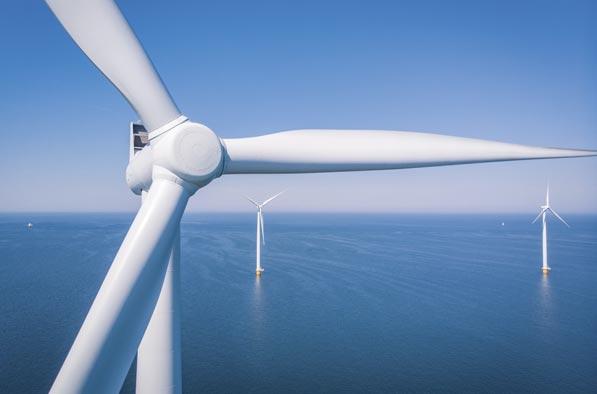
The schemes were awarded at a weighted average strike price of €86.05 per MWh, below the maximum offer price of €150, a figure which surpassed expectations.
The Renewable Electricity Support Scheme (RESS)
under which the first offshore auction was held, represents a competitive process, through which successful projects receive two-way contracts for difference for a guaranteed price for renewable energy generated over a period of up to 20 years. The scheme differs from the previously deployed REFIT tariff, in that it operates as an automatic protection against windfall gains, because projects are required to return the revenue difference when wholesale prices are in excess of the strike price to electricity consumers.
“The provisional results of the ORESS 1 auction are not just a hugely positive story for Irish energy consumers, but for Ireland as a whole. The results are further evidence of what many of us have known for a long time; that we, as a nation, can develop and produce enormous quantities of clean energy – securely and at low cost,” stated Ryan.
Three of the projects approved are on Ireland’s east coast, including the largest of the projects, the Codling Wind Park (1,300MW). Also on the east coast is the North Irish Sea Array (500MW) and the Dublin Array (824MW). The smallest wind farm awarded under ORESS 1 is on the west coast, the Sceirde Rocks Offshore Wind Farm.
Under the terms of the community benefit fund of ORESS 1, over €24 million per yet is set to be paid to local marine and coastal communities hosting offshore renewable energy projects.
Ireland’s historic first offshore wind auction has seen over 3GW of generation approved, with a strike price much lower than expected.
86 renewable energy magazine
Offshore wind auction approves 3GW
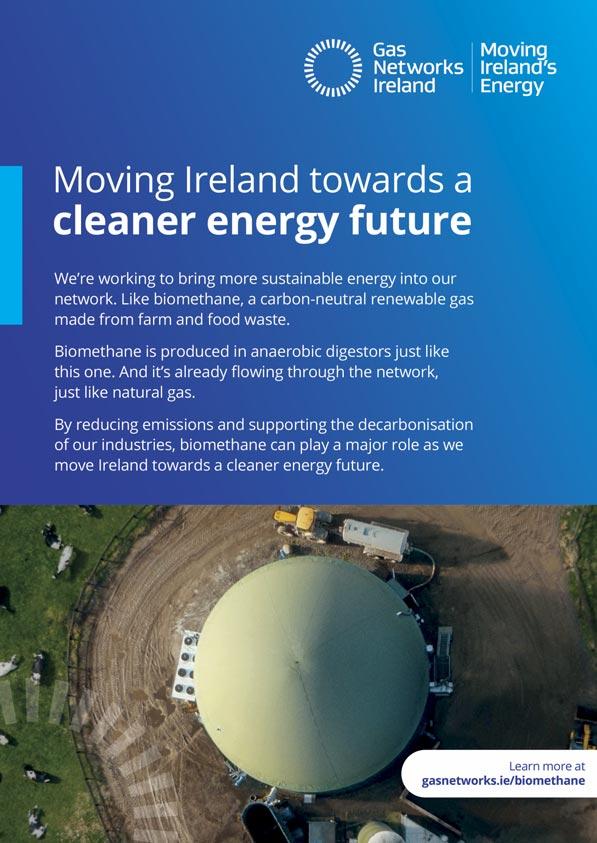
Scotland’s hydrogen journey
Katy McNeil, Head of the Scottish Government’s Ireland Office, outlines the details of Scotland’s growing hydrogen value chain, the scope for collaboration between Ireland and Scotland, and the lessons learned during Scotland’s hydrogen journey.
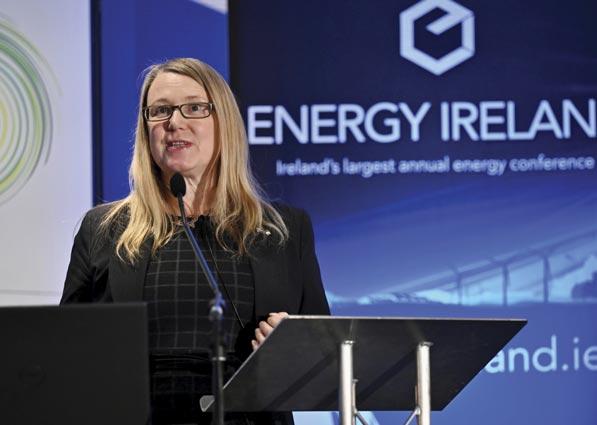
Contextualising the Scottish decarbonisation journey, McNeil recalls the first decarbonisation strategy under then-First Minister, Jack McConnell, which initially targeted 40 per cent of Scotland’s electricity to be powered by renewable energy sources by 2020, a target which she remembers was initially regarded as “too ambitious”.
In 2011, a new administration in Scotland increased the renewable electricity target to 100 per cent by 2020. McNeil recounts: “Similarly, at that time, critics suggested that our ambition was 10 years too premature.”
Although the Scottish Government did ultimately miss its target, its success in delivering 97 per cent renewable-powered electricity by 2020 was nevertheless widely acclaimed.
Scottish Hydrogen Action Plan
In December 2022, the Scottish Government announced its Hydrogen Action Plan. As the
nation continues to transition its energy model away from oil and gas, McNeil explains that hydrogen production and exportation is “a big opportunity for [Scotland] economically, as well as in terms of clean air and energy independence”.
The Hydrogen Action Plan sets an ambition of 5GW of installed hydrogen production by 2030, and 25GW by 2045.
McNeil explains: “This could add in the region of £5 billion plus per year to the Scottish economy. Furthermore, our modelling suggests that we could create anything between 70,000 and 300,000 jobs in the hydrogen sector alone.”
Identifying hydrogen as the “gas for the future”, McNeil lists off its projected uses including the role it can play in replacing carbon-emitting internal combustion engines.
“We are expecting hydrogen to play a significant role in high-temperature industrial heat, in refining, as chemical feedstock, and in distilleries. We also think that a significant

88 renewable energy magazine
proportion of the hydrogen produced in Scotland will be exported via pipeline to the rest of the UK and to Europe. We see the role that hydrogen could be playing in maritime and in the aviation industry, and in heavy goods transport as well.”
As hydrogen is still a new and emerging sector with low levels of private sector confidence, an additional key strand of the Scottish Hydrogen Action Plan is establishing certainty for private investment.
Taking the initial investment steps, McNeil outlines how the Scottish Government is pump-priming investment with a longterm vision for attracting private investment: “There is an emerging energy technologies fund with £180 million of investment available up to the 2025/26 financial year. Of that, a £100 million capital programme is available for hydrogen projects.”
Celtic collaboration
Providing an overview of the ongoing ScotWind developments, McNeil states: “We are already having conversations with [Ireland’s] Department of the Environment, Climate and Communications about how we share the learning about how we went through our offshore leases.
“By recognising the potential Scotland has and how we could use and develop it, we began to think about how we would develop aligning hydrogen policies, assessments, and action plans.”
Speaking prior to the publication of the National Hydrogen Strategy, McNeil expressed optimism for the prospects of hydrogen production in Ireland.
“Scotland and Ireland both have the potential to be major producers and exporters of hydrogen. We in the Scottish Government are here in Ireland to foster and encourage that and to say that we would like to talk to you about how we develop that collaboration, how we can build those partnerships, and how we can
help each other in supporting the development of that network.
“People often observe that the gas interconnection is between Ireland and the UK, but to be more specific, it is between Ireland and Scotland. We are keen to determine how we can connect Ireland’s east coast into Scotland’s hydrogen backbone, and how can we help Ireland create a bridge into the northern European market.”
Lessons learned
Overall, McNeil identifies four broad lessons which emerged during Scotland’s hydrogen journey. They are:
1. the importance of location;
2. the importance of pace;
3. the importance of whole systems thinking; and
4. the importance of studying demonstration projects which can help give us the confidence to develop at scale.
Demonstration projects in Scotland have been particularly prevalent in Aberdeen, which she describes as “the world’s most advanced hydrogen city”.
“There are two publicly available hydrogen refuelling stations in Aberdeen and there are 65 hydrogen vehicles on the streets, including 25 buses. The city is primed for more developments as an energy transition zone, and there are other ambitious projects which are demonstrating offshore hydrogen production.
“Scotland’s decarbonisation must continue to move at an unprecedented pace that spans our whole economy, allied with energy demand reduction. In green hydrogen, we have a huge opportunity; one that we know is shared with Ireland.”
89 renewable energy magazine
“People often observe that the gas interconnection is between Ireland and the UK, but to be more specific, it is between Ireland and Scotland.”
Katy McNeil, Head of the Scottish Government’s Ireland Office
Bringing communities on our journey towards a
world fully powered by renewable energy

“Engaging with local communities throughout the development of renewable energy projects contributes to community needs and preferences being taken into consideration, and increases cooperation and buy-in from stakeholders and residents.”
Community engagement
Availability of natural resources, grid connection proximity, land availability, and environmental constraints are all aspects taken into consideration for site selection. However, at DP Energy, a key aspect of selecting a location for a renewable energy project is actively involving members of the community in decision-making processes by providing them with a platform to share their opinions and ideas. This creates the opportunity to work towards achieving a common goal, the construction of the development to achieve a world fully powered by renewable energy.
For over 30 years, DP Energy has worked closely with local, rural, indigenous, and coastal communities worldwide while developing large-scale, 100 per cent renewable energy generation projects. Developing a relationship with such communities is key to any project’s success, with each side working closely together to achieve the ultimate goal, a world fully powered by renewable energy.
The world is currently on a shared, and very urgent journey, to mitigate the increasing impacts of climate change, and communities are playing their part by facilitating and supporting access to the world’s most abundant renewable energy resources located on their lands, as well as sharing the wisdom and values they have learned over the years.
DP Energy’s journey to date
DP Energy is a Cork-based company that develops renewable energy projects across the world using only the most sustainable and environmentally responsible methods and technologies.

The company has an immediate pipeline of over 9GW of both onshore and offshore wind, solar, and ocean energy projects across Ireland, the UK, Australia, and Canada. DP Energy is actively exploring a number of new technologies, with a focus on battery storage and green hydrogen production. It is also researching opportunities in international markets, aligning with an overall growth strategy that will see the company move into new jurisdictions over the next few years.
“When engaging with stakeholders and local communities, honesty, openness, and understanding are at the core of discussions and decision making around renewable energy sources.”
Project transparency through a range of communication platforms such as open houses, information evenings, and project websites is essential. DP Energy recently carried out an open house information evening in Goldboro, Nova
DP Energy is bringing communities on the journey towards a world fully powered by renewable energy.
“Engaging with local communities throughout the development of renewable energy projects contributes to community needs and preferences being taken into consideration, and increases cooperation and buy-in from stakeholders and residents.”
90 renewable energy magazine
Primary school students taking part in DP Energy’s STEAM Education programme.
Scotia, Canada, for its Nova East Wind project, a joint venture partnership with SBM Offshore. The open house consisted of a range of information boards, and although only at the early stages of development, any information that was available was shared with the local community.


Sustainability and combating climate change

Sustainable living, working together and community values are at the centre of the communities that companies like DP Energy collaborate with. Over the years, we have encountered a number of learnings that stand out when it comes to working together to helping combat the climate crisis:
1. Managing and using finite resources effectively and sharing these resources is at the core of tackling the accelerating climate crisis.
2. Working together is a necessity, not an option, as not being aligned and working in different directions becomes challenging for all.
3. Without a community built on openness and respect, achieving anything significant, including adapting to change, becomes difficult.
Education and awareness
Knowledge is power and at DP Energy educating people in the community about renewable energy is crucial for the world’s sustainable future. Leaders, decision-makers, and young people, as our future workforce, have the potential to bring about positive change in the energy sector and reduce carbon emissions.
To facilitate this skills pipeline, DP Energy has, over the past few years, worked with STEAM Education Ltd as part of their engagement programme in over 20 schools along the south and east coast of Ireland. Working in tandem with their joint venture partners, Iberdrola Renewables, the focus is on educating Ireland’s youth about climate change, renewable energy, and how future generations can be part of the transition through two activities: ‘Engineering in a Box’ and ‘Climate Action in a Box’.
Just as important, however, is educating older generations who may not have yet
come across alternative energy sources and their benefits. For generations, communities have relied on fossil fuels such as oil and coal and may not have the willingness to adopt sustainable practices to significantly reduce carbon emissions. Open forms of communication and engaging by listening to concerns or issues contributes to older generations coming on board for the development.
Ultimately, change is coming. If we do nothing, climate breakdown will bring new and very negative consequences for us all. The alternative is to accept the changes that adapting to a net zero world requires.
To do that, we will all have to work together to create a new reality. This involves being respectful, transparent, positive and constructive in engagement, being open to alternative viewpoints, understanding that compromise is necessary, and that democratic decisions must be respected. If we act decisively together, it will be for everyone’s benefit.
E: info@dpenergy.com
W: www.dpenergy.com
“When engaging with stakeholders and local communities, honesty, openness, and understanding are at the core of discussions and decision making around renewable energy sources.”
Members of the DP Energy and SBM Offshore JV team at a recent open house event in Goldboro, Nova Scotia.
91 renewable energy magazine
Members of the community at a recent open house event in Goldboro, Nova Scotia.
Meeting the Global Methane Pledge through biogas
Charlotte Morton, Chief Executive of the World Biogas Association (WBA), talks about the need for a global standardised approach in order to meet the objectives of the Global Methane Pledge.
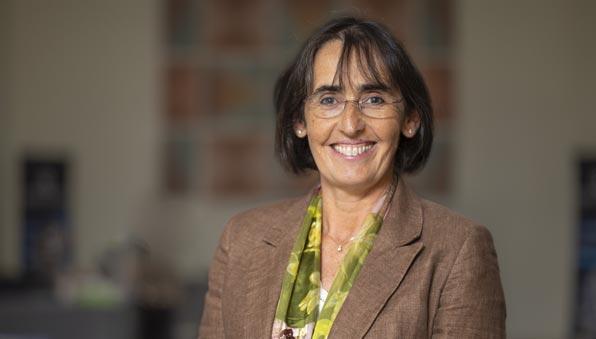
Established in 2016 during the COP22 Climate Summit in Marrakech, Morocco, the World Biogas Association was initially founded by three national organisation members and 20 company members. The group now represents 100 organisations from all inhabited continents and is in leadership groups on the Climate and Clean Energy Hubs for Global Policy.
Morton cites a study by the Climate and Clean Air Coalition (CCAC) which states that methane is 86 times more potent as a greenhouse gas than carbon
dioxide in its first 20 years in the atmosphere. “The Global Methane Assessment carried out by the CCAC demonstrates that tackling methane is the single most cost-effective way to keep temperatures below 2oC,” she says.
The Global Methane Pledge
Under the Global Methane Pledge, countries are committed to reducing methane emissions by 30 per cent
against 2020 levels by 2030. More than 150 countries around the world are signed up to the pledge, including all European Union member states and the United States of America.
“Today, we are only recycling around 2 per cent of our organic wastes, so that shows there is a real opportunity to do something about this and we can do this if we put our minds to it,” Morton says.
“If we deliver all of the potential of reducing emissions from organic waste, that would deliver around half of the Global Methane Pledge. That alone could deliver over 0.1oC of a reduction in temperature.”
“One third of all food produced is wasted, 80 per cent of wastewater is returned to the environment untreated, and of the 33 billion tonnes of livestock manure and slurry, almost all is spread back to land untreated while crop residues are often burnt causing an air quality issue.
“Mismanagement of these organic wastes is responsible for 6 per cent of global greenhouse gas emissions, contaminating freshwater and spreading disease and reducing biodiversity. This makes you realise how significant the contamination of our water streams and the sea is.”
92 renewable energy magazine
Uses of organic waste
Outlining the need to reduce organic waste and recycling them as much as possible, Morton states: “Anaerobic digestion is the technology today which gets the most value out of these wastes which is why, as an organisation, we promote the use of anaerobic digestion as the core technology. There are also lots of other complementary technologies which add value too.
“Collectively, if we could halve food waste –which is generally accepted that it would deliver 3 per cent reduction in global greenhouse gas emissions – and recycle all organic material which would reduce methane by 6 per cent, and displacing the fossil products with biomethane and digestate which would deliver a further 5 per cent, we would deliver a total greenhouse gas emissions saving of around 14 per cent.
“This is a really big number and there are lots of other benefits to that as well, not least contributing to nine United Nations’ Sustainable Development Goals. Moreover, all of that organic material contains the equivalent of around onethird of today’s global gas demand, there is a lot of valuable energy in there.”
Growing the biogas industry
Describing projections for growth of the biogas and biomethane sectors as “exciting”, Morton says: “The International Energy Agency [IEA]’s forecasts show that this industry is the second fastest growing energy sector in the planet.

“The global north is absolutely in a position to implement the kinds of policies that would allow biogas plants to be delivered at scale and fast. The global south would take a bit longer because in many parts of the global south there is not yet waste collection infrastructure in place, so it will take some time to put that in place first before the organics can be recycled.”
She further outlines how anaerobic digestion can also be a carbon-negative technology. “There are some companies which are focused already on building plants with a view to capturing the CO2, liquefying it, and putting it in the ground.”
Concluding, Morton emphasises the importance of a streamlined planning process, as upscaling global anaerobic digestion infrastructure will require construction of digestors at an unprecedented rate. “In the UK, it takes around seven years to get a permit for one plant. Given that we need to make hundreds of thousands of plants globally, we need to radically change the way in which planning and permitting happens.”
93 renewable energy magazine
Credit: World Biosgas Association.
District heating in Ireland
The built environment accounted for 12.3 per cent of Ireland’s greenhouse gas emissions in 2021. Climate Action Plan 2023 (CAP23) plans for up to 2.5 TWh of district heating by 2030 as part of decarbonisation efforts in this area.
CAP23 explicitly states that, for Ireland to reach its “highly ambitious” decarbonisation of built environment targets, all buildings will be required to switch to either heat pumps or district heating by 2050. Accordingly, the plan lays out interim targets for up to 0.8 TWh of district heating by 2025 and 2.5 TWh by 2030.
Of the district heating to be developed by 2030, the majority will be used in residential buildings, with CAP23 key performance indicators (KPIs) for the decarbonisation of residential housing outlining hopes for up to 0.7 TWh by 2025 and up to 2.5 TWh by 2030. Public and commercial heating decarbonisation contains much smaller KPIs of up to 0.1 TWh of district heating by 2025 and up to 0.2 TWh by 2030.
CAP23 also contains within it a commitment to finalise and implement the report of the District Heating Steering Group in order to supply up to 0.7 TWh of district heating for residential heating. The steering group
was founded under the aegis of Climate Action Plan 2021 and reports annually to the Government. It is chaired by Department of the Environment, Climate and Communications Assistant Secretary Barry Quinlan and contains representatives from said department, the Department of Housing, Local Government and Heritage, the Sustainable Energy Authority of Ireland (SEAI), the Commission for Regulation of Utilities, the National Development Finance Agency, Dublin City Council, South Dublin County Council, Limerick City and County Council, and the City of Dublin Energy Management Agency.
Published 31 August 2023, the steering group’s 2023 report returned 11 recommendations, the most notable of which included the foundation of a National District Heating Centre of Excellence within SEAI. Further recommendations included the undertaking of economic analysis and feasibility studies by the centre of excellence, the review of supports for
renewable heat production by SEAI and the Department of the Environment, Climate and Communications, that the Department of Housing, Local Government and Heritage strengthens references to district heating in the review of the National Planning Framework, and the development of a long-term strategy for district heating.
The National Heat Study states that district heating could, in time, supply as much as 50 per cent of Ireland’s heat demand; countries such as Denmark are leaders in the field, with 60 per cent of all houses heated through district heating networks, a figure that rises to 90 per cent in Copenhagen. District heating in Ireland, in comparison, is in its infancy, but projects such as the Tallaght District Heating Network and Energy Centre, opened in April 2023 and supplying heat to 32,800m2 of buildings using excess heat from a nearby data centre, give hope that this technology will play a key role in the decarbonisation of Ireland’s buildings.

94 renewable energy magazine
Credit: Chrissie Sternschnuppe
District heating pipes at Amagerværket power plant, Copenhagen.
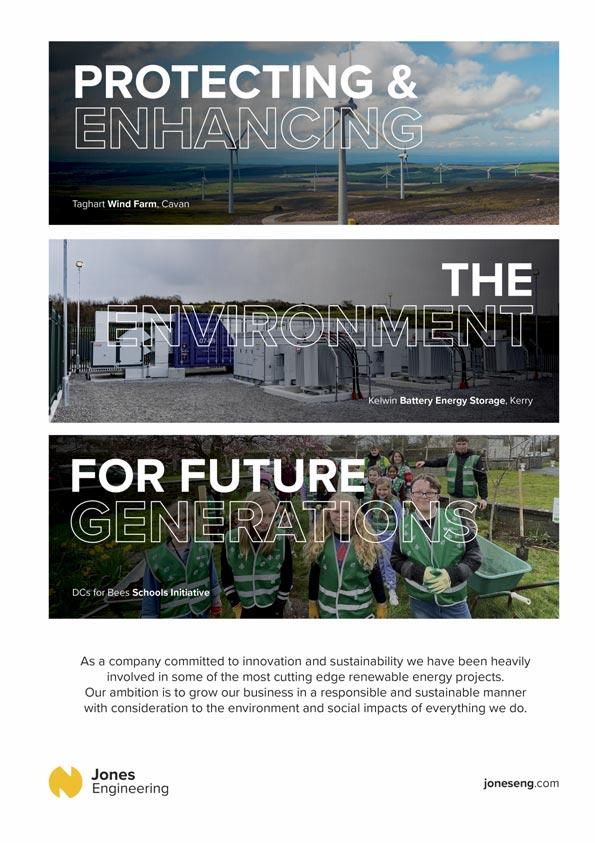
Embarking on a transformative journey towards sustainable heating solutions

Our founding members, including Fuels for Ireland, OFTEC, and the UK and Ireland Fuel Distributors Association, share a common conviction that urgent actions are imperative to safeguard our environment for future generations.

While climate-related concerns have dominated political discourse in recent years, progress towards actually achieving the Irish Government’s ambitious goal of carbon neutrality by 2050 has been disappointingly sluggish.
TAZCH therefore emerges as a crucial player, uniting businesses across the fuel and heating sectors to provide the much-
needed expertise and practical, industrybased solutions for decarbonising Ireland’s home heating sector.
Ireland remains heavily dependent on fossil fuels for heating, with approximately 700,000 homes relying on kerosene for warmth. Regrettably, only about 6 per cent of our heat sector demand is met by renewable energy, placing us far behind our European counterparts, where renewables account for an average of 22 per cent of demand. While the Government has acknowledged the necessity of emissions reduction in this sector, its primary focus has been on
electrification, pursuing an ambitious strategy to install 400,000 heat pumps in existing homes by 2030. While electrification is a crucial component, it is not a one-size-fits-all solution, as it entails the costly and disruptive mass retrofitting of buildings, averaging €56,000 per household.
Irrespective of whether the Government’s retrofitting targets are met, hundreds of thousands of households will continue to rely on liquid fuels for decades, and many of those who cannot avail themselves of retrofitting still seek ways to contribute to emission reduction. An
96 renewable energy magazine
In January 2022, The Alliance for Zero Carbon Heating (TAZCH) was established with a clear mission: to decarbonise Ireland’s home heating sector while ensuring the wellbeing of the 700,000 households reliant on liquid fuels.
all-encompassing solution is imperative, with liquid fuels at the forefront of this change. Achieving the State’s climate action targets necessitates a collective effort involving all stakeholders, acknowledging the need for a transformation in the fuels we provide, along with the available solutions to enact this change.
Alternative technologies
TAZCH firmly believes that achieving carbon neutrality requires the integration of alternative technologies alongside electrification in the heating sector. A range of advanced synthetic and biofuels have been proven to rapidly and efficiently reduce heating emissions by 87 per cent in a recent Irish trial. With this knowledge and industry expertise, TAZCH has engaged with parliamentarians, presented findings to policymakers, and communicated with the media regarding the pivotal role that advanced synthetic and biofuels can play in meeting our emissions reduction targets. So far, we have achieved notable progress and intend to build on this momentum throughout 2023, establishing low-carbon liquid fuels as a legitimate alternative for decarbonising the heating industry.
We can continue to pursue the current approach, which is falling short of delivering on our climate objectives, or we can build upon it, taking a technology-neutral stance which focuses on real-life delivery of emission savings.
Our solutions
TAZCH has put forward a series of innovative solutions, including the introduction of a renewable heating obligation mandating suppliers of energy in the heat sector to incorporate environmentally sustainable biofuels, similar to the successful Road Transport Obligation Scheme in the transport sector.
We propose a re-evaluation of the taxation system to incentivise low-carbon liquid fuels (LCLFs) like 96 (HVO), making them more accessible to consumers and significantly reducing carbon emissions. To support households in adopting new low-carbon technologies, we advocate for suitable grants and financial incentives.
Additionally, TAZCH is urgently exploring the replacement of older, inefficient noncondensing oil boilers through a scrappage scheme, which not only saves households money but also reduces emissions. None of these initiatives could be realised without encouraging and supporting public bodies to conduct trials with new liquid fuels like HVO, demonstrating the potential of biofuels in achieving Ireland's climate targets. Finally, we recommend the establishment of a Working Group on the Taxation of Energy and Fuels, facilitating collaboration between the Government, industry, and experts to achieve decarbonisation goals while ensuring a sustainable taxation intake.
A new era is within reach
TAZCH’s message is gaining widespread resonance and is aiming to serve as a catalyst for change. Throughout this year, TAZCH engaged with more than 30 members of the Oireachtas, including backbenchers, rural independents, government TDs, and Climate Action Committee members. This campaign has effectively established TAZCH as an industry leader, highlighting advanced synthetic and biofuels and prompting Minister Ryan’s acknowledgment of biofuels’ potential to reduce heating emissions.
TAZCH strongly advocated for the implementation of an ambitious Renewable Heat Obligation (RHO), compelling energy suppliers in Ireland’s heat sector to ensure a certain proportion of their energy is renewable. In November 2022, the Government committed to introducing an RHO by 2024, aiming to incentivise the use of all renewable heating fuels in Ireland, and fostering the development of indigenous anaerobic digestion.
It is essential to recognise that while electrification offers carbon reduction opportunities, it is not the exclusive path in the energy transition towards a carbon-neutral nation. TAZCH can contribute significantly to this transition, offering accessible carbon reduction solutions that benefit a broader segment of the population. With 700,000 homes in the Republic of Ireland relying on liquid fuel boilers, embracing low-carbon alternatives is crucial for reducing heating emissions.
T: 01 662 9814
E: kevin.mcpartlan@fuelsforireland.ie
W: www.fuelsforireland.ie
97 renewable energy magazine
“We can continue to pursue the current approach, which is falling short of delivering on our climate objectives, or we can build upon it, taking a technology-neutral stance which focuses on real-life delivery of emission savings.”
Storage research key to reliability
The twin challenge of ‘keeping the lights on’ and ‘keeping emissions down’ requires us to understand both the benefits and risk of a fully weather-driven power system.
Ireland’s power sector has climate targets that limit the cumulative amount of greenhouse gas pollution that can be released across the period 2021 to 2030 to 60 MtCO2eq.
In 2021 and 2022, the sector released approximately 20 million tonnes and recent EPA projections estimate that even with reaching an 82 per cent renewable electricity target in 2030, the sector will release 73 million tonnes, missing its legislated target by 13 MtCO2eq.
We know that increasing market-ready renewables is the best way to reduce greenhouse gas pollution in Ireland because it reduces the use of fossil fuel power plants, but it does not replace the need for plants, which will be required into the 2030s.
This is because, while climate policy is based on averages, power system security is influenced by extremes, and extremes in weather will have a profound impact on the future power system in Ireland.
Over the next decade, being able to operate the Irish power system during times with 100 per cent renewable
generation is key to reducing greenhouse gas pollution. Beyond that, being able to operate the system at times with close to 0 per cent of renewable generation is essential for reliability.
One such weather event that will test the reliability of the power system is a so-called ‘Dunkelflaute’ event, where extended periods of low wind speed can persist for up to two weeks.
These events occur already. For example, April to September 2021 was the least windy period for most of the UK and parts of Ireland in the last 60 years, but we have sufficient conventional capacity to deal with them today.
One way to deal with such events in countries like Ireland, which has reduced geographical diversity for interconnection, is to have both seasonal (GWh) and strategic (TWh) clean energy storage.

Seasonal energy storage acts to deliver energy ‘just in time’, whereas strategic storage is ‘just in case’.
This should be a research priority for Ireland over this decade. A reliable and secure electricity supply comes from spare capacity and storage infrastructure that acts as an insurance policy against risky events.
Energy security and climate action must be delivered in parallel to achieve a reliable and affordable future power system, writes Paul Deane, senior lecturer in clean energy futures at University College Cork.
98 renewable energy magazine
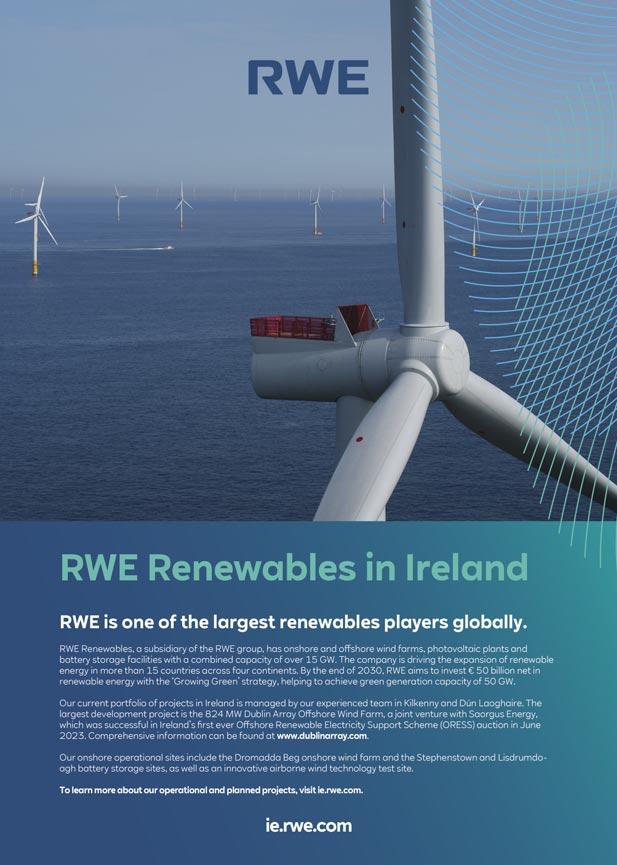
Measurement and insight to unlock net zero potential
Accelerating our net zero carbon goals requires focused action and effective planning. The surge in energy prices in recent times has increased the focus on energy management as well carbon footprint reduction.

National targets are clearly set out by sector, with the built environment being asked to reduce carbon emissions by 45 per cent, industry by 35 per cent, and transport by an especially challenging 50 per cent. Ireland has also been remarkable in embracing and remaining committed to home/remote working at Europe-leading levels. This can make carbon emission reductions even more complex and challenging. Emissions
from commuting may reduce but energy usage moves to a home setting still dominated by oil heating and low building quality.
Reverve Energy and its cloud service Verve, has the tools to manage the dual challenges of climate change and rising energy costs. Verve lets customers track their energy usage in detail as well as get valuable insights on energy patterns, anomalies and targeted action for energy reduction and efficiency. Reverve sees that each of its customers are on a unique path to net zero and it is important that the cloud platform allows them to map their own journey. It is vital that every journey starts with an energy
baseline. Reverve’s certified energy auditors and IoT devices lay down that baseline and ensure a certain starting point, allowing customers to zoom in on areas that need attention.
“We are always surprised at the conversations unlocked by our energy baseline,” says Sustainable Energy Director, Philip Doyle. “Customers may reach out initially with help on solar panels or heat pump grants. We frequently take them on a journey that shows that the most effective energy action may be in other areas, sometimes areas that are not even on their energy radar. Often the challenge of heat management and insulation dwarf the
100 renewable energy magazine
Ireland has set ambitious plans for energy efficiency and net zero emissions by 2050. Companies and public sector organisations may want or need to act sooner. Reverve Energy understands that energy measurement and insight are the keys to unlocking the progress needed on net zero.
scale and costs of electricity. That is why, in 2023, we have a huge focus on renewable heat and heat management.”
Measurement tools and targeted action
Reverve Energy has made a commitment to high quality energy data since the start. This data at regular intervals through the day, builds up a detailed picture of energy usage across the organisation and provides detailed insight. Sophisticated IoT devices are the cornerstone of their energy services.

Data Manager, Sireesha Talasila, says: “For me, data accuracy is a priority. We measure a wide range of energy sources for electricity, oil, gas, and heat. We use a complex range of IoT devices, but I always insist on MID-certified meters. This ensures the highest data quality and reliability and allows us to create richer downstream services for energy insight, bill validation and tenant billing.”
While energy measurement creates vast amounts of data very quickly, Reverve analyses this information to show customers the patterns that matter and the forecasts that show where intervention is most effective.
Armed with the insights from Verve’s analytics, customers can move to identifying the behaviour changes and energy investments that will have the most impact. Verve can help to size solar panel installations and accurately estimate their cost saving impact. For customers, this helps to make their business case for investment and accelerate the pathway to grant aid.
Verve’s measurements can track energy usage and compare usage across all sites in a large organisation. It makes comparison easy and highlights the most efficient sites. These exemplars can show the way for others and help set a baseline for excellence that other sites can strive to achieve.

Verve’s accurate, MID-certified data can also mean fair allocation of energy costs to building tenants. Customers report that this helps, mostly by including tenants in the targets for carbon reduction. When tenants can directly monitor, control, and influence their energy usage, they are more likely to reduce it. Too often, energy is bundled as a component in a service fee and tenants have no incentive to reduce energy or strive for efficiency.
Public sector reporting
Public sector bodies have their own
challenging targets and reporting requirements for 2030 and beyond. A 51 per cent reduction in greenhouse gas emissions by 2030 and a 50 per cent energy reduction means comprehensive measurement and focused action to achieve this very near-term target. For that reason, Verve has committed to making public sector reporting on energy progress as easy as possible. In most cases, reporting is automated and has zero impact on staff time.
Avoiding the constrained energy grid
Reverve Energy has seen an increasing challenge emerging from national infrastructure and the energy grid. The electricity grid is increasingly constrained. New connections for large-scale renewable investments are delayed and this may slow the decarbonisation of the grid. Delays in the development of a biomethane or hydrogen sector means that the gas grid also is restricted to
providing high carbon fossil fuels. The combination means that, increasingly, companies must look to their own sites and “behind the meter” to make progress on carbon reduction.
“The grid risks becoming the most expensive and high-risk source of energy,” says operations lead Terri Brannigan. “We are increasingly focused on customers generating their own energy and we are excited by the development of what we call gridinteractive buildings, using our Verve platform to optimise energy from solar, renewable heat and batteries and reaching out to the grid only when it is cost-effective. This will be an increasing area of activity for us in the future.”
T: 01 440 3865
E: Danielle.Quevedo@reverve.ie
W: www.reverve.ie
“For me, data accuracy is a priority. We measure a wide range of energy sources for electricity, oil, gas, and heat. We use a complex range of IoT devices, but I always insist on MID-certified meters.”
101 renewable energy magazine
Sireesla Talasila, Data Manager, Reverve Energy
Irish Renewable Gas conference 2023
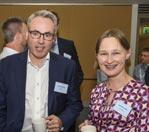
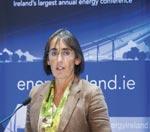
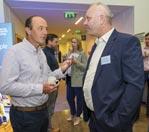
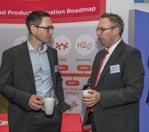

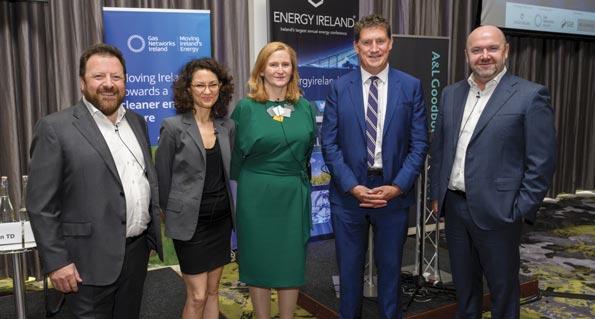
The 2023 Irish Renewable Gas conference recently took place, bringing together key stakeholders to focus on the future of renewable gas in Ireland. Delegates gained a detailed understanding of the developments in the gas sector and investigated potential options for decarbonising Ireland’s natural gas infrastructure. We were delighted to have a range of expert speakers, local and visiting, join us including Eamon Ryan TD, Minister for the Environment, Climate and Communications; Biljana Kulišic, European Commission; Luis Gay-Tarazona, Sustainable Energy Authority of Ireland; and Ciara Beausang, Teagasc.
We would like to take this opportunity to thank our conference partners, Gas Networks Ireland, and sponsors SSE and A&L Goodbody, all speakers, delegates and exhibitors who joined us in The Gibson Hotel and made the conference a huge success.

 Speakers: Padraig Fleming, Gas Networks Ireland; Kamila Waciega, Hydrogen Europe; Karen Kavanagh, Commission for Regulation of Utilities; Eamon Ryan TD, Minister for the Environment, Climate and Communications; and David Kelly, Gas Networks Ireland.
Mark Stockdale, A&L Goodbody with Stephen English, Gas Market Operator for Northern Ireland.
Sinead Guckian, Department of the Environment, Climate and Communications with Alice Hanly, NSAI.
Declan O’Sullivan, Gas Networks Ireland with Barry Murphy, Flogas Enterprise Solutions Limited.
Martin Regan, Marex with Andrea Ahern, Catagen.
Philip Hannon, Liquid Gas Ireland visits Jennifer Fagan, Calor Gas at the Calor Gas exhibition stand.
Speakers: Padraig Fleming, Gas Networks Ireland; Kamila Waciega, Hydrogen Europe; Karen Kavanagh, Commission for Regulation of Utilities; Eamon Ryan TD, Minister for the Environment, Climate and Communications; and David Kelly, Gas Networks Ireland.
Mark Stockdale, A&L Goodbody with Stephen English, Gas Market Operator for Northern Ireland.
Sinead Guckian, Department of the Environment, Climate and Communications with Alice Hanly, NSAI.
Declan O’Sullivan, Gas Networks Ireland with Barry Murphy, Flogas Enterprise Solutions Limited.
Martin Regan, Marex with Andrea Ahern, Catagen.
Philip Hannon, Liquid Gas Ireland visits Jennifer Fagan, Calor Gas at the Calor Gas exhibition stand.
102 renewable energy magazine
Charlotte Morton, World Biogas Association.
Empowering utility management: The evolution of prepayment gas metering

Streamlining utility network management: Enhancing operational efficiency
Utilities today need to have a strategic approach to simplify gas network management. With Intelis™ gFlex, Itron makes its solid-state technology available to reduce the necessity for frequent onsite maintenance while maintaining measurement accuracy over time. Additional features, such as programmable supply shutoff and exceptions management, address the challenges of reducing operational and maintenance costs.
Empowering consumers: A customer-centric approach
Through enhanced prepayment capabilities, consumers gain flexibility in purchasing gas through a myriad of offline and online payment channels. Real-time consumption data delivery via various channels empowers consumers to manage their budgets effectively.
Unlocking the potential of prepayment: Enhancing revenue assurance
Studies suggest that prepayment options can significantly reduce the need for debt collection and contribute to the recovery of unpaid bills when combined with traditional payment programs. Itron, Inc.
(NASDAQ: ITRI), a leading player in the field, is at the forefront of this transformation with the release of their next-generation ultrasonic prepayment gas meter, the Intelis™ gFlex. This groundbreaking meter combines cuttingedge technology with over three decades of Itron’s experience in prepayment metering solutions.
Intelis™ gFlex represents more than just technological progress in utility management—it is a catalyst for transforming the entire ecosystem. By offering flexible payment capabilities, simplifying network management, and enhancing the consumer experience, it paves the way for a future where utilities are more efficient and responsive to consumer needs. In this ever-changing landscape, it stands as an example of innovation in utility management, shaping a more consumer-centric, and operationally efficient future. W:
www.itron.com
103 renewable energy magazine
In the dynamic realm of utility management, technological advancements continually redefine how any industry runs its core business processes. Amidst the dynamic changes in the energy management sector, one cannot overemphasise the significance of innovative solutions for gas distributors and retailers.
Renewable energy companies and organisations
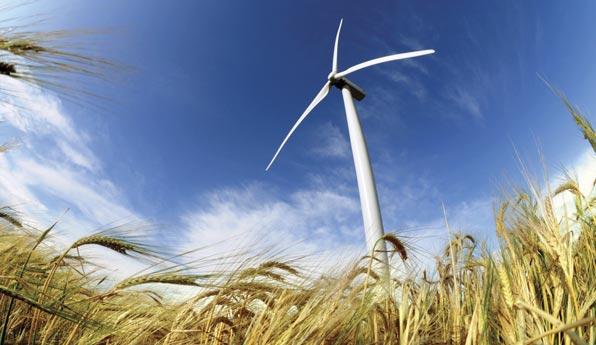
The following is an A-Z list of renewable energy players including industry associations, indigenous energy companies, wind developers, and other organisations.
Government departments and agencies
Action Renewables
Dublin Office
Innovation Campus, Old Finglas Road
Glasnevin, Dublin
Tel: 01 695 0743
Web: www.actionrenewables.ie
Email: info@actionrenewables.ie
Belfast Office
Boucher Business Studios
Glenmachan Place, Belfast, BT12 6QH
Tel: +44 (0)28 9072 7760
Web: www.actionrenewables.co.uk
Email: info@actionrenewables.co.uk
Chief Executive Officer: Terry Waugh
Bord na Móna
Main Street
Newbridge
Co Kildare, W12 XR59
Tel: +353 45 439 000
Web: www.bordnamona.ie
Head of Renewable Energy: John Reilly
COFORD Wood Energy
c/o Department of Agriculture, Food and the Marine
Johnston Castle Estate
Wexford, Y35 PN52
Tel: +353 53 917 0322
Web: www.coford.ie
Email: fsd@agriculture.gov.ie
Coillte
8 Dublin Road
Newtownmountkennedy
Co Wicklow, A63 DN35
Tel: 01 201 1199
Web: www.coillte.ie
CEO: Imelda Hurley
Commission for Regulation of Utilities (CRU)
The Grain House, The Exchange
Belgard Square North Tallaght, Dublin 24
D24 PXWO
Tel: 01 400 0800
Web: www.cru.ie
Email: info@cru.ie
Commissioner: Jim Gannon (Chair)
Commissioner: Aoife MacEvilly
Department of the Environment, Climate and Communications (DECC)
29-31 Adelaide Road
Dublin 2, D02 X285
Tel: 01 678 2000
Web: www.decc.gov.ie
Minister: Eamon Ryan TD
Secretary General: Oonagh Buckley
Assistant Secretary, Energy: Matthew Collins
104 renewable energy magazine
Assistant Secretary, Energy: Barry Quinlan
Assistant Secretary, Climate Action and Environment: Brian Carroll
Assistant Secretary, Natural Resources and Waste Policy: Philip Nugent
International and Offshore Energy Division Principal: Martin Finucane
Renewable Electricity: Philip Newsome
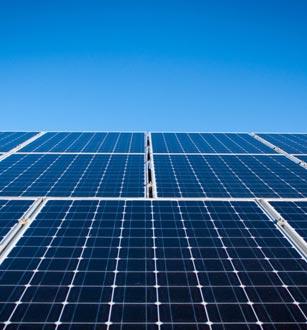
Offshore Energy, Environment and Consenting: Martina Hennessy
Electricity Networks and Systems: John Finnegan
Department for the Economy (Northern Ireland)
Netherleigh, Massey Avenue
Belfast, BT4 2JP
Tel: +44 (0)28 9052 9900
Web: www.economy-ni.gov.uk
Email: dfemail@economy-ni.gov.uk
Minister: Vacant
Permanent Secretary: Mike Brennan
Head of Energy: Richard Rodgers
Director of Energy Consumers,
Operations and Finance: Sarah Brady Energy Programme, Change
Management and Intelligence Unit
(Acting): Anne-Marie McConn
Director of Electricity and Security of
Supply: Peter Russell
Director of Heat, Buildings and Climate Change: Ryan White
Director of Business, Gas, Minerals and Petroleum: Jimmy Graham
Energy Saving Trust (Northern Ireland)
River House
48 High Street
Belfast, BT1 2BE
Tel: 0800 142 2865
Web: www.energysavingtrust.org.uk
Invest Northern Ireland
Bedford Square
Bedford Street
Belfast, BT2 7ES
Tel: +44 (0)28 9069 8000
Web: www.investni.com
Email: eo@investni.com
Chief Executive: Mel Chittock
Marine Institute
Rinville, Oranmore
Co Galway, H91 R673
Tel: 091 387 200
Web: www.marine.ie
Email: institute.mail@marine.ie
CEO: Paul Connolly
Sustainable Energy Authority of Ireland (SEAI)
3 Park Place, Hatch Street Upper Dublin 2
Tel: 01 808 2100
Web: www.seai.ie
Email: info@seai.ie
CEO: William Walsh
Director of Research and Policy
Insight: Margie McCarthy
Director of Corporate Services: Marion O’Brien
Director of Business, Public and Transport sectors: Declan Meally
Director of National Retrofit: Ciaran Byrne
Regional offices
Energy Policy Statistical Support Unit Building 2100
Cork Airport Business Park Cork, T12 KV8R
Finisklin Business Park, Co Sligo
Finnabair Industrial Estate, Dundalk Co Louth, A91 W8Y7
Tailte Éireann
Phoenix Park
Dublin 8, D08 F6E4
Tel: 01 802 5300
Web: www.tailte.ie
CEO: Liam O’Sullivan
Teagasc
Oak Park, Carlow, R93 XE12
Tel: 059 917 0200
Web: www.teagasc.ie
Email: info@teagasc.ie
Director: Frank O’Mara
Representative bodies
Electricity Association of Ireland
6 Merrion Square North, Dublin D02 FF95
Tel: +353 (1) 524 1046
Web: www.eaireland.com
Email: info@eaireland.com
Chief Executive: Dara Lynott
Energy Institute
61 New Cavendish Street
London, W1G 7AR
Tel: +44 (0)20 7467 7100
Web: www.energyinst.org
Email: info@energyinst.org
Republic of Ireland branch
Chair: Owen McQuade
Secretary: Liam P Ó Cléirigh
Email: ireland@energyinst.org
Northern Ireland branch
Chair: Mark Welsh
Secretary: Paul Andrews
Email: northernireland@energyinst.org
105 renewable energy magazine
Engineers Ireland
22 Clyde Road, Ballsbridge
Dublin, D04 R3N2
Tel: 01 665 1300
Web: www.engineersireland.ie
Director General: Damien Owens
Fuels for Ireland
13 Fitzwilliam Place
Dublin, D02 RX73
Tel: +353 (0) 1 662 9814
Web: www.fuelsforireland.ie
Email: info@fuelsforireland.ie
Chief Executive: Kevin McPartlan
FuturEnergy Ireland
27/28 Herbert Place
Dublin 2
D02 DC97
Tel: 01 669 8565
Web: www.futurenergyireland.ie
Email: info@futurenergyireland.ie
Geothermal Association of Ireland
Secretariat
c/o SLR (Environmental) Consulting Ireland Ltd
7 Dundrum Business Park
Windy Arbour, Dublin 14
Tel: 01 296 4667
Web: www.geothermalassociation.ie
Email: info@geothermalassociation.ie
Chair: Niall McCormack
Irish Bioenergy Association (IrBEA)

DCU Alpha Business Unit ICA104
Old Finglas Road, Glasnevin
Dublin 11, D11KXN4
Tel: 086 125 6709
Email: contact@irbea.org
CEO: Seán Finan
Irish Hydro Power Association
Joseph Stewart & Company
Corn Mills, Boyle, Co Roscommon
Tel: 071 967 0100
Web: www.irishhydro.com
Email: info@irishhydro.com
Contact: Neil Stewart
Irish Solar Energy Association
20 Harcourt Street
Dublin 2, DO2 H364
Tel: 01 902 0620
Web: www.irishsolarenergy.org
Email: info@irishsolarenergy.org
CEO: Conall Bolger
Marine Renewables Industry Association
c/o Leixfort, Corrig Avenue
Dún Laoghaire, Co Dublin
Web: www.mria.ie
Email: chairman@mria.ie
Chair: Peter D Coyle
Secretary: Raymond Alcorn
Meitheal na Gaoithe
(Irish Wind Farmers’ Association)
Kilkenny Research and Innovation Centre
Burrells Hall
St Kieran’s College, Kilkenny
Tel: 056 779 0856
Web: www.mnag.ie
Email: info@mnag.ie
Chair: Grattan Healy
RenewableNI
Arthur House, 41 Arthur Street
Belfast, BT1 4GB
Tel: +44 (0)28 9044 6240
Web: www.renewableni.com
Email: steven.agnew@renewableni.com
Head: Steven Agnew
Wind Energy Ireland
Sycamore House, Millennium Park
Osberstown, Naas, Co Kildare
W91 D627
Tel: 045 899 341
Web: www.windenergyireland.com
Email: office@windenergyireland.com
CEO: Noel Cunniffe
106 renewable energy magazine
Local energy agencies
3 Counties Energy Agency (3cea)
Kilkenny Research and Innovation
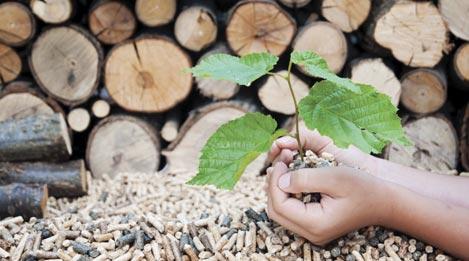
Centre
Burrell’s Hall
St Kieran’s College
Kilkenny
R95 TP64
Tel: +353 (0)56 779 0856
Web: www.3cea.ie
Email: admin@3cea.ie
CEO: Paddy Phelan
Bryson Energy
4th Floor, Stockmans House
39-43 Bedford Street
Belfast, BT2 7EE
Tel: +44 (0)28 9032 5835
Web: www.brysonenergy.org
Email: info@brysonenergy.org
Director: Nigel Brady
CODEMA
The Loft, 2-4 Crown Alley Temple Bar
Dublin 2, D02 TK74
Tel: 01 707 9818
Web: www.codema.ie
Email: codema@codema.ie
CEO: Donna Gartland
Cork City Energy Agency
Room 236
Anglesea Street City Hall
Cork
Tel: +353 (0)21 494 1508
Email: kevin.mcgill@corkcity.ie
Contact: Kevin McGill
Cork County Energy Agency
Cork County Council, Energy Section
Mallow Recycling Centre
Quartertown Industrial Estate
Mallow, Co Cork
Tel: 022 43610
Email: jean.sayers@corkcoco.ie
Contact: Jean Sayers
Galway Energy Agency Limited
City Hall, College Road, Galway
Galway County Council Energy
Programme
County Buildings
Prospect Hill
Galway
Tel: 091 566954
Kerry County Council
Áras an Chontae, Rathass
Tralee, Co Kerry
Tel: 066 718 3500
Email: goriordan@kerrycoco.ie
Contact: Gerry O’Riordan
Mayo County Council
Áras an Chontae, The Mall, Castlebar
Co. Mayo, F23 WF90
Tel: (094) 906 4000
Email: environment@mayococo.ie
Contact: Laura Dixon
Meath County Council
Energy Unit – Transportation Section
Buvinda House, Dublin Road
Navan, County Meath, C15 Y291
Tel: 046 909 7000
Email: lfagan@meathcoco.ie
Contact: Lara Fagan
Midlands Energy Agency
Laois County Council
County Hall, JFL Avenue
Portlaoise, R32 EHP9
Tel: 057 86 64000
Email: corpaffairs@laoiscoco.ie
Tipperary Energy Agency Limited
93 Silver Street
Nenagh, Co Tipperary
E45 AD65
Tel: 052 744 3090
Email: info@tippenergy.ie
Web: www.tippenergy.ie
Chief Executive Officer: Lisa Vaughan
Waterford Energy Bureau
4th Floor, Menapia Building
The Mall, Waterford, X91 PK15
Tel: 058 21429
Web: www.waterfordcouncil.ie
Email: lfleming@waterfordcouncil.ie
Contact: Liam Fleming
Renewable energy companies
Balcas Energy
75 Killadeas Road, Laragh
Ballinamallard
Enniskillen, BT94 2ES
Tel: +44 (0)28 6632 3003
Web: www.balcas.com
Email: info@balcas.com
Bord na Móna
Main Street, Newbridge
Co Kildare, W12 XR59
Tel: 045 439 000
Web: www.bordnamona.ie
Head of Powergen Development: John Reilly
107 renewable energy magazine
Bord Gáis Energy
1 Warrington Place
Dublin 2
Tel: 01 233 5000
Web: www.bordgaisenergy.ie
Email: info@bordgais.ie
Managing Director: Dave Kirwan
Calor
Longmile Road, Dublin 12
Tel: 01 1850 812 450
NI: +44 (0)28 9045 5588
Web: www.calorgas.ie
Chief Executive: Duncan Osborne
Clearpower
Knockbrack House, Matthews Lane
Donore Road, Drogheda
Co Louth, A92 T803
Tel: 01 462 5000
Email: info@clearpower.ie
DP Energy Ireland Ltd
Mill House, Buttevant
Co Cork, P51 TN35
Tel: 02 223 955
Web: www.dpenergy.com
Email: info@dpenergy.com
ElectroRoute
2 Cumberland Place
Third Floor, Fenian Street
Dublin 2, D02 H0V5
Tel: 01 687 5700
Web: www.electroroute.com
Email: info@electroroute.com
CEO: Ronan Doherty
EirGrid
The Oval
160 Shelbourne Road
Ballsbridge
Dublin 4, D04 FW28
Tel: 01 677 1700
Web: www.eirgridgroup.com
Email: info@eirgrid.com
Chief Executive: Mark Foley
Energia – Renewables
The Liberty Centre
Blanchardstown Retail Park
Dublin 15
D15 YT2H
Tel: 01 869 2000
Web: www.energia.ie
Email: Contact@energiagroup.com
Managing Director: Peter Baillie
ESB
27 Fitzwilliam Street Lower
Dublin, D02 KT92
Tel: 01 676 5831
Web: www.esb.ie
Email: info@esb.ie
Chief Executive: Paddy Hayes
ESB Networks
Three Gateway, East Wall Road
Dublin 3, D03 R583
Tel: 1800 372 757
Web: www.esbnetworks.ie
Managing Director: Nicholas Tarrant
Gas Networks Ireland
Gasworks Road, Cork
T12 RX96
Tel: 021 453 4000
Web: www.gasnetworks.ie
Email: networksinfo@gasnetworks.ie
CEO: Cathal Marley
GE Grid Solutions
Tel: +353 1 402 1100
Web: www.gegridsolutions.com
Email: GridSolutions.Ireland@ge.com
Country Sales Director: Séamus Ó Caoimh
Greenlink Interconnector Limited
Unit 3, 4075 Kingswood Road
Citywest Business Campus
Saggart, Co Dublin
D24 KF85
Web: www.greenlink.ie
Email: info@greenlink.ie
Contact: John Daly
Hitachi Energy Ireland Limited
Block B, Liffey Valley Office Campus
Dublin, 22, D22 X0Y3
Tel: +353 1 574 7981
Email: contact-us@hitachienergy.com
Managing Director: Laura Fleming
Indaver Ireland
The Highline, 1st Floor
Bakers Point, Pottery Road
Dún Laoghaire, Co Dublin, A96 KW29
Tel: 01 697 2900
Web: www.indaver.ie
Email: info@indaver.ie
Irving Oil
Whitegate
Midleton, Co Cork
Tel: 021 462 2200
Email: Webinquiries@irvingoil.com
KRA Renewables
Head Office
E11a Network Enterprise Park
Kilcoole
Co Wicklow
Dublin Office Suite 54
20 Harcourt Street
Dublin 2
Tel: +353 (0)1 524 0555
Web: www.krarenewables.ie
Email: ciara@kra.ie
Contact: Ciara Ledwidge
Mainstream Renewable Power
Ground Floor, Block G
Central Park, Leopardstown
Dublin, D18 NH10
Tel: 01 290 2000
Web: www.mainstreamrp.com
Email: info@mainstreamrp.com
Group Chief Executive: Mary Quaney
Nordex Energy Ireland Ltd
Clonmel House Business Centre
Clonmel House, Forster Way
Swords Demesne, Swords
Co Dublin
Tel: 01 897 0260
Web: www.nordex-online.com
Email: salesireland@nordexonline.com
Managing Director: Jason Welch
NTR plc
1st Floor, The Hive Carmanhall Road
Sandyford Business Park
Dublin, D18 Y2C9
Tel: 01 206 3700
Web: www.ntrplc.com
Email: info@ntrplc.com
Chief Executive: Rosheen McGuckian
Pinergy
Suite 1, Beaver House
Beech Hill Office
Dublin 4, D04 Y8X5
Tel: +353 818 363 749
Web: www.pinergy.ie
Email: customerservices@pinergy.ie
Chief Executive: Ronan Power
Quality Freight
Port Centre, Alexandra Road
Dublin, D01 H4C6
Tel: +353 (0) 1 836 6233
Web: www.qualityfreight.com/contact/dublin
Email: sryan@qualityfreight.com
Commercial Manager: Shaun Ryan
RWE Renewables Ireland Limited
Unit 5, Desart House Lower New Street
Kilkenny, R95 H488
Web: www.rwe.com/ireland
Email: ireland@rwe.com
Contact: Cathal Hennessy
SIAC Construction
Knockmeenagh House
Monastery Road
Clondalkin, Dublin 22
D22 F6V2
Tel: 01 403 3111
Web: www.siac.ie
Email: info@siac.ie
108 renewable energy magazine
Simply Blue Group
Dublin Office
43 Fitzwilliam Place
Dublin 2
D02 FY81
Cork office Floor 3, Centre Park House Centre Park Road
Blackrock
Cork City, T12 RK0N
Web: www.simplybluegroup.com
Email: info@simplybluegroup.com
Contact: Sam Roch-Perks
Siemens Limited
Innovation House
DCU Alpha
Old Finglas Road, Dublin 11
Tel: 01 450 2655
Web: www.siemens.ie
SSE Renewables

Red Oak South
South County Business Park
Leopardstown
Dublin, D18 W688
Tel: +353 1 655 6400
Managing Director: Stephen Wheeler
Veolia
Suite 18, Plaza 256
Blanchardstown Corporate Park 2
Blanchardstown
Dublin 15, D15 H210
Tel: +353 0 1 870 1280
Web: www.veolia.ie
Service providers
ABCO Divers
282 Moira Road
Lisburn, BT28 2TU
Tel: +44 (0)28 9202 7770
Web: www.abcodivers.co.uk
Email: operations@abcodivers.co.uk
Aecom
4th Floor, Adelphi Plaza
George’s Street Upper
Dún Laoghaire, A96 T927
Tel: 01 238 3100
Web: www.aecom.com
Arctic Ships Agents
Roshine Road
Killybegs
Co Donegal
Tel: +44 (0)74 974 1165
Web: www.arcticshipsagents.com
Email: info@arcticshipsagents.com
Arup Consulting Engineers
One Albert Quay
Cork, T12 X8N6
Tel: 021 422 3200
Web: www.arup.com
Email: cork@arup.com
Contact: Liam Luddy
CADFEM Ireland
18 Windsor Place Dublin 2, D02 PW74
Tel: +353 (0)16 522 730
Web: www.cadfem.net
Email: info@cadfem.ie
Director: Derek Sweeney
Grant Engineering Ireland
Crinkle, Birr
Co Offaly, R42 D788
Tel: +353 (0)57 91 20089
Web: www.grant.ie
Email: info@grant.ie
Hydrographic Surveys Limited
Unit 12, Owenacurra Business Park
Midleton, Co Cork
P25 C563
Tel: 021 483 1184
Web: www.hydrosurvey.com
Email: info@hydrosurvey.com
IGSL Ltd
Unit F, M7 Business Park
Naas, Co Kildare
Tel: 045 846 176
Web: www.igsl.ie
Email: info@igsl.ie
Irish Drilling Ltd
Old Galway Road
Loughrea, Co Galway
Tel: 091 841 274
Web: www.irishdrilling.ie
Email: info@irishdrilling.ie
Itron Management Consultants Ireland
Hatch Street Upper Block 1000, Unit 1105
Cork, V35 TK35
Tel: +353 21 441 0000
Web: www.itron.com
Jacobs Engineering
Merrion House, Merrion Road
Dublin, D04 R2C5
Tel: +353 0.1.269.5666
Web: www.jacobs.com
Contact: Joanne Moran
Jones Engineering
83 Pembroke Road
Dublin 4, D04 HN50
Tel: +353 1 474 9800
Web:
www.joneseng.com/contact/ireland
Contact: Pat Murphy
Kingspan Water & Energy Ltd
180 Gilford Road, Portadown
Co Armagh, BT63 5LF
Tel: +44 (0)28 3836 4400
Web:
www.kingspanwaterandenergy.com
Email: contact@kingspan.com
109 renewable energy magazine
Medite Europe Ltd
Redmondstown, Clonmel
Co Tipperary, E91 V584
Tel: 0 1322 424900
Web: www.mdfosb.com
Email: david.murray@mdfosb.com
Contact: David Murray
Mott MacDonald Ireland Ltd
South Block, Rockfield
Dundrum, Dublin
D16 R6V0
Tel: 01 291 6700
Web: www.mottmac.com/ireland
Email: dublin@mottmac.com
Occupli
Euro Business Park
Cork
T45 DK25
Tel: 0818 315 415
Web: www.occupli.com
Email: info@occupli.com
Contact: Martin Clancy
P&O Maritime Services
Parkmore Business Park West
Galway
Tel: 091 773 980
Web: www.pomaritime.com
Email: poml.europe@pomaritime.com
Reverve Energy
101 George's Street Upper
Dún Laoghaire, County Dublin
Tel: +353 (0) 1 440 3865
Web: www.reverve.ie
Email: danielle.quevedo@reverve.ie
Ridgeway
Unit 1&2 Greene Park, Ratoath Road
Ashbourne, Co Meath, A84 XD98
Tel: 01 802 7173
Web: www.ridgeway-online.com
Email: info@ridgeway-online.com
RPS Group
West Pier Business Campus
Dún Laoghaire, Co Dublin
A96 N6T7
Tel: 01 488 2900
Web: www.rpsgroup.com/ireland
Contact: Olivier Gaillot
Shannon Foynes Port Company
Harbour Office
Foynes, Co Limerick
V94R232
Tel: 069 73 100
Web: www.sfpc.ie
Email: info@sfpic.ie
CEO: Pat Keating
SKE Solar
Tel: +43 732 641065-70
Web: www.ske-solar.com
Email: akash.bais@ske-solar.ie
Contact: Akash Bais
SLR Consulting Ireland
7 Dundrum Business Park
Windy Arbour, Dublin
D14 N2Y7
Tel: 01 296 4667
Email: noniell@slrconsulting.com
Contact: Nick O’Neill
Smith Brothers Contracting Limited
3 Inns Quay Dublin
Tel: 01 903 6480
Web: www.smithbrothers.ie
Email: info@smithbrothers.ie
SmartBay Ireland
Rinville
Oranmore
Co. Galway, H91 R673
Tel: +353 (0)9 138 7200
Web: www.smartbay.ie
Email: info@smartbay.ie
Solmatix Ltd
14 Glenwell Road
Newtownabbey
Co Antrim, BT36 7RF
Tel: +44 (0)28 9082 4000
Web: www.solmatix.com
Email: info@solamatix.com
SSL International Marine Ltd
Main Street, Foynes, Co Limerick
Tel: 069 65 710
Web: www.sslmarine.ie
Email: services@sslmarine.ie
Contact: Helen Fitzgerald
Subsea Marine Limited
15 Belfry Gardens, Dundalk
Co Louth, A91 V5Y6
Tel: 087 254 7362
Web: www.subseamarine.ie
Email: info@subseamarine.ie
TechWorks Marine
Pottery Enterprise Zone
Pottery Road, Dún Laoghaire
Co Dublin, A96 K571
Tel: 01 236 5990
Web: www.techworks.ie
Chief Executive: Charlotte O’Kelly
Trinity College Dublin
College Green
Dublin 2
Tel: 01 896 1000
Web: www.tcd.ie
Legal advisors
A&L Goodbody LLP
3 Dublin Landings
North Wall Quay
Dublin 1, D01 C4E0
Tel: 01 649 2000
Web: www.algoodbody.com
Email: rmoore@algoodbody.com
Partner: Ross Moore
Addleshaw Goddard LLP
Temple Chambers
3 Burlington Road
Dublin 4, D04 RD68
Tel: 01 202 6400
Web: www.addleshawgoddard.com
Byrne Wallace
88 Harcourt Street
Dublin 2, D02 DK18
Tel: 01 691 5000
Web: www.byrnewallace.com
Email: info@byrnewallace.com
Beauchamps Solicitors
Riverside Two
Sir John Rogerson's Quay
Dublin 2, D02 KV60
Tel: 01 418 0600
Web: www.beauchamps.ie
Email: info@beauchamps.ie
Partner: Ainsley Heffernan
Carson McDowell
27-28 Herbert Place
Dublin 2, D02 DC97
Tel: 01 9053 720
Web: www.carson-mcdowell.com
Email: law@carson-mcdowell.com
Senior Partner: Neasa Quigley
Murray House, Murray Street
Belfast, BT1 6DN
Tel: +44 (0)28 9024 4951
Elva Carbery
Pembroke House
28-32 Upper Pembroke Street
Dublin 2, D02 EK84
Tel: +353 86 839 9224
Web: www.elvacarbery.ie
Email: elva@elvacarbery.ie
110 renewable energy magazine
OPENFORBOOKINGS

Yearbook 2024
The essential desktop sourcebook for the Irish energy sector.
Advertising opportunities for 2024
This year is the 25th edition of the Energy Ireland Yearbook. The Energy Ireland Yearbook is a high quality reference source for users interested or involved in Irish energy from inside or outside Ireland – this includes policymakers, regulators, energy sector company executives, facilities managers, large energy users and professional firms servicing Ireland’s rapidly developing energy markets.
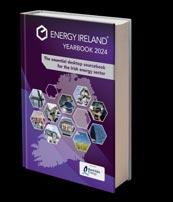

• Energy policy north and south
• Renewable and sustainable energy
• Overview of electricity market networks
• Gas sector including biogas
Benefits of advertising:
4 Direct contact with key decision makers within the energy sector
4 Distributed directly to delegates at energy conferences north and south throughout the year
4 Excellent opportunity to profile/showcase your organisation’s goods/services to a key audience throughout the energy sector
4 Gain recognition as a thought leader
• Sustainable energy in industry and transport


• Digital energy
• Unique who’s who in Irish energy
The Energy Ireland Yearbook is the only detailed guide to Irish energy (north and south). Content includes: Tel: +353 (0)1 661 3755 Email: gail.kinkead@energyireland.ie
www.energyireland.ie
Eversheds Sutherland LLP
One Earlsfort Centre, Earlsfort Terrace
Dublin 2, D02 X668
Tel: 01 664 4200
Web: www.eversheds-sutherland.com

Email: markvarian@evershedssutherland.ie
Partner: Mark Varian
Fieldfisher Ireland LLP
45 Mespil Road
Dublin 4, D04 W2F1
Tel: 01 828 0600
Web: www.fieldfisher.ie
Email: info.ireland@fieldfisher.com
LK Shields Solicitors
38 Upper Mount Street
Dublin 2, D02 PR89
Tel: 01 661 0866
Web: www.lkshields.ie
Email: pdaly@lkshields.ie
Partner: Philip Daly
Maples and Calder
75 St. Stephen’s Green
Dublin 2, D02 PR50
Tel: 01 619 2000
Web: www.maplesandcalder.com
Mason Hayes & Curran South Bank House
Barrow Street, Dublin 4
D04 TR29
Tel: 01 614 5000
Web: www.mhc.ie
Email: dublin@mhc.ie
Matheson
70 Sir John Rogerson’s Quay, Dublin 2
Tel: 01 232 2000
Web: www.matheson.com
Email: garret.farrelly@matheson.com
Partner: Garret Farrelly
McCann Fitzgerald LLP
Riverside One
Sir John Rogerson’s Quay
Dublin, D02 X576
Tel: 01 829 0000
Web: www.mccannfitzgerald.ie
Email:
valerie.lawlor@mccannfitzgerald.com
Partner: Valerie Lawlor
Philip Lee Solicitors
Connaught House
One Burlington Road Dublin 4, D04 C5Y6
Tel: 01 237 3700
Web: www.philiplee.ie
Email: info@philiplee.ie
Partner: Philip Lee
Pinsent Masons LLP
1 Windmill Lane, Dublin 2 D02 F206
Tel: 01 553 8600
Web: www.pinsentmasons.com
Email:
richard.murphy@pinsentmasons.com
Partner: Richard Murphy
Tughans
The Ewart, 3 Bedford Street
Belfast, BT2 7EP
Tel: 028 9055 3300
Web: www.tughans.com
Email: maria.oloan@tughans.com
Partner: Maria O’Loan
William Fry Solicitors
2 Grand Canal Square
Dublin Docklands
Dublin 2, D02 A342
Tel: 01 639 5000
Web: www.williamfry.com
Email: liam.mccabe@williamfry.com
Chairperson: Liam McCabe
William Orbinson QC
The Bar Library
91 Chicester Street
Belfast, BT1 3JQ
Tel: +44 7860 2453 24
Web: www.williamorbinson.co.uk
Email: william.orbinson@barlibrary.com
Financial and economic advisors Accenture
1 Grand Canal Square
Dublin 2, D02 P820
Tel: 01 646 2000
Web: www.accenture.com
AIB Group
10 Molesworth Street
Dublin 2
Tel: 01 772 4003
Web: www.aib.ie
Contact: Eoghan O’Neill
Bank of Ireland
Baggot Plaza
27-33 Upper Baggot St
Dublin, D04 VX58
Tel: +353 (0)1 661 5933
Web: www.bankofireland.com
Barclays
One Molesworth Street
Dublin 2, D02 RF29
Tel: 01 618 2600
Web: www.barclays.ie
BNP Paribas
Termini, 3 Arkle Road
Sandyford, Dublin 18, D18 T6T7
Tel: 01 612 5000
Web: www.bnpparibas.ie
Email: dublin.queries@bnpparibas.com
Davy Corporate Finance Ltd
Davy House, 49 Dawson Street
Dublin 2, D02 PY05
Tel: +353 (0)1 679 7788
Web: www.davy.ie
Email: capitalmarkets@davy.ie
EY EY Building
Harcourt Centre
Harcourt Street, Dublin 2
Tel: 01 475 0555
Web: www.ey.com/en_ie
Bedford House, 16 Bedford Street
Belfast, BT2 7DT
Tel: +44 (0)28 9044 3500
112 renewable energy magazine
Goodbody Corporate Finance
2 Ballsbridge Park, Ballsbridge
Dublin 4, D04 YW83
Tel: 01 667 0400
Web: www.goodbody.ie
Email: finbarr.j.griffin@goodbody.ie
Contact: Finbarr Griffin
KPMG
1 Stokes Place
St Stephen’s Green
Dublin 2, D02 DE03
Tel: +353 1 410 1000
Web: www.kpmg.com
Email: mike.hayes@kpmg.com
Partner and Global Head of
Renewables: Mike Hayes
PwC
One Spencer Dock
North Wall Quay, Dublin 1
Tel: 01 792 6000
Web: www.pwc.ie
Contact: Ronan MacNiocláis
Merchant Square
20-22 Wellington Place
Belfast, BT1 6GE
Tel: +44 (0)28 9024 5454
Web: www.pwc.co.uk
Surety Bonds

Unit 1, Block C
Hartley Business Park
Carrick on Shannon
Co Leitrim, N41 X528
Tel: +353 (0)71 962 3228
Web: www.suretybonds.ie
Email: bonds@suretybonds.ie
Managing Director: Colm McGrath
Ulster Bank
Head Office
Block 13, Central Park
Leopardstown
Dublin 18, D18 N153
Tel: 0818 211 690
Web: www.ulsterbank.ie
113 renewable energy magazine
Renewable energy research institutions
Centre for Advanced Sustainable Energy (CASE)
Queen’s University Belfast
CASE is a £10 million centre for industry driven research, aligning renewable energy expertise at Queen’s University Belfast, Ulster University and AFBI with the research needs of participating companies. Through the Invest NI Competence Centre Programme, CASE funds collaborative R&D in sustainability.
Research interests:
• bioenergy;
• energy systems; and
• marine renewable energy.
Contact details:
Centre for Advanced Sustainable Energy
Queen’s University Belfast
David Kerr Building, Stranmillis Road
Belfast, BT9 5AG
Tel: +44 (0)28 9097 5577
Web: www.case-research.net
Email: martin.doherty@qub.ac.uk
Contact: Martin Doherty
Centre for Marine and Renewable Energy Ireland (MaREI)
University College Cork
MaREI is the SFI Research Centre for Energy, Climate and Marine research and innovation co-ordinated by the Environmental Research Institute (ERI) at University College Cork. The centre comprises over 220 researchers focusing on defined global challenges such as the energy transition, climate action and the blue economy.
Research interests:
• coastal and marine systems;
• marine renewable technologies;
• bioenergy;
• materials and structural testing;
• observation and operations;
• energy policy and modelling; and
• energy management.
Contact details:
Marine and Renewable Energy Ireland (MaREI)
Beaufort Building
Environmental Research Institute
University College Cork
Haulbowline Road
Ringaskiddy, Co Cork
Tel: 021 486 4300
Web: www.marei.ie
Email: marei@ucc.ie
Centre Directors: Brian Ó Gallachóir and Jerry Murphy
Centre for Renewables and Energy Dundalk Institute of Technology (CREDIT)
The Centre for Renewables and Energy at Dundalk IT is an applied research centre based in the School of Engineering established in 2002. The centre seeks national and EU funds to pursue research projects in the topics of wind energy, energy storage, bioenergy and wave energy.
Research interests:
• wind energy;
• oceandemo project;
• INTERREG VA SPIRE2;
• SEAI RD&D 2018 Dundalk virtual energy microgrid project;
• bioenergy; and
• wave energy research.
Contact details:
Centre for Renewables and Energy
Dundalk Institute of Technology
Dublin Road
Dundalk
County Louth, A91 K584
Tel: +353 (0)42 937 0474
Web: www.credit.ie
Email: admin@credit.ie
Centre Director: Paul MacArtain
COFORD
COFORD is part of the Department of Agriculture, Food and the Marine’s research division. Established in 1993, it is responsible for the development of national forest research and development policy and priorities.
Research interests:
• wood energy, harvesting and processing forest biomass for energy production in Ireland;
• climate change – impact adaption and mitigation – responding to a changing climate; and
• expansion of the forest resource –sustainable increase in productive area.
Contact details: COFORD
Forest Sector Development
Department of Agriculture, Food and the Marine
Johnstown Castle
Wexford
Tel: +353 (0) 53 917 0322
Web: www.coford.ie
Email: fsd@agriculture.gov.ie
Energy Institute
University College Dublin
UCD Energy Institute plays an integral part in the energy transition, endorsing a net zero carbon energy system, promoting modernised integrated energy systems while empowering the citizen through education, innovation and digitalisation.
Research interests:
• energy systems;
• energy management; and
• energy in society.
Contact details:
Energy Institute
UCD O'Brien Centre for Science
University College Dublin
Belfield, Dublin 4
Tel: +353 1 716 2625
Web: www.energyinstitute.ucd.ie
Email: energy@ucd.ie
Contact: Andrew Keane
Energy, Power and Intelligent Control (EPIC)
Queen’s University Belfast
Research within EPIC is focused on problems related to distributed sources of energy and their integration into power networks, control and intelligent systems. The EPIC research facility is equipment with various forms of renewable energy generation including wind turbines, solar photovoltaics and biodiesel generators. It has expertise in monitoring large wind farms and simulating their effects and integration with the electricity grid.
Research interests:
• power systems and smart grid;
• renewable energy;
• intelligent systems; and
• virtual reality and robotics.
Contact details:
Energy, Power and Intelligent Control
School of Electronics, Electrical Engineering and Computer Science
Ashby Building
Stranmillis Road
Belfast, BT9 5AH
Tel: +44 (0)28 9097 4669
Email: dr-epic@qub.ac.uk
Energy Research Centre University of Galway
The Energy Research Centre focuses on research, education and outreach in the fields of energy and environment. Established in 2007, it is part of the Ryan Institute (for environment, marine and energy research). The centre is divided into four thematic research groups: bioenergy research; renewable resources; energy efficient technologies; energy and society.
114 renewable energy magazine
The following is an A-Z list of institutions involved in renewable energy research.
Research interests:
Bioenergy Research Group
• microbial fermentations and digestion of organic feedstocks;
• biocatalytic fuel cells; and
• combustion chemistry.
Energy Efficient Technologies Group
• energy efficient wastewater treatment;
• power conversion technologies;
• energy and buildings;
• energy storage;
• efficient materials technology; and

• solar capture.
Renewable Resources Group
• the use of high-resolution bathymetric data obtained from the INSS and INFORMAR programmes as an input into massively parallelised hydrodynamic modelling code to infer those locations in the offshore zone which would be optimum for tidal energy.
Contact details:
Energy Research Centre
Ryan Institute, University of Galway University Road, Galway
Tel: 091 495 061
Web: www.universityofgalway.ie
Email: energy@universityofgalway.ie
Energy Research Group Trinity College Dublin
The Energy Research Group focuses on the development of next-generation renewable energy technologies, while also examining topics such as energy recovery and behavioural change to address sustainability.
Two prominent initatives exist under this research theme: Trinity Haus, an innovation centre focusing on energy in buildings and sustainability in the built environment; and the Solar Energy Applications Group (SEAG), leading research group working in solar energy.
Research interests:
• hydro;
• solar;
• wind; and
• wave.
Contact details:
Energy Research Group
Department of Civil, Structural and Environmental Engineering
Museum Building, Trinity College Dublin
Dublin 2
Tel: 01 896 1457
Web: www.tcd.ie/civileng/research/energy/
Email: civeng@tcd.ie
Contact: Biswajit Basu
Environment and Renewable Energy Centre (EREC)
Agri-Food and Biosciences Institute (AFBI)
The Environment and Renewable Energy Centre (EREC) based at AFBI Hillsborough assists the agri-food industry to maximise the potential of renewable energy and support technology transfer activities.
Research interests:
• evaluation of short rotation coppice (SRC) willow production with bioremediation of dirty water;
• storage and utilisation of biomass crops;
• the carbon footprint of agricultural enterprises;
• combustion and emission characteristics of varying biomass sources;
• demonstration of other renewable energy technologies;
• demonstration of energy saving design and technology; and
• anaerobic digestion of animal manure.
Contact details:
Environment and Renewable Energy Centre (EREC) Agri-Food and Biosciences Institute (AFBI)
Large Park, Hillsborough Co Down, BT26 6DR
Tel: +44 (0)28 9268 2484
Web: www.afbini.gov.uk/articles/environment-andrenewable-energy-centre
Email: renewable.energy@afbini.gov.uk
Contact: Stanley McDowell
Environmental Research Institute University College Cork
The Environmental Research Institute was established in 2000 and is aimed at supplying environmental research and education at UCC. The institute brings together expertise in biological, chemical and environmental sciences as well as environmental engineering, energy and law. The institute has over 150 researchers and five thematic research areas, one of which is sustainable energy and environmental engineering.
Research interests:
• wind energy;
• bioenergy and biofuels;
• energy policy and modelling;
• climate change (GHG flux modelling and climate change adaption); and
• marine renewable energy.
Contact details:
Environmental Research Institute (ERI) Lee Road, Cork, T23 XE10
Tel: 021 490 1931
Web: www.ucc.ie/en/eri
Email: eri@ucc.ie
Contact: Paul Bolger
Marine Institute, Galway
Established by the Marine Institute Act 1991, the Marine Institute is the national agency responsible for marine research, technology development and innovation. The institute operates an ocean energy test site with SEAI. Real-time wave information is available at the Galway Bay test site for all developers of wave energy devices who have a prototype that is built for open water testing in a relatively sheltered location.
Research interests:
• marine technology;
• climate change; and
• marine biotechnology.
Contact details:
Marine Institute
Rinville, Oranmore, Co Galway, H91 R673
Tel: 091 387 200
Web: www.marine.ie
Email: institute.mail@marine.ie
Teagasc
Teagasc – the Agriculture and Food Development Authority, provides integrated research and advisory and training services to the agricultural and food sectors as well as rural communities. It is funded by the State, research programmes and other revenue streams. In the area of energy research, Teagasc aims to promote the development and expansion of renewables production from agricultural sources.
Research interests:
• energy crops;
• liquid biofuels;
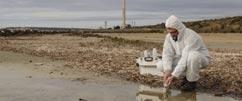
• biomass combustion;
• carbon sequestration; and
• anaerobic digestion.
Contact details:
Teagasc
Oakpark, Carlow, R93 XE12
Tel: 059 917 0200
Web: www.teagasc.ie
Teagasc Director: Frank O’Mara
115 renewable energy magazine
Establishing the guiding principles to net zero
Few can be in doubt, after the extreme weather events of 2023, that we need to accelerate our actions to move away from fossil fuels. But while this is vital, it is equally important that we identify guiding principles for our efforts. As the saying goes – if you do not know where you are going, any road will get you there.
To further build on this metaphor, the old maps we have for the energy sector will not work on the new roads to net zero. Instead, our new guiding principles can provide us with the navigation tools to reach this brave new world.
For many, including the European Union, it starts with energy system integration, a less linear and more circular approach that links various energy carriers such as electricity, heat, gas solid, and liquid fuels with each other and with the end-user.
For example, keeping a data centre cool involves removing heat from the servers. That heat could be used in a district heating scheme. The energy in waste food could be converted into biogas, which can in turn generate electricity. It is hard not to like the idea really, because it appeals to our sensibility of “waste not want not”. It is the sort of approach that will be critical as we deal with the problem of climate change.
It is no coincidence that the EU energy system integration strategy was issued in parallel with the Hydrogen Strategy. While we cannot achieve net zero with hydrogen alone, we will not be able to reach it without it. Take the example of transport, which accounts for about a
third of total energy consumption. We can certainly electrify personal, and some public, transport but for intercity coaches and HGVs, for example, hydrogen offers more benefits in dealing with the refuelling time, weight, distance, and topography.
More than that, though, it can address strategic challenges faced on the island of Ireland. Using hydrogen for transport gives a route to market for curtailed and constrained renewable electricity pending grid expansion.
By creating an all-island transport hydrogen coach corridor, we are gifted an economic opportunity whereby deepening north/south cooperation can develop businesses and skills that can be exported worldwide. This can build upon successes of the likes of the Kerry Education and Training Board, which has developed courses to support new skilled jobs, and the work of Wrightbus to create next generation hydrogen vehicles will see our island become a world leader.
Such a hydrogen coach corridor could also give universities and companies a chance to collaborate, for action on climate action is not bounded by political leanings or geopolitics.
When we look beyond the primary drivers for a net zero project, we can see how they support other national objectives. The co-benefits above were chosen because they so happen to be the objectives of the Shared Island Fund. If we only think of decarbonising transport for its own sake, we miss the richness of the solutions that can be achieved.
Ryze is co-creating solutions with our customers, partners, and policymakers to see how zero-emission solutions for transport and industry can leverage energy system integration. With this as our guiding value, we have a compass to create the new world where value creation is no longer a zero sum game.
Catherine Sheridan is the Managing Director of Ryze Ireland.

116 renewable energy magazine
A circular approach to energy system integration will be critical to not only driving net zero projects, but contributing to national objectives, writes Managing Director of Ryze Ireland, Catherine Sheridan.
“By creating an all-island transport hydrogen coach corridor, we are gifted an economic opportunity whereby deepening north/south cooperation can develop businesses and skills that can be exported worldwide.”

















































































































































































 Bill Callanan
Bill Callanan










































































































 Speakers: Padraig Fleming, Gas Networks Ireland; Kamila Waciega, Hydrogen Europe; Karen Kavanagh, Commission for Regulation of Utilities; Eamon Ryan TD, Minister for the Environment, Climate and Communications; and David Kelly, Gas Networks Ireland.
Mark Stockdale, A&L Goodbody with Stephen English, Gas Market Operator for Northern Ireland.
Sinead Guckian, Department of the Environment, Climate and Communications with Alice Hanly, NSAI.
Declan O’Sullivan, Gas Networks Ireland with Barry Murphy, Flogas Enterprise Solutions Limited.
Martin Regan, Marex with Andrea Ahern, Catagen.
Philip Hannon, Liquid Gas Ireland visits Jennifer Fagan, Calor Gas at the Calor Gas exhibition stand.
Speakers: Padraig Fleming, Gas Networks Ireland; Kamila Waciega, Hydrogen Europe; Karen Kavanagh, Commission for Regulation of Utilities; Eamon Ryan TD, Minister for the Environment, Climate and Communications; and David Kelly, Gas Networks Ireland.
Mark Stockdale, A&L Goodbody with Stephen English, Gas Market Operator for Northern Ireland.
Sinead Guckian, Department of the Environment, Climate and Communications with Alice Hanly, NSAI.
Declan O’Sullivan, Gas Networks Ireland with Barry Murphy, Flogas Enterprise Solutions Limited.
Martin Regan, Marex with Andrea Ahern, Catagen.
Philip Hannon, Liquid Gas Ireland visits Jennifer Fagan, Calor Gas at the Calor Gas exhibition stand.

















